Delve into the captivating world of Eric Sloane as we embark on a journey of in-depth research into the life and work of this esteemed American artist, author, and historian. Through meticulous exploration, we unveil the rich tapestry of Sloane’s artistic brilliance, chronicling his profound impact on preserving America’s rural heritage and capturing its breathtaking landscapes. With a focus on his masterful oil paintings and enchanting pen and ink illustrations, our research sheds light on the artist’s meticulous eye for detail and deep appreciation for early American history. Join us as we unravel the legacy of Eric Sloane, delving into the pages of his numerous books on subjects like early American tools, weather, and folklore, revealing the multifaceted genius of this iconic figure. Through our comprehensive investigation, we celebrate his enduring influence on the art world and cultural heritage, making a compelling case for the profound significance of Eric Sloane’s contributions to American art history.
If you have something to share of Eric’s life and works, please email. We will be sure to attribute the new addition to you.
Currently, we offer two titles that incorporate much of what Wil has learned about the life and work of Eric Sloane:
Aware: A Retrospective of the Life and Work of Eric Sloane
Symbols of American Spirit: 50 Years of the Eric Sloane Museum
For those interested in the literary works of Eric Sloane, we have published a list of titles by the author here.
Looking for more informative pieces on the life and work of Eric Sloane? Wil was asked by the team at the Eric Sloane Appreciation Society to serve as a contributor, starting in December of 2024. See also his blog.
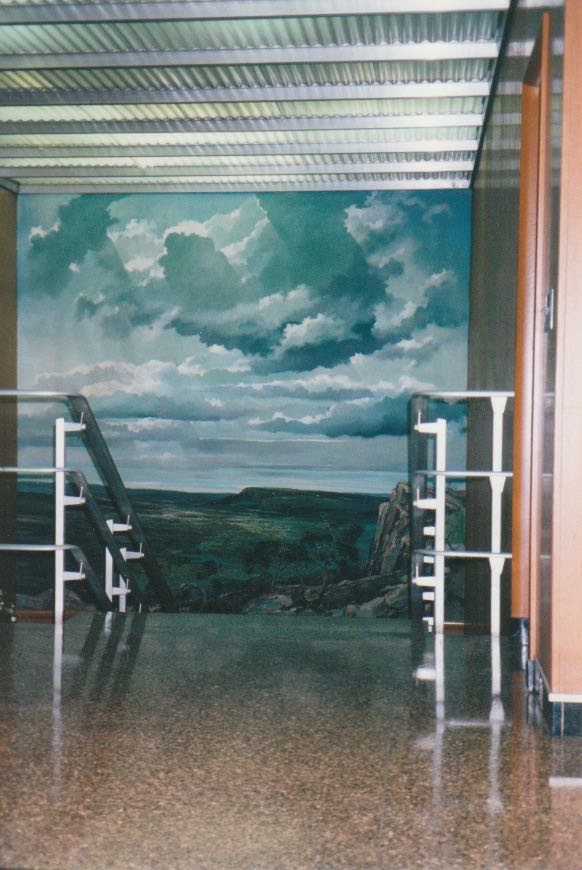
Over the course of his career, Eric Sloane painted many murals. Quite a few were in private homes, many others were in corporate settings. This photograph was taken by Wil Mauch in 1999/2000 of a Sloane mural in the headquarters of the now defunct International Silver Company in Meriden, Connecticut. From Wil Mauch’s Aware: A Retrospective of the Life and Work of Eric Sloane.
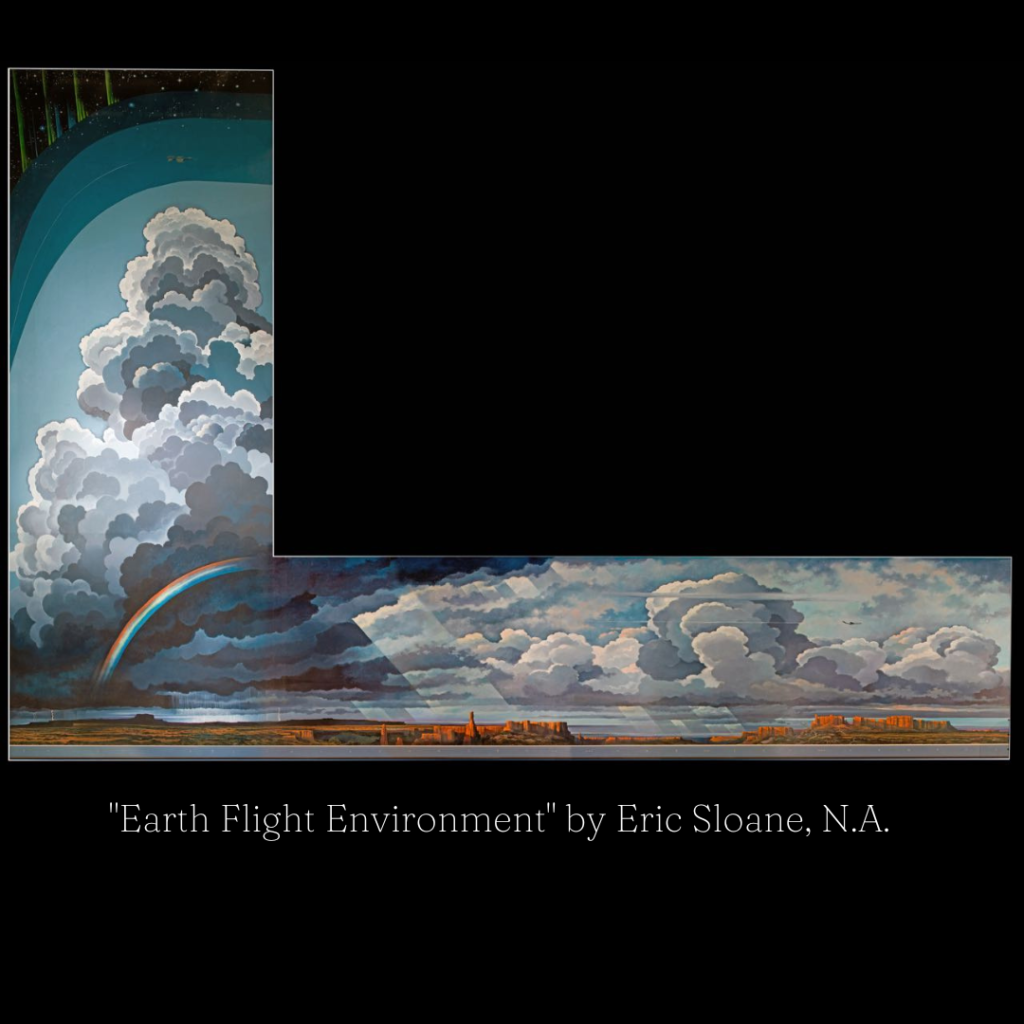
Earth Flight Environment
Eric Sloane, N.A. (1905-1985)
Acrylic on Canvas, 75′ x 58′ 6″
Affixed to the west wall of the Independence Ave. lobby of the Smithsonian Air and Space Museum. From Wil’s Symbols of American Spirit: 50 Years of the Eric Sloane Museum.
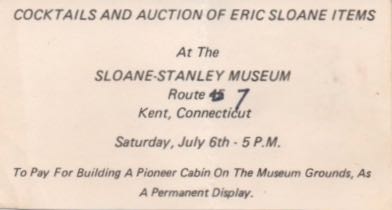
This interesting item was printed with the wrong street location for the event, we are sure much to the ire of Eric Sloane. A detail that it revealed, unknown by most, was that the money raised for the construction of the cabin was as a direct result of Eric Sloane having donated many pieces from his personal collection of antiques and tools, as well as at least one painting.
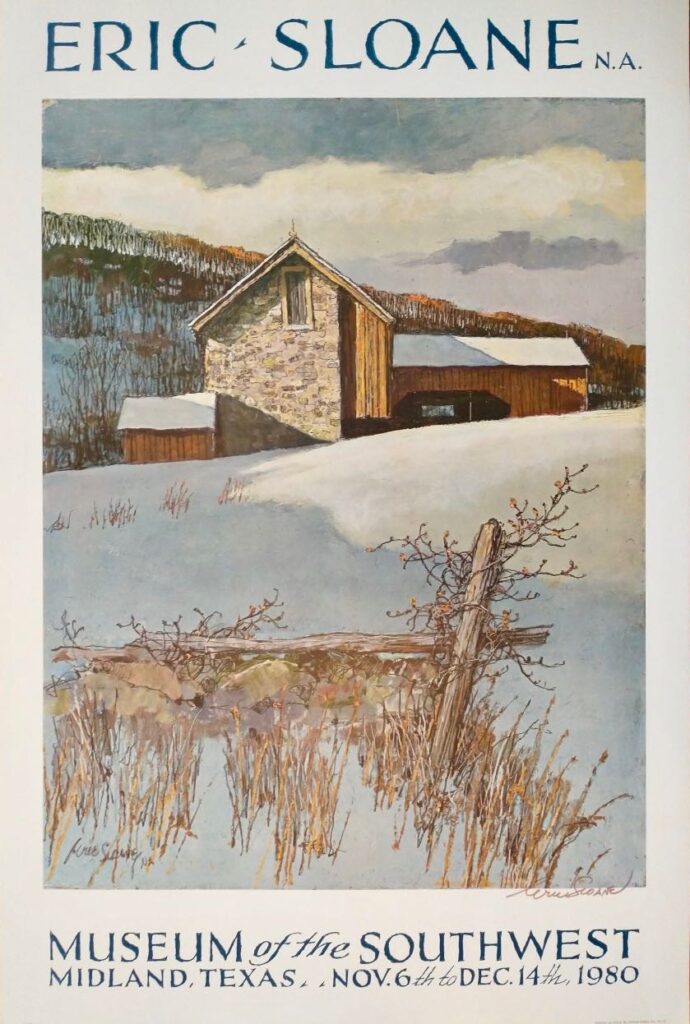
Eric Sloane’s 6 November – 14 December 1980 exhibit poster from the Museum of the Southwest in Midland, Texas.
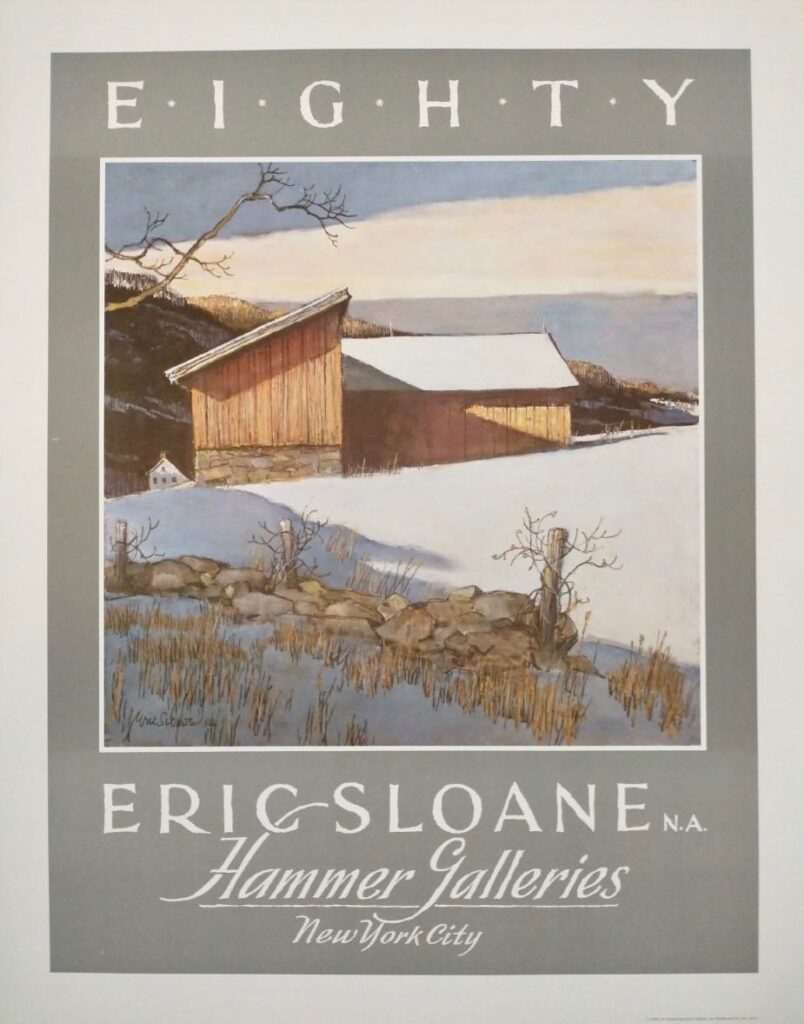
Hammer Galleries poster for “Eighty, An American Souvenir”, an exhibition and sale in celebration of Eric’s 80th birthday. The exhibit ran from March 5th-March 23rd, 1985. Tragically, Eric died on the morning the show was to open.
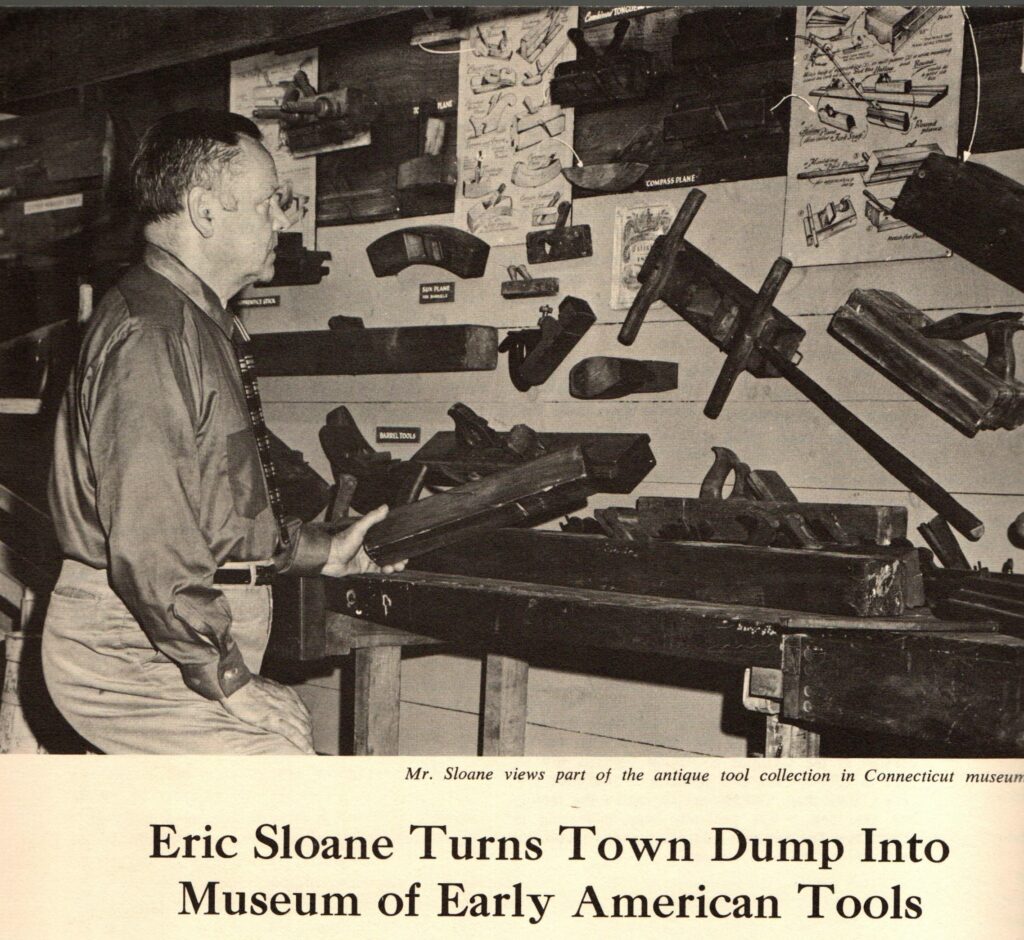
“Away back in 1969, when we first researching EAS {Early American Society, eventual publisher of Early American Life magazine}, we wrote to Mr. Sloane. In three days we had an answer. That’s a “sign” because he gets 200 letters a day! He liked the idea of EAS, but was too busy to become a part of the staff, which was what we wanted.”
Though he turned down the offer, he was crafty enough to have them write an article on the newly opened Eric Sloane Museum!
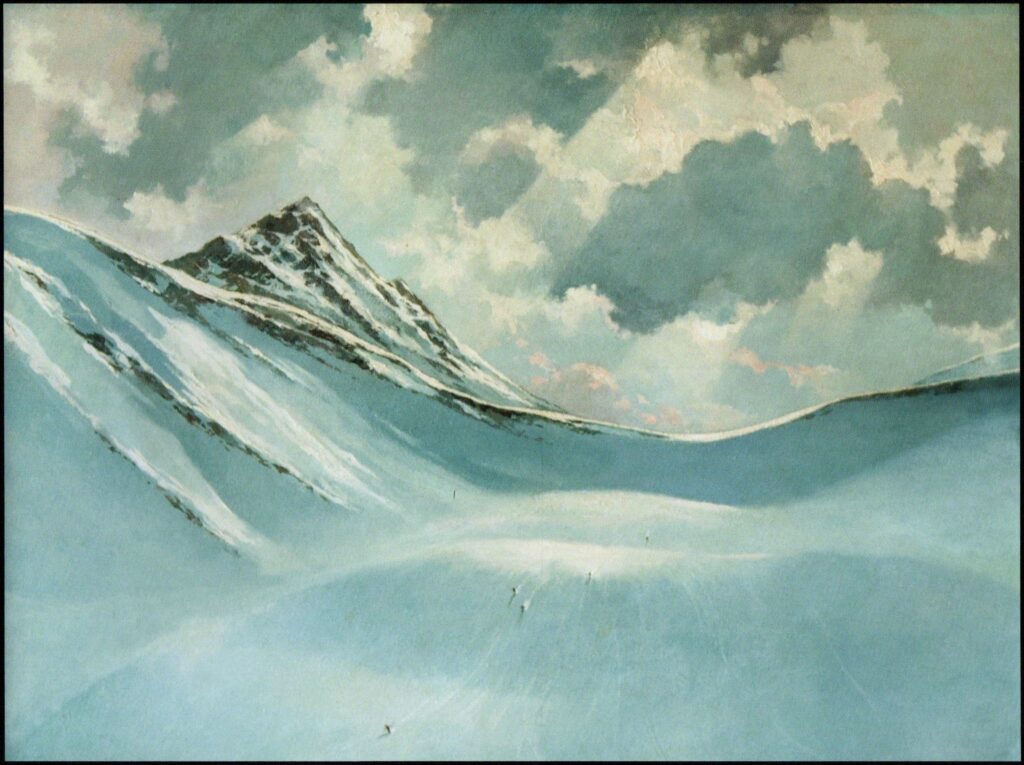
Eric Sloane, N.A.
Sunlight and Shadow
Oil on Panel
23.50″ x 31.50″
c. 1950
“Some admirers of the works of Eric Sloane are startled to discover that the artist painted more than a few ski scenes during the early 1950s. Eric’s sister Dorothy explained to me that Eric received a large, “coffee table book” in full color of scenes of Switzerland some time in the late 1940s and was captivated by photographs of the Alps. What followed, according to Dorothy, was a period in which Eric produced scenes similar to Sunlight and Shadow. Some of the paintings were set in Europe, while others were set in New England or the Rocky Mountain region of the Western United States.
It would seem as if Sloane’s fascination with painting ski scenes was short lived, probably not more than a few years at most.” – From Wil Mauch’s Symbols of American Spirit : 50 Years of the Eric Sloane Museum.
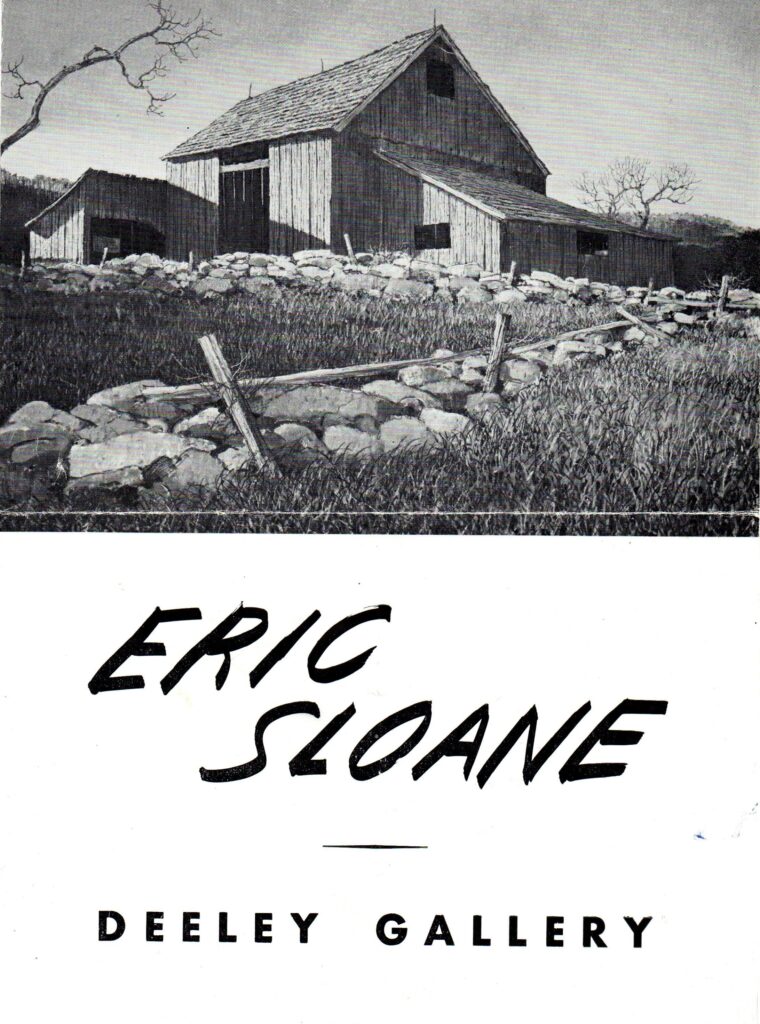
Eric Sloane – Deeley Gallery
Manchester Village, Vermont
October 1-19, 1971
To learn more about the Friends of the Eric Sloane Museum and our mission to assist in the preservation and interpretation of the Eric Sloane Museum and its collection, see www.friendsoftheericsloanemuseum.org. While you’re there, please consider making a donation online to our new hands-on classroom project.

“Away back in 1969, when we first researching EAS {Early American Society, eventual publisher of Early American Life magazine}, we wrote to Mr. Sloane. In three days we had an answer. That’s a “sign” because he gets 200 letters a day! He liked the idea of EAS, but was too busy to become a part of the staff, which was what we wanted.”
Though he turned down the offer, he was crafty enough to have them write an article on the newly opened Eric Sloane Museum!
To learn more about the Friends of the Eric Sloane Museum and our mission to assist in the preservation and interpretation of the Eric Sloane Museum and its collection, see www.friendsoftheericsloanemuseum.org. While you’re there, please consider making a donation online to our new hands-on classroom project.
Included below is an excerpt from an email I wrote recently to a new friend who wanted to know a bit more about Eric Sloane and his ski paintings. It may by of some interest to those wanting to know more about the subject:
Glad I could be of some use! Those blog videos are low, low quality – they were my daughter’s idea for the pandemic. I actually enjoyed doing them, though I’m not waiting for the Academy Award for Best Picture.
I don’t know a great deal about Eric’s “ski painting phase”, other than in my interviews with Eric’s sister Dorothy back in the late 1990s, she told me that Eric received a coffee table-type book of Switzerland from a relative who had traveled overseas. She said he was fascinated with the photographs of ski scenes found in the book, and began painting them. I do not believe his fascination was long lived, however. Every ski scene I have seen in person was painted c. 1950 – possibly as early as 1948 but I do not think much past 1952. In my opinion, he was quite good at painting alpine scenes. Partly this was due, as you pointed out, to his ability as a cloud painter. He knew to use the same palette for the clouds as he used for the landscape, as the clouds most certainly needed to reflect the color of the ground below. He also became very adept painting mountains and rock formations. He was always a little weak in his figure drawing/painting, but the perspective coupled with the snow meant that he did not have to draw feet/shoes, and so his skiers are realistic.
It’s hard to know “what happened” after about 1952. By this I mean that he never really painted ski scenes after this time period, save for one example of which I know, which showed up in a 1993 promotional poster for the United Way of Santa Fe County. Sloane died in 1985, but his widow Mimi leant the image for the use in this promotional poster. Notice it is signed “Eric Sloane, N.A.”, which is telling because that would mean it was painted after 1967. In truth, I think Eric painted the scene in the early 1980s. It may have been on commission as I do not recall ever seeing another ski scene that was painted after c. 1952 beyond this example. Back to “what happened” – in the late 1940s to early 1950s, Eric was painting a lot of “sporting scenes” – hunting scenes, specifically a lot of duck hunting scenes, scenes without the hunter(s) but in marshland/or ducks alighting from marshlands, and ski scenes. I think his reasoning was similar to that of his reasoning with painting airplane paintings 5-10 years prior – he thought pilots must have money if they owned a plane. If they had that much money, surely they would want a painting of their airplane. Pretty shrewd thinking, until Eric figured out that any excess money a pilot had was immediately dumped into the airplane. I think he applied the same logic to sporting scenes – if the wealthy of Long Island and South Eastern Connecticut had excess money to do some duck hunting or skiing on weekends, they would have money and the desire to own a painting of a sporting scene.
Two theories with some traction as to “what happened” have been floated. One school of thought is that he transitioned more into barns and covered bridges by 1952 – which is true – and left the sporting scenes behind. The second school of thought suggests that the paintings didn’t sell well, much like the airplane paintings of the early 1940s. Personally, I put more stock in the former theory and accept the latter with some modification. I’ve seen enough ski paintings to know that they were selling, and probably for Eric at that time, selling well. The problem is that I don’t think they were selling for much. Given how much time he was putting into those ski paintings (recall I did say that they were, on the whole, quite good), my theory is that yes, he was moving on to different subject matter, but part of his motivation for moving on was that he wasn’t getting as much for his sporting paintings as he thought they were worth given how much time they took to paint.
Eric Sloane Donates His Tool Collection to the State of Connecticut
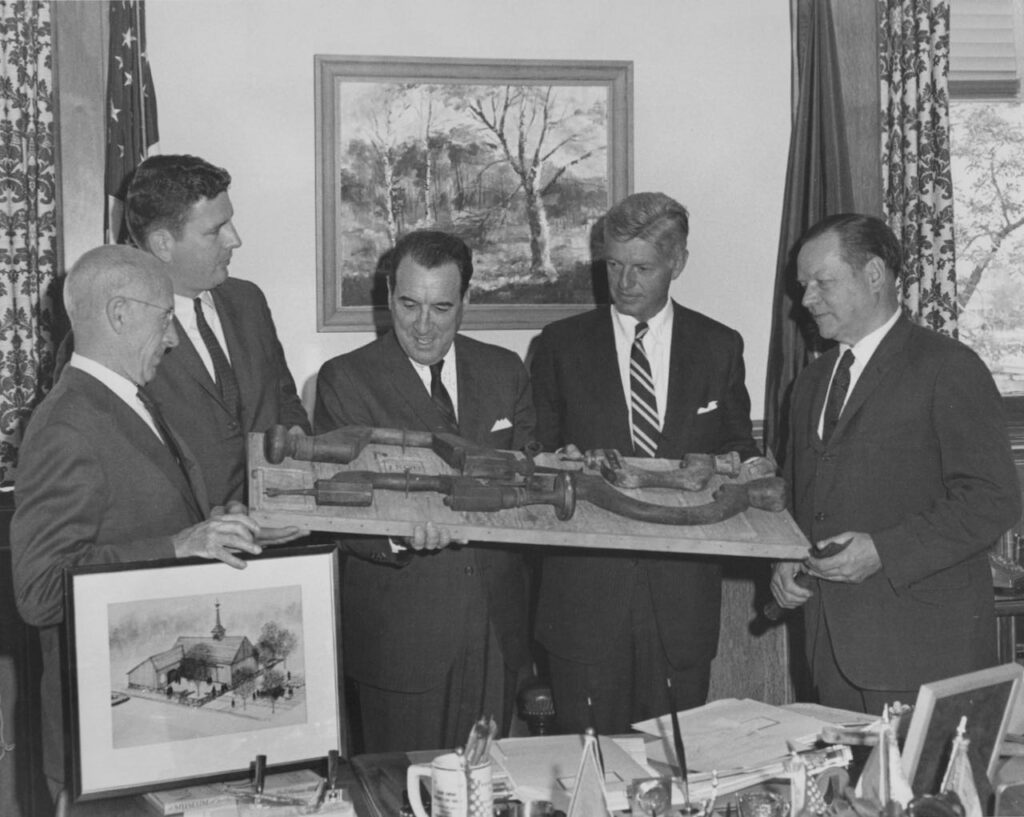
On 18 June 1968, Governor Dempsey announced that Eric Sloane would donate his early American tool collection to the state of Connecticut. Pictured, from left: Eric Hatch, chairman of the Connecticut State Historic Commission, William Tobin, First Selectman of Kent, Governor John Dempsey, Donald W. Davis, president of The Stanley Works, and Eric Sloane. The five gentlemen are holding one of Eric’s “placements”, consisting of four early braces and several early 19th century almanacs mounted to an antique barn board backing. From Wil Mauch’s “Symbols of American Spirit : 50 Years of the Eric Sloane Museum”.
Vintage Gallery postcard from Meinhard Galleries of Houston, Texas, featuring the work of Eric Sloane, N.A.:
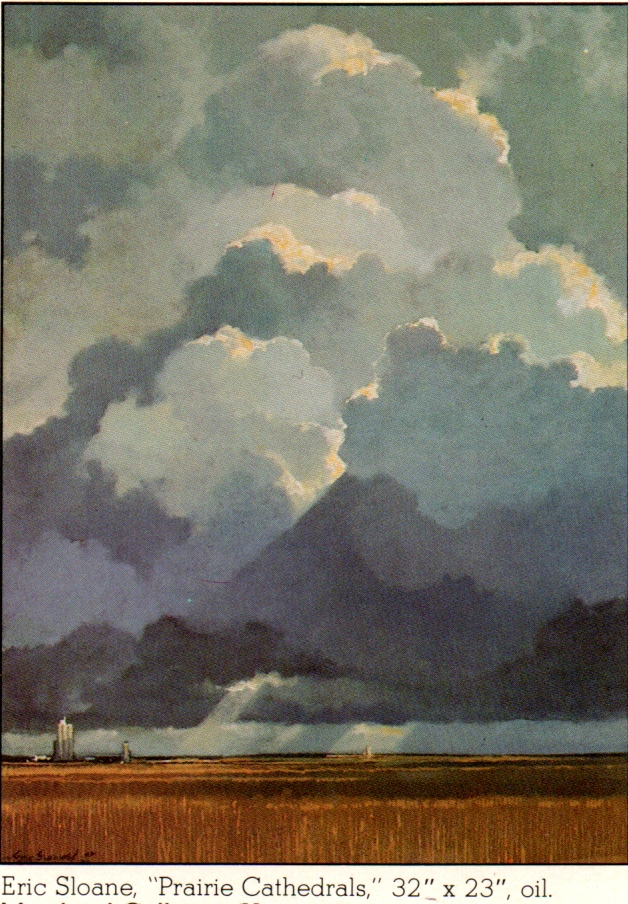
Eric Sloane in the Delano Studio Catalog
We were very fortunate recently to come across an early Delano Studios catalog, complete and in very good condition. We are excited to have a fuller understanding of the products Delano offered that featured the artwork of Eric Sloane, especially in respect to identifying new pieces that were unknown to us. We have reproduced the parts of the catalog that feature the works of Eric Sloane. As prices for these items continue to rise on the secondary market, this information may be important to those seeking to augment their collection. Enjoy!
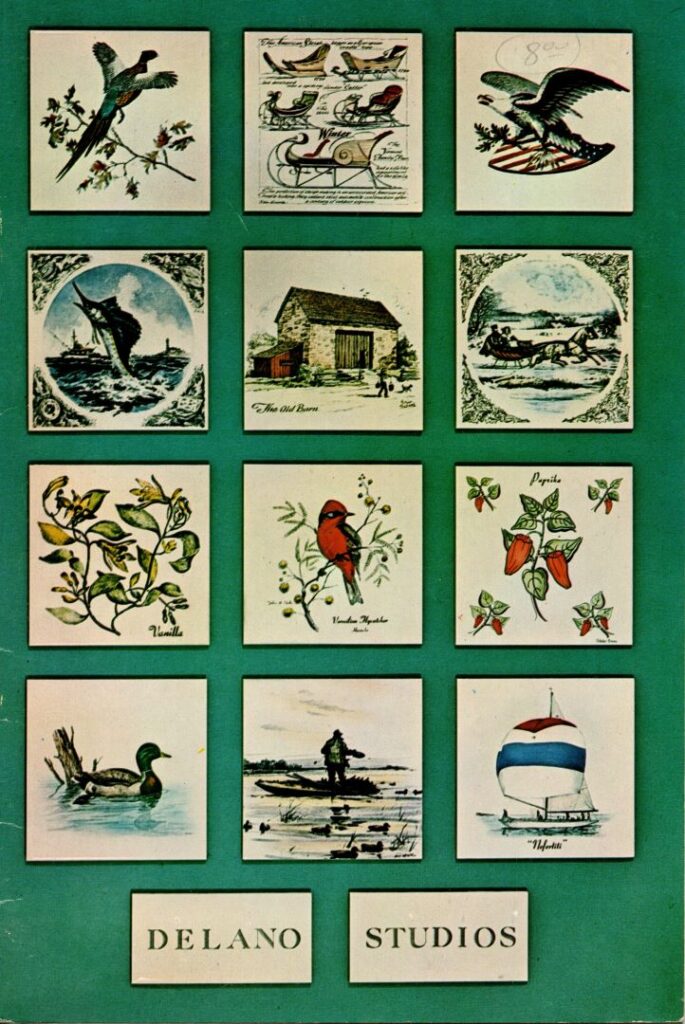
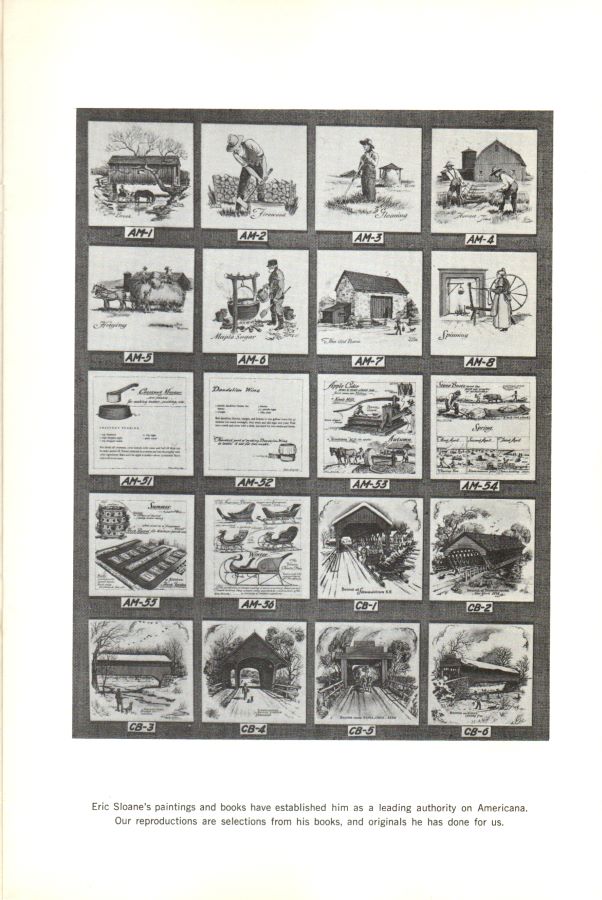
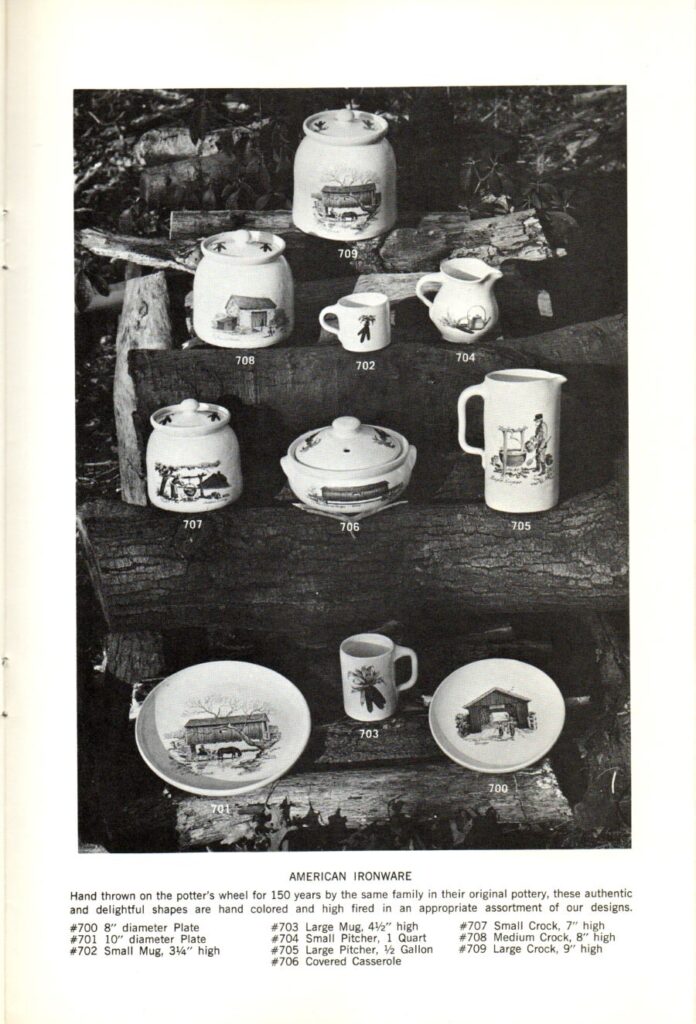
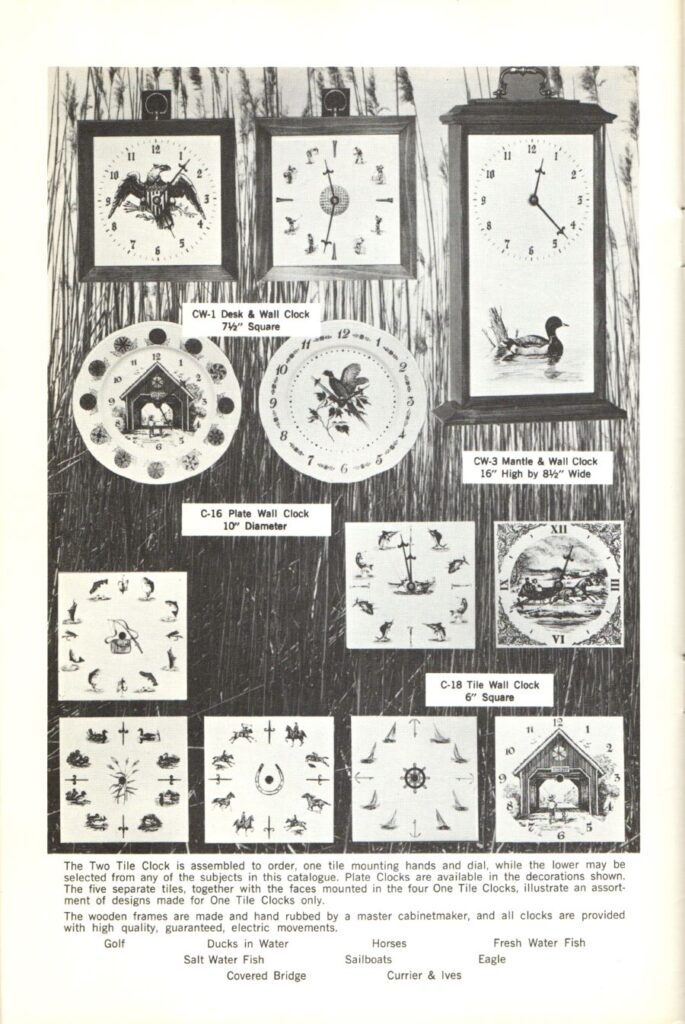
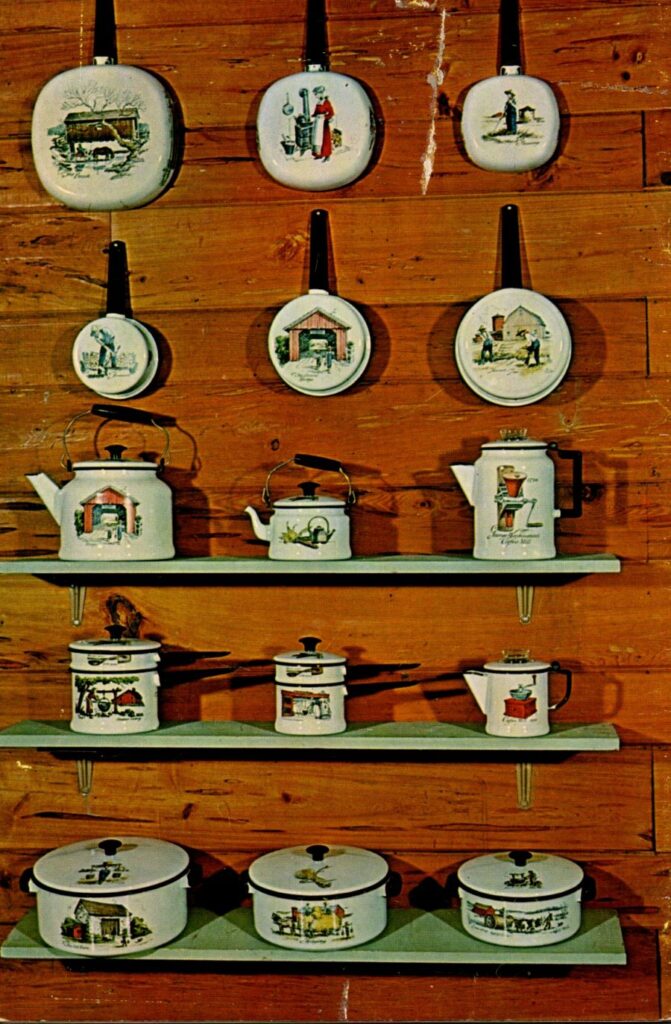
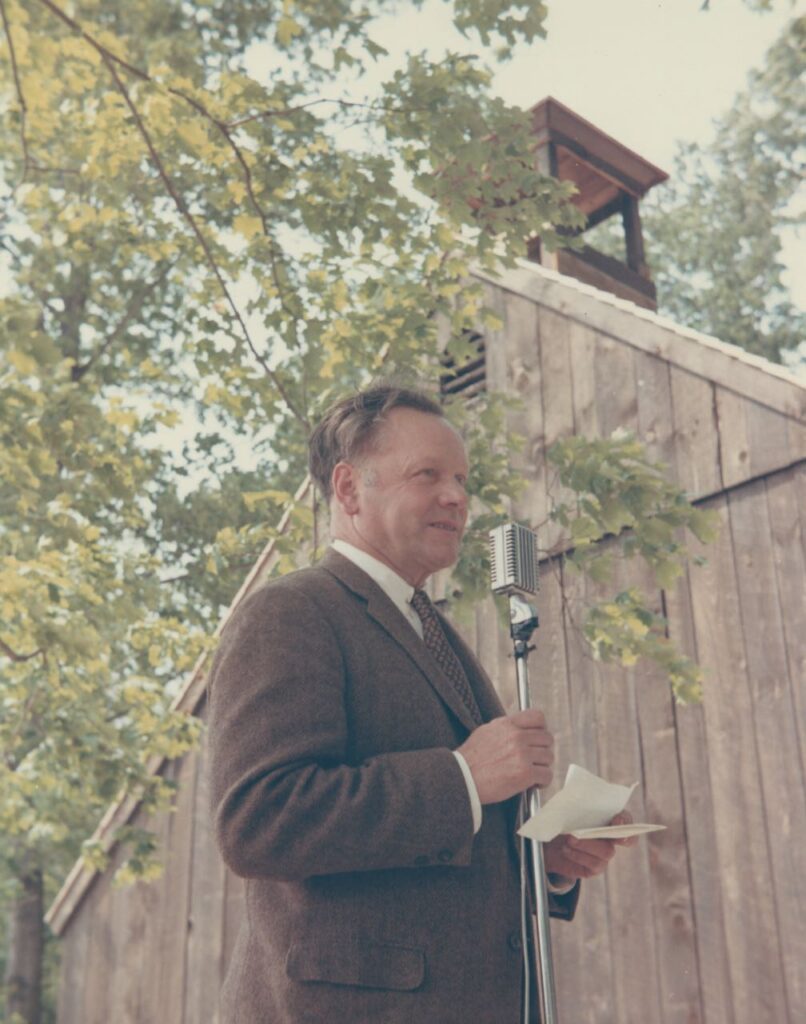
Eric Sloane addresses the crowd that has gathered at the dedication ceremonies of the opening of The Sloane-Stanley Museum and Kent Furnace on May 28, 1969.
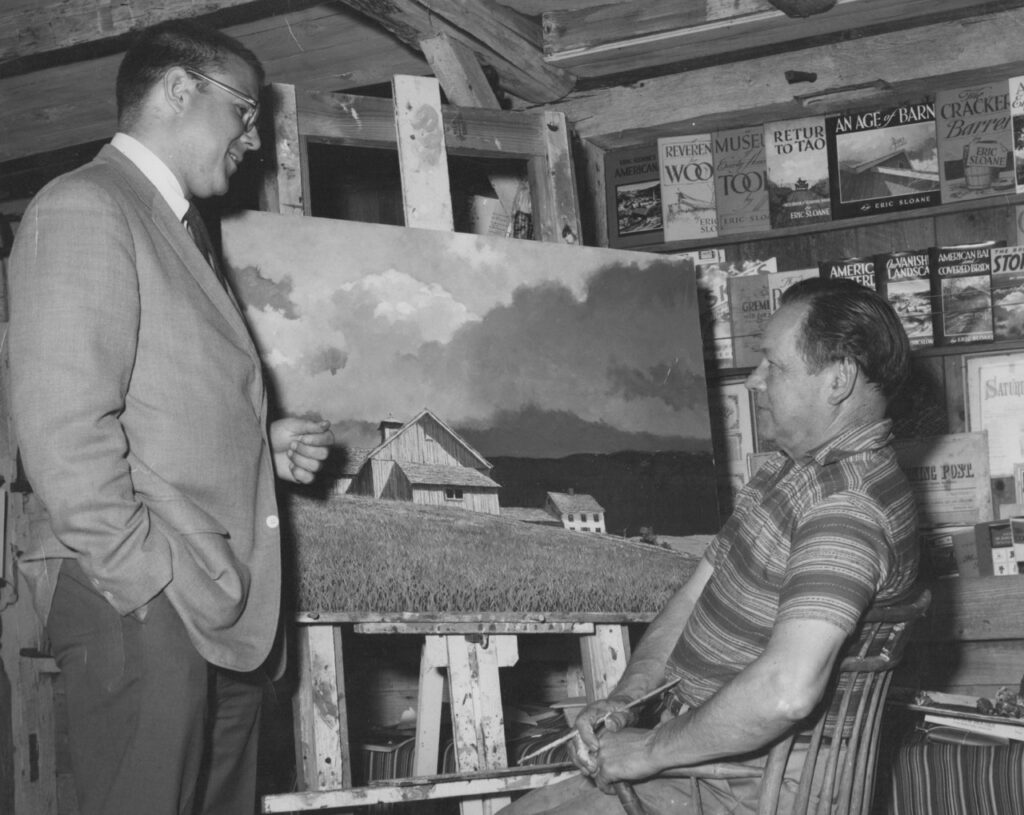
Eric Sloane at his easel discussing plans for a showing of his paintings during the 13th annual Shaker Festival at the Shaker Museum in Old Chatham, NY, with Warden Williams, the museum president at the time .

Eric Sloane in his Connecticut home. Most every home and studio took on “the Sloane look”.
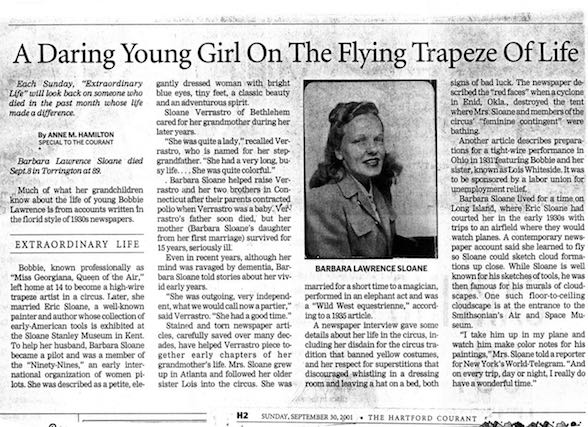
An article about Barbara Lawrence, Eric Sloane’s second wife (c.1934-c.1944). “Bobbie” must have been a fascinating woman judging by this article. She became a pilot at the behest of Sloane, a member of the “Ninety Nines”, and probably “Pilot 54566, wife of the author” in Gremlin Americans: A Scrap Book of American Gremlins (1943 B.F. Jay & Co.).
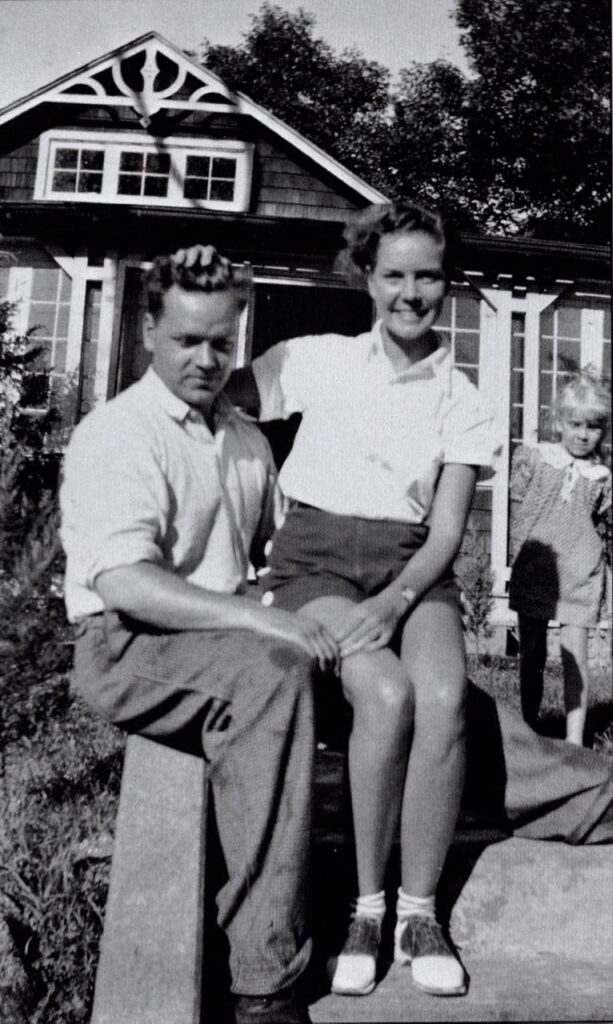
Eric Sloane and his sister Dorothy at Cedarcrest, the Hinrichs’ summer home on Lake Hopatcong, New Jersey. Taken in 1935, Barbara Lawrence’s daughter “Little Bobbie”, is pictured in the background.
A good overview of the significance of Eric Sloane and his art, as well as of The Eric Sloane Museum. Our own Wil Mauch was one of the contributors to this documentary.
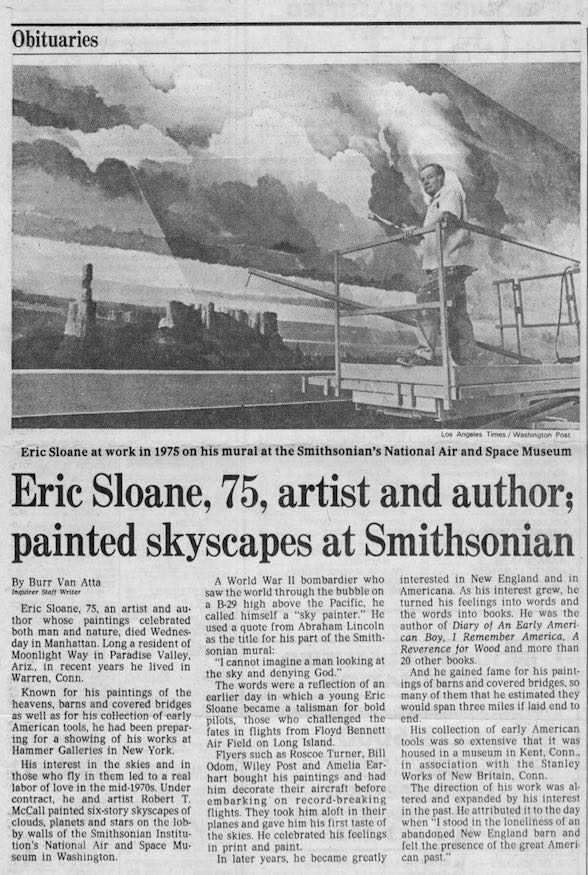
Another obituary for Eric Sloane, this one reporting the artist’s age at the time of his death as 75, which is of course incorrect.
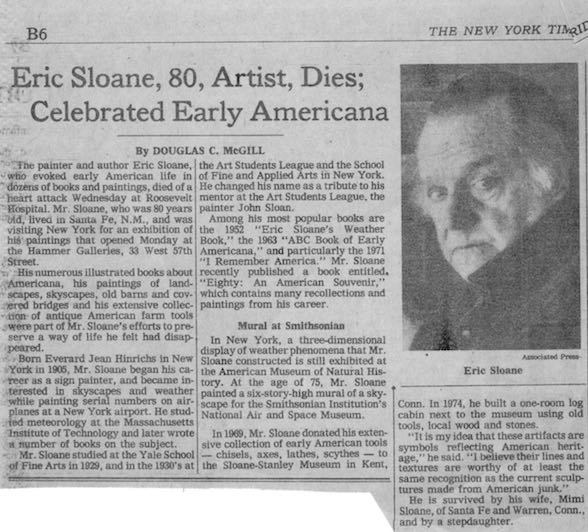
New York Times obituary for Eric Sloane, March 8, 1985.
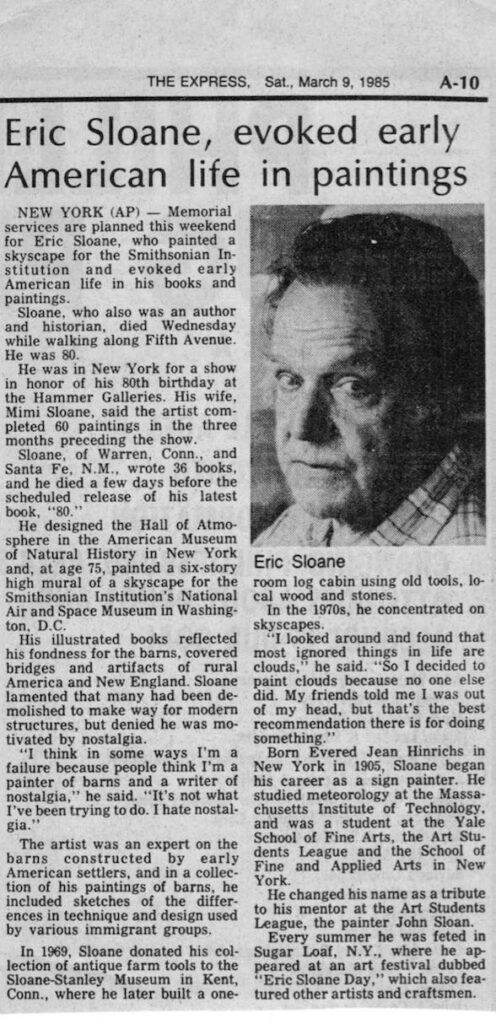
March 9, 1985 obituary for Eric Sloane
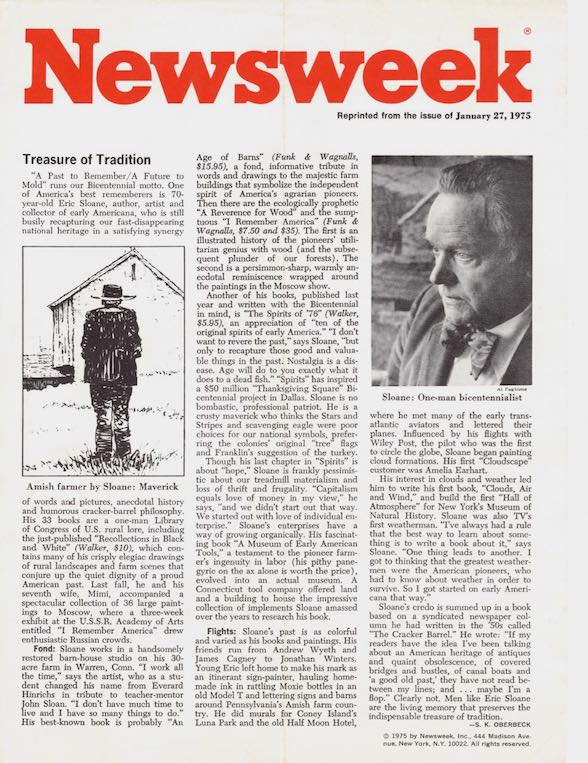
1975 Newsweek article about Eric Sloane
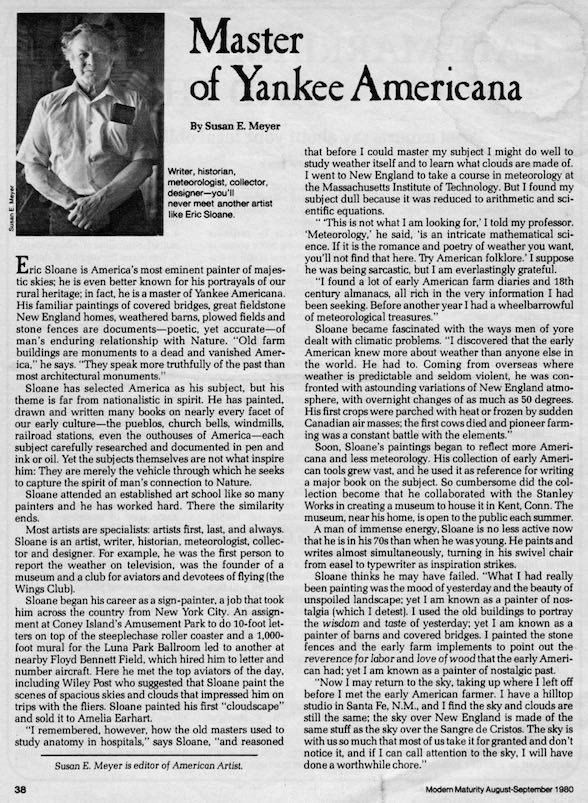
Eric Sloane: Master of Yankee Americana, by Susan E. Meyer For Modern Maturity Magazine’s August-September 1980 issue. Meyer was then the editor of American Artist magazine. It was she, along with her husband Ken, who produced the Profiles in American Art series, one episode dedicated to Eric Sloane.
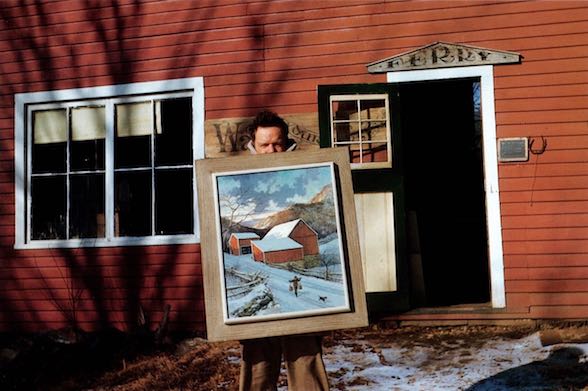
Eric Sloane behind a recently completed oil painting. Likely taken in the winter/early spring of 1957/58. It is the painting that appears on page 111 of The Seasons of America Past by Eric Sloane (1958, Wilfred Funk, Inc., though the dustjacket spine indicates “Funk & Wagnalls”).
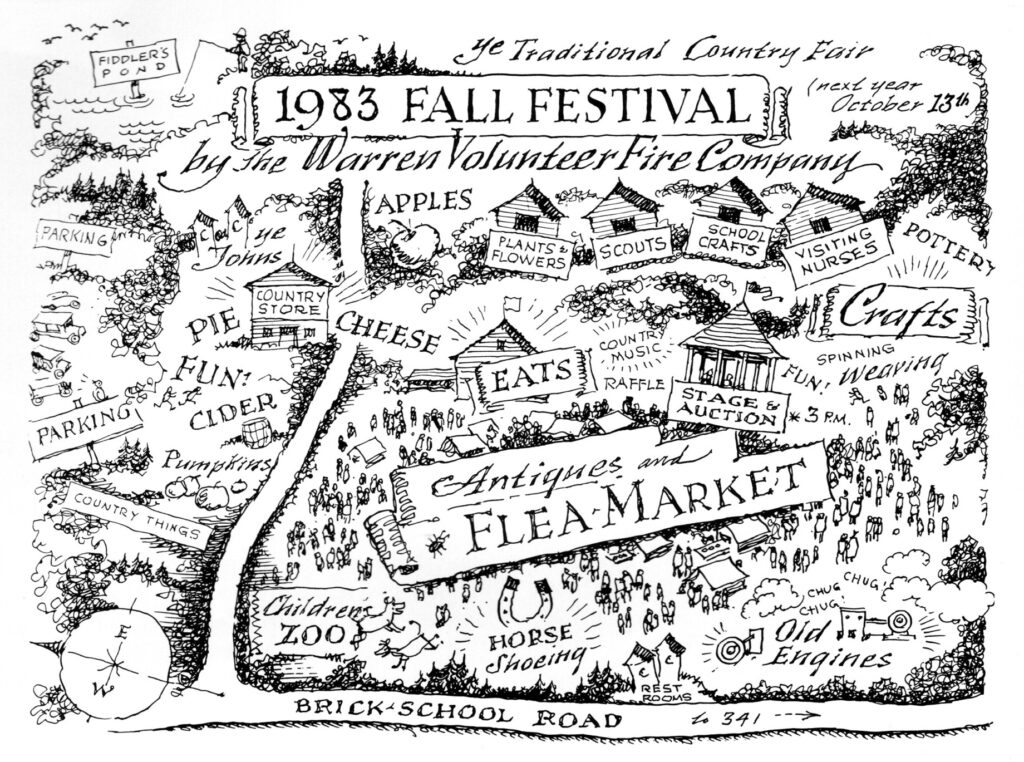
Eric Sloane gave generously to many charitable organizations over the years. Sloane is credited with starting the Warren Fall Festival, to which he donated several paintings annually to be auctioned in support of the Warren Volunteer Fire Company. In the autumn of 1984, the last year in which Eric Sloane participated, the festival earned $17,000, $9,000 of which came from the sale of two of the artist’s paintings.
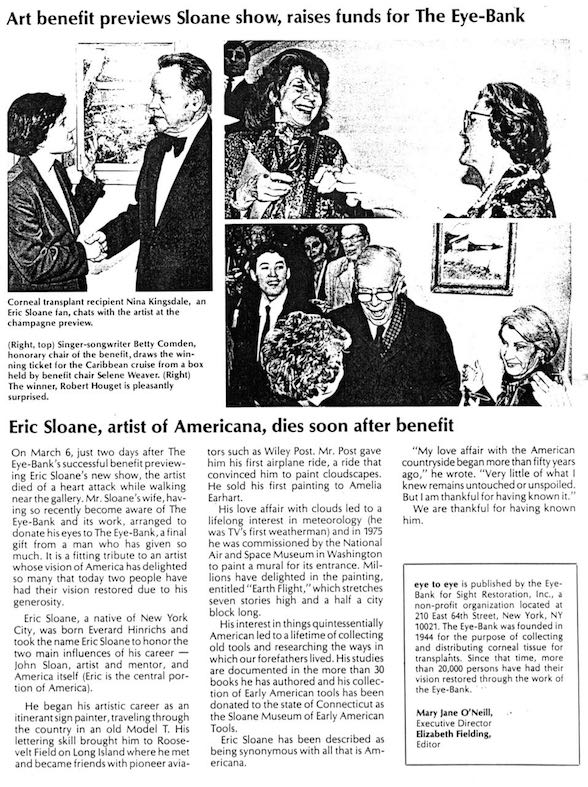
“We are thankful for having known him”. The Eye-Bank for Sight Restoration was another charitable cause Eric Sloane steadfastly supported.
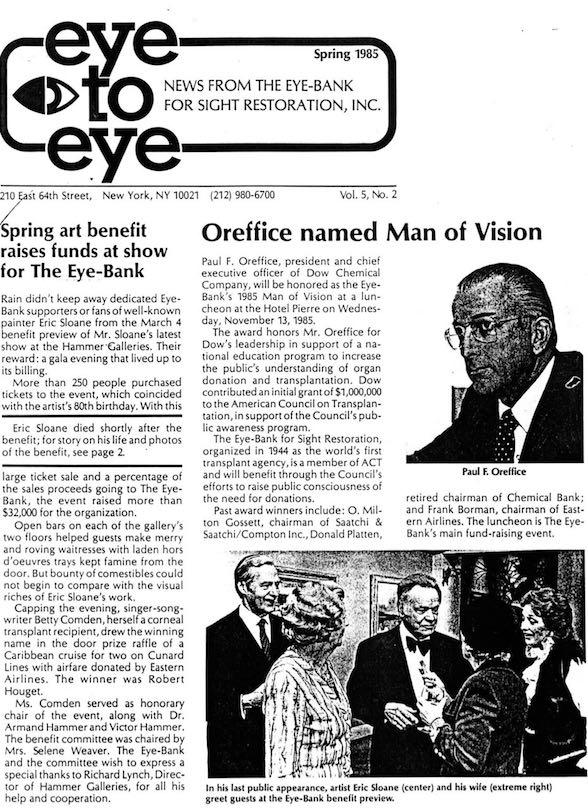
Ticket sales for the opening gala held on March 4, 1985, coupled with a percentage of the sales proceeds of Eric Sloane’s paintings, resulted in more than $32,000 raised for The Eye Bank For Sight Restoration. What would be Eric Sloane’s final exhibition – entitled Eighty – opened at Hammer Galleries in New York City on March 5, 1985. Eric Sloane died March the 6th.
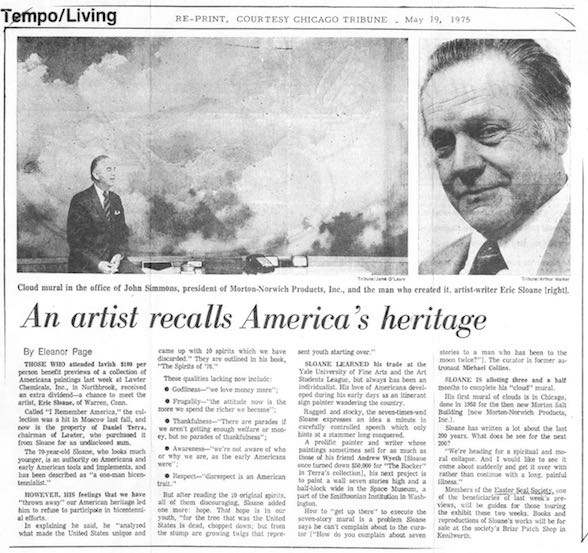
Eric Sloane – An Artist Recalls America’s Heritage. Chicago Tribune, May 19, 1975. Interestingly, this article includes a prominent photo of the cloud mural Eric Sloane created for the president of Morton-Norwich Products, Inc. Eric includes a photograph of the mural, and writes this in his section entitled “Three Hours” in Eighty:
“I find that it takes about three hours for me to shape out a painting composition at which point I like to leave it for drying and continuing the next day. Sometimes the three hours are enough, like the office mural above which I did many years ago for the new Morton Salt building in Chicago. I started at nine in the morning and at noon had the good sense to realize further work would add nothing and so I finished at noon. When the president arrived at one o’clock to “watch me work” I was on a plane heading back home”.
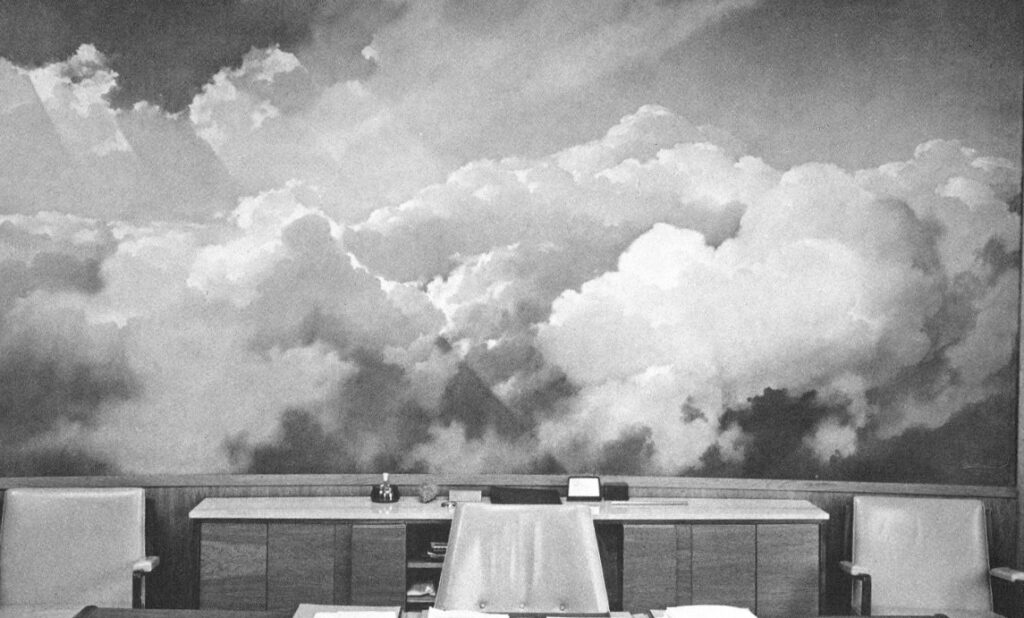
Above: The Morton Salt Building Mural in a 1958 Chicago Tribune Press Photo
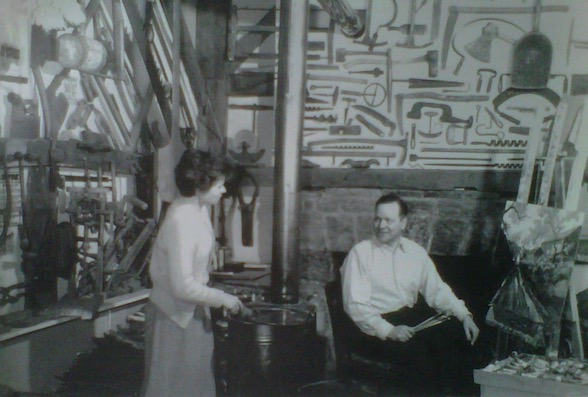
Eric Sloane, pictured at right, his wife at the time (1958), Ruth, pictured at left. This was taken around the same time as the two photos that appear below, as well as the photo of Sloane that appears on the rear dustjacket of The Seasons of America Past, which is the second photograph included in this collection.
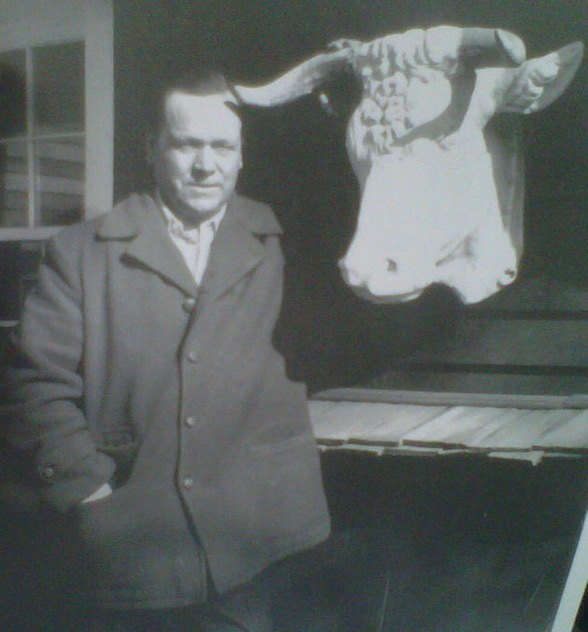
Eric Sloane outside of his studio, 1958.
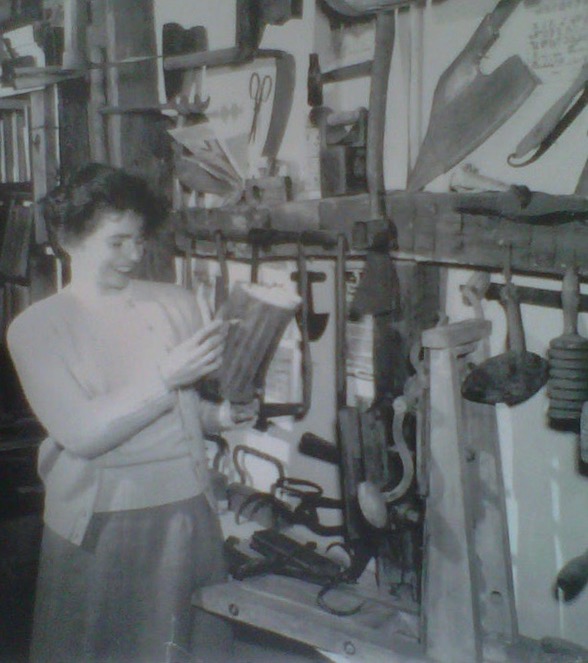
Eric Sloane’s wife Ruth inside the artist’s studio in 1958, part of a number of publicity photos taken prior to the release of Eric Sloane’s The Seasons of America Past.
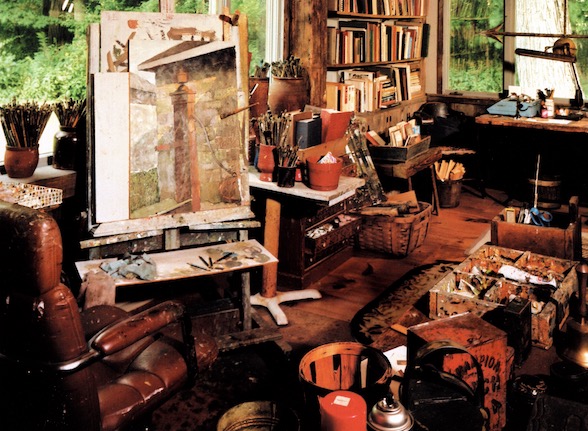
A recreation of Eric Sloane’s Warren, Connecticut studio, housed in the Eric Sloane Museum of Kent, Connecticut.
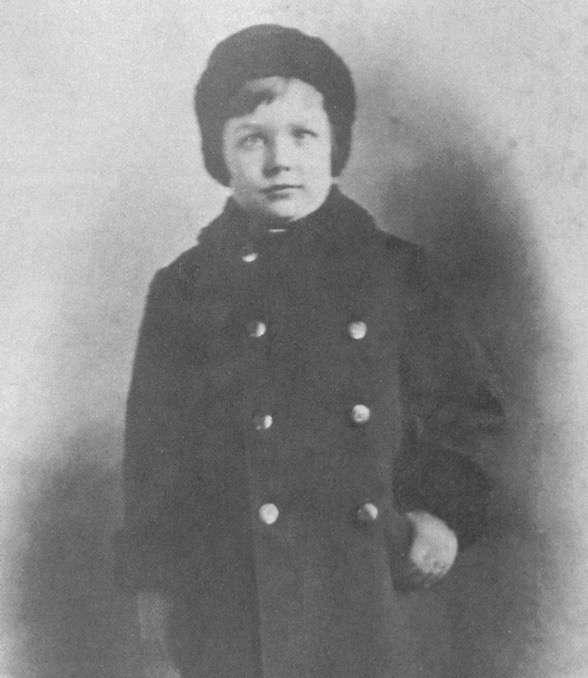
Everard Hinrichs – who would become Eric Sloane – c. 1912
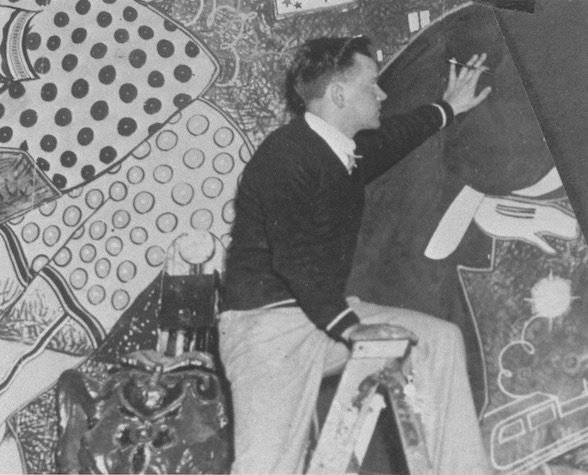
Eric Sloane at work painting a mural in the Luna Park Ballroom of Coney Island. It was this mural that caught the attention of David Martin, manager of the Half Moon Hotel.
We’re a bit excited this week at Weather Hill Farm, as we may have tracked down some missing pieces to a mystery surrounding Eric Sloane. In a small number of his books, Eric referred to developing the first “Hall of Atmosphere” at the Museum of Natural History in New York City. Though Sloane provided some details, the story remained more lore than fact. As Sloane described it in Eighty: An American Souvenir:
I thought I might find meteorological material in the American Museum of Natural History in New York, but they had nothing there about the atmosphere. “What you are really looking for,” they told me, “is a museum of aviation – not a museum of natural history.” They didn’t seem to realize that natural history only exists in atmosphere! “There’s no natural history on the moon,: I explained, “because there isn’t any atmosphere there.” Finally, they seemed anxious to get rid of me. “You may be right,” they said, “but at the present time we haven’t enough money to start a hall of weather. Come back with a donor some day and we’ll consider it.” I assured them I would do so.
Within a week I returned with a donor (William P. Willets) (sic) who wanted to donate a memorial for his Navy son, who had been killed in an air accident (Editor’s note – please see Wil’s passage from Symbols of American Spirit, below). We used Bill’s handball court as a factory, and I began working on glass-encased, three dimensional models of clouds, cold fronts, warm fronts, hurricanes, and all the phenomena of weather. With blue lights for descending cool air and red lights for ascending warm air. I invented atmospheric movements by little fans over light bulbs (like those that imitate moving flames in artificial fireplaces). It became the first Hall of Atmosphere in any museum.
Trouble is that no one could find a record of a “Hall of Atmosphere” at the American Museum of Natural History. A tantalizing clue came in the form of this image, below, as a result of Wil’s research for his 2001 biography of Eric Sloane. A photographic positive of one of Eric Sloane’s three dimensional models demonstrating weather phenomenon, this one of a line of cumulous clouds that have developed into menacing, anvil-topped masses. It even sports the “Airology” moniker.
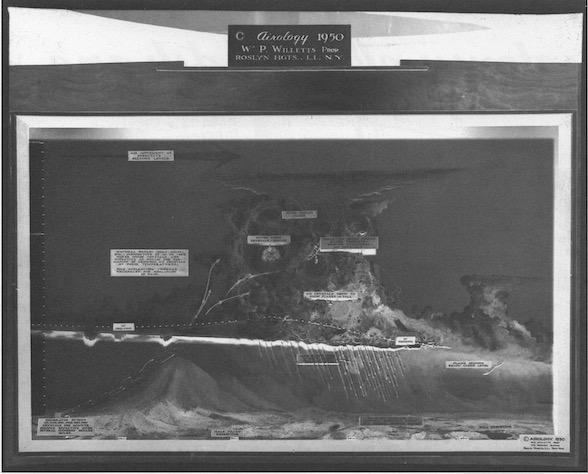
As an aside – though perhaps a germane one given that this thread started with a mystery about whether or not there existed a “Hall of Atmosphere” at the American Museum of Natural History, Sloane claims on the very same page as the quote copied verbatim above that he never liked the word meteorology, “…so I coined the word Airology and a new word was born. It was even copyrighted when my Long Island studio was called “Airology Inc.”. Not quite. As early as 1940 (and perhaps earlier), the United States Navy was using the term Aerology to describe what we would today call meteorology. In fact, the Navy published a number of training manuals for pilots with aerology in the titles, descriptions, and text. Given Sloane’s work with the Army Air Corps pilot training programs, as well as his civilian publications Clouds, Air, and Wind and Gremlins, it is difficult to believe that Sloane was unaware that the U.S. Navy referred to meteorology for pilots as “Aerology”. Perhaps the change of “e” in Aerology to the letter “i” made the name, for Sloane anyway, a new term.
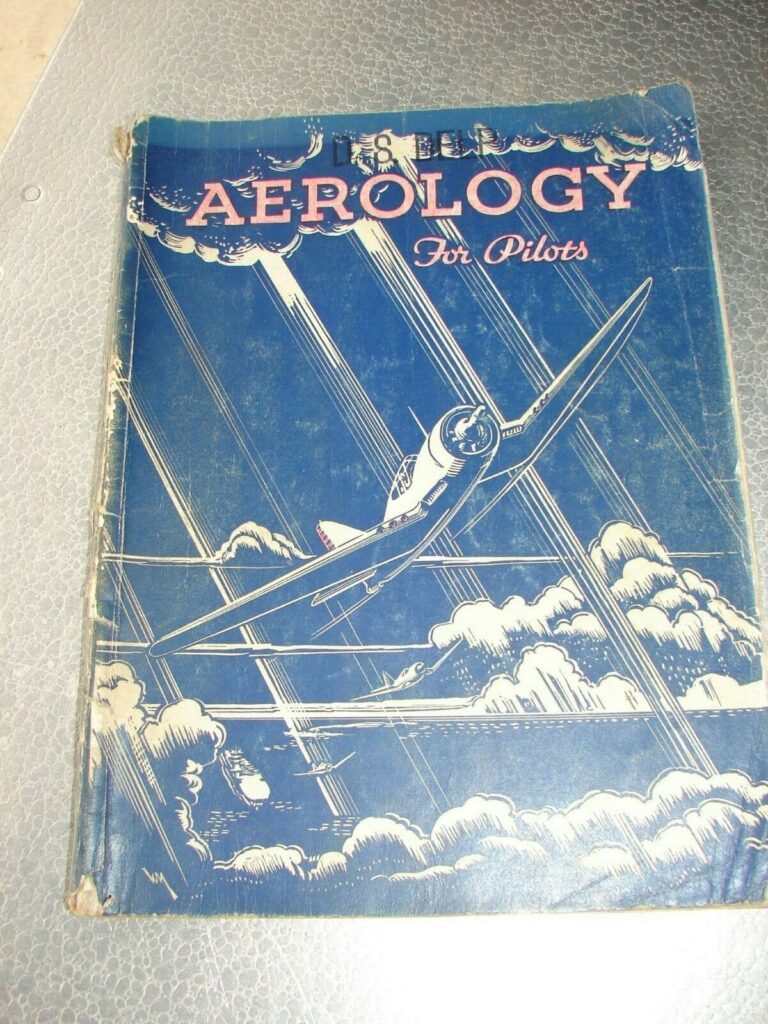
Back to the models Sloane created. The origins of these models was described by Wil Mauch in his Symbols of American Spirit: 50 Years of the Eric Sloane Museum:
“During the Second World War, Sloane took a hiatus from writing and painting after an acquaintance’s son, Joseph Prentice Willetts, was killed in an aviation accident on 18 August 1943. The accident was horrific. Willetts was piloting a Martin PBM 3c on a friendly submarine hunting mission and in heavy weather 12 miles off Montauk Point when the plane struck swells that were reportedly 15′-20′ in height. The plane exploded and sunk in 160′ of water, killing the Navy pilot, his co-pilot, nine crewmembers and 1 passenger. Understandably, the accident affected deeply Joseph’s parents, who reached out to Eric Sloane in hopes that he could both memorialize their son and to better educate pilots as to the dangers of flying in poor weather. The result was the Willetts Memorial, several working models of weather phenomenon constructed by Sloane in a converted squash court in the Willett’s Roselyn Heights home. The models were exhibited at the American Museum of Natural History in New York.”
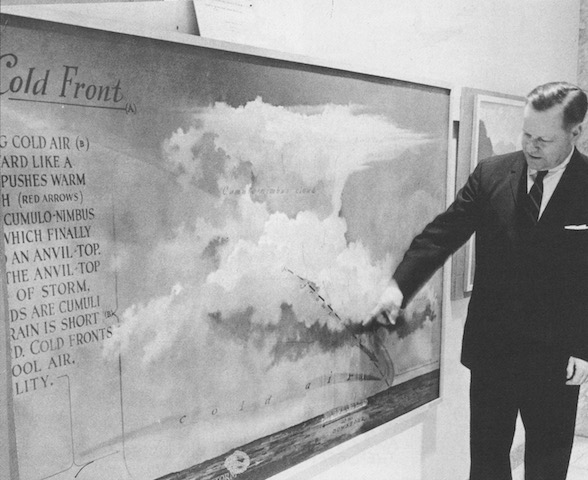
This interesting photograph shows Eric Sloane explaining portions of a large mural of a cold front. The location is not noted, but the image is suggestive of a press photo. It could be Eric at the the 1946 opening of the Willetts memorial at Hayden Planetarium.
We now have direct evidence that Sloane’s models were technically displayed at the American Museum of Natural History. The Hall of Atmosphere – though we do have evidence to the contrary that it was not named so – opened in December of 1946 and we now know that it was still an exhibit as late as 1951. It was not installed in the American Museum of Natural History’s main building, but rather in the museum’s Hayden Planetarium. Here is a 1951photograph of the center of the Hall, Eric Sloane’s three dimensional models can be seen in the background:
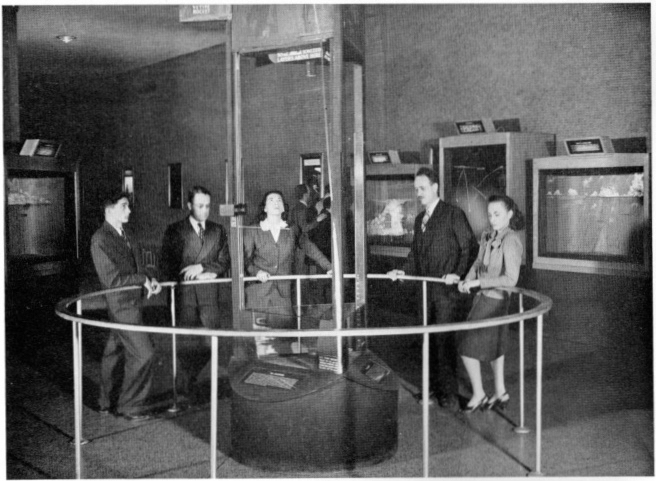
And photographs of all of the models that were on display in 1951 appear below. One interesting aspect is the Airology logo and date (or absence of one) on these models. On the one pictured above, Airology appears in a different font than the ones below and also clearly indicates a copyright date of 1950. The first two models, below, show the different font type used in the Airology copyright and do not show a date. The third model’s font correspond to the first two, yet it includes a copyright date of 1948. This may be explained by the longevity of the exhibit and the lack of longevity of the models (Sloane himself alluded to their frail nature). Some of the original 1945/6 models may have needed replacement or the exhibit needed some augmentation by 1948. 1950 may have been the next point in the “maintenance cycle”. 1950 also seems significant in the life of these murals and the exhibit as we now know that it was in that year that a recorded voice feature explained the models “…in accurate but non-technical language”. It would seem as if there was a significant refurbishment in 1950 with the addition of the recorded explanations and new(?), updated models from “Airology, Inc.” as indicated by the 1950 copyright date.
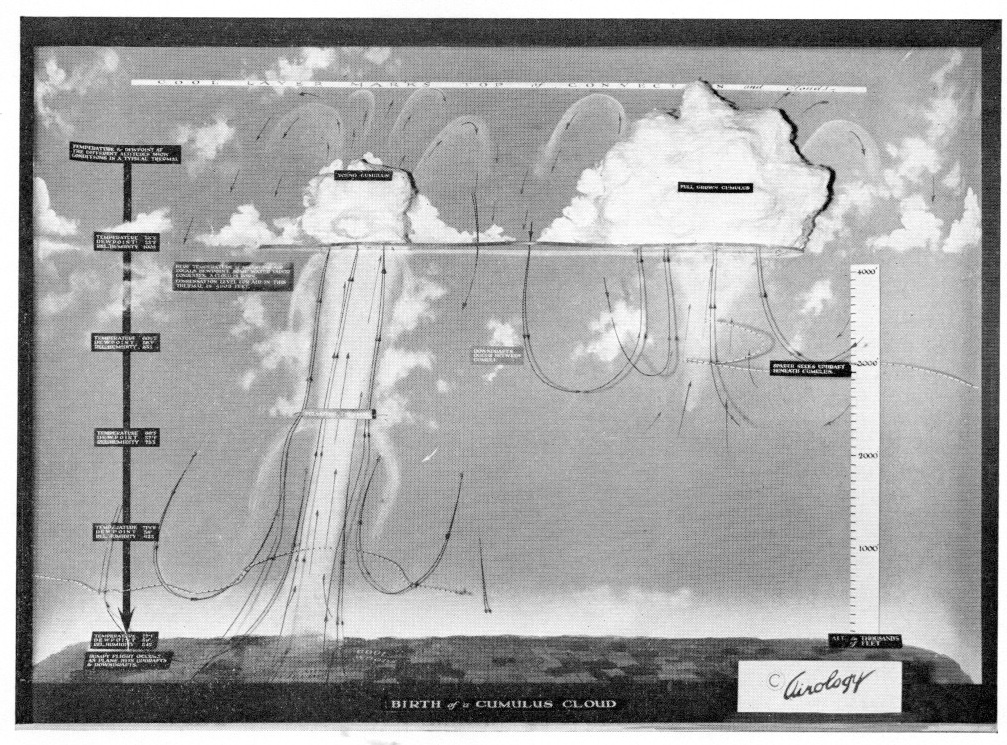
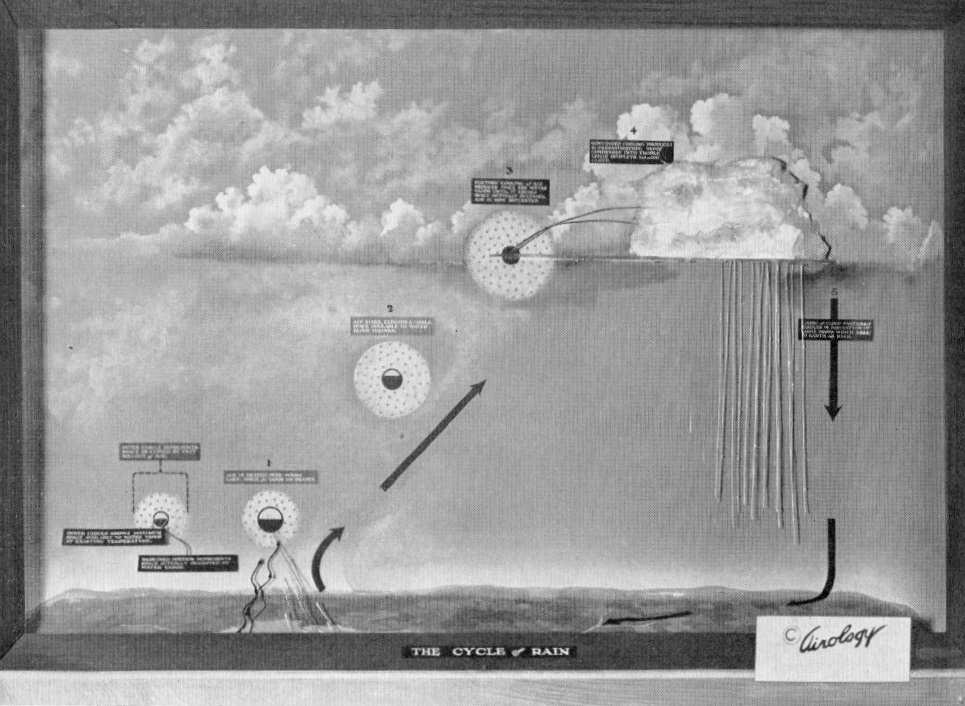
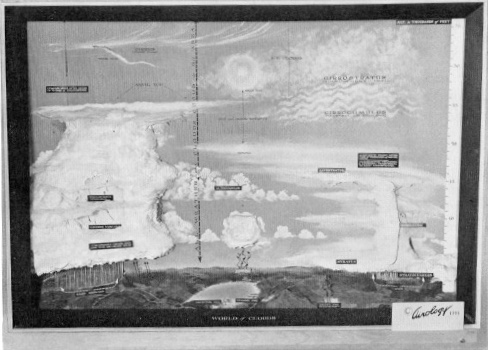
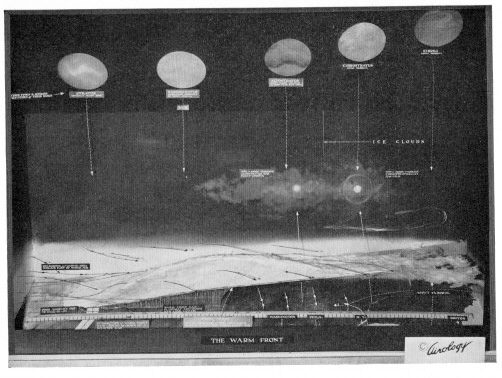
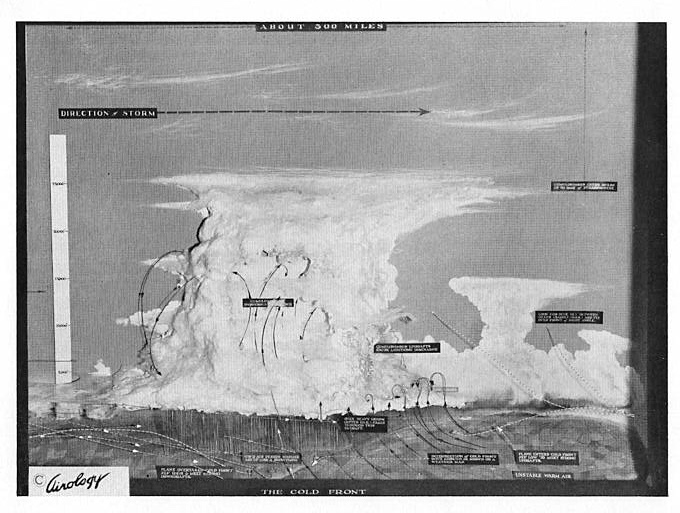
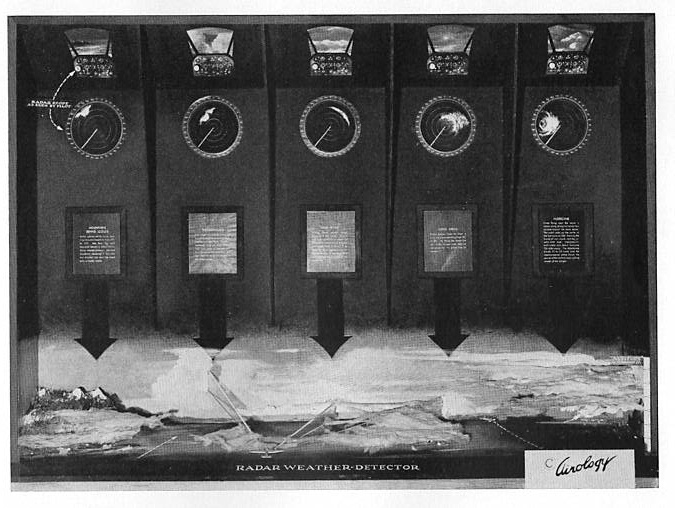
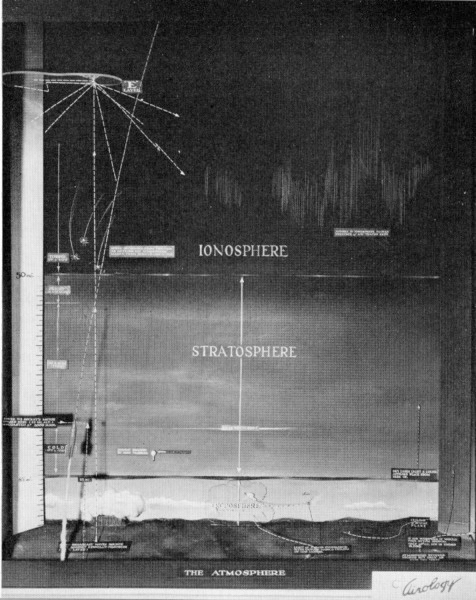
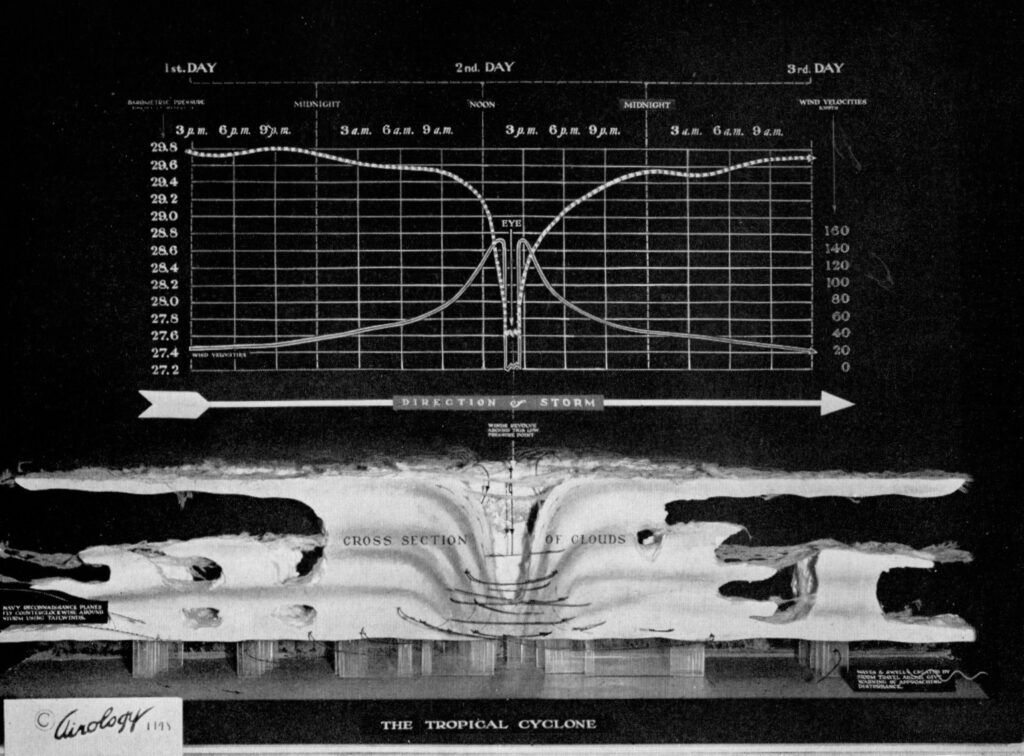
Lest we forget the man for whom the memorial was created, Joseph Prentice Willetts (September 30, 1918 – August 18, 1943).
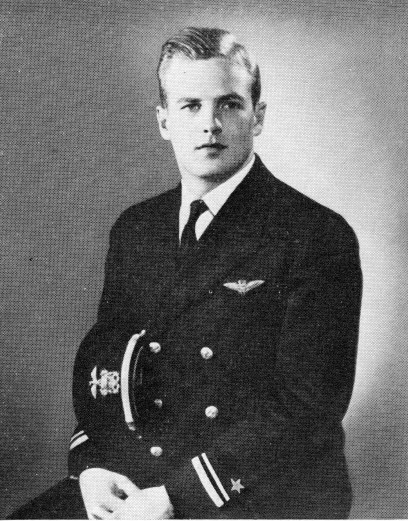
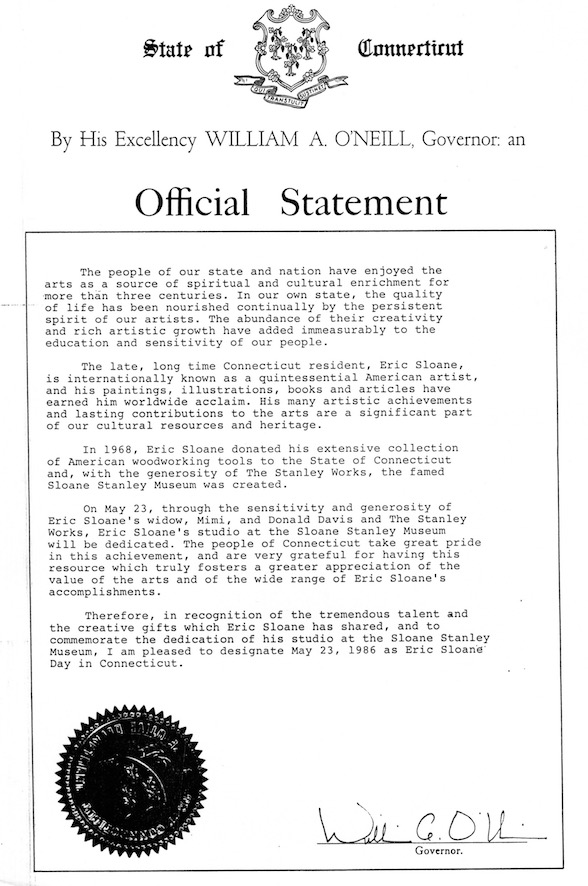
The official proclamation issued by Connecticut Governor William A. O’Neill designating May 23, 1986 as “Eric Sloane Day” in Connecticut. The day was chosen as it was that Eric Sloane’s replicated studio was dedicated at the Eric Sloane Museum.
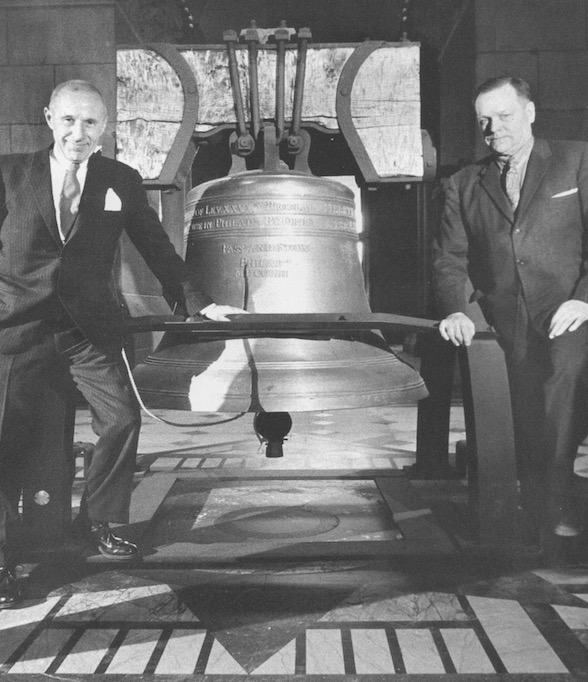
Eric Hatch, left, and Eric Sloane, right, photographed with the Liberty Bell in Philadelphia. Most likely a publicity photo for either Eric Sloane’s 1966 The Sound of Bells, or Eric Hatch’s 1964 The Little Book of Bells.
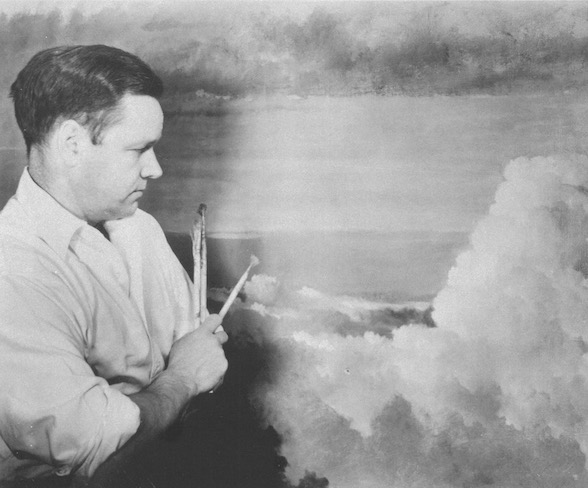
Eric Sloane, painter of cloudscapes, a term he apparently coined.
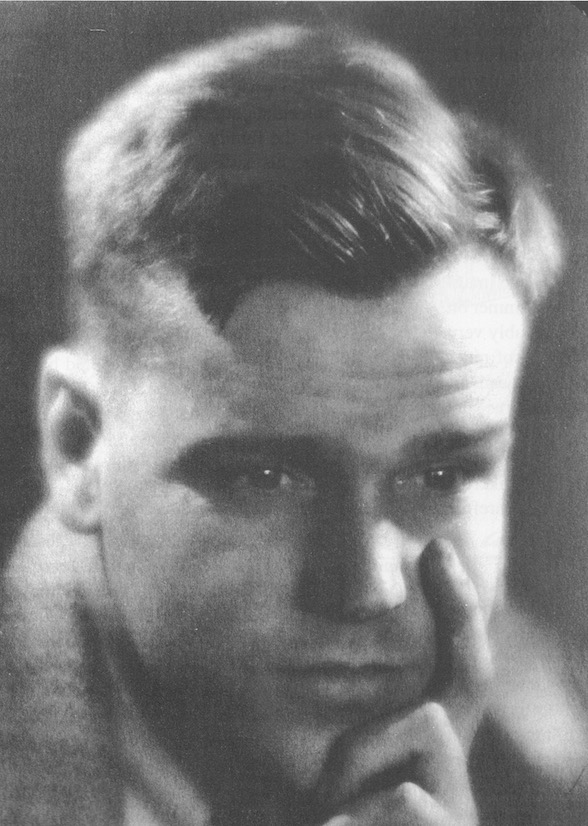
Eric Sloane, c. 1925
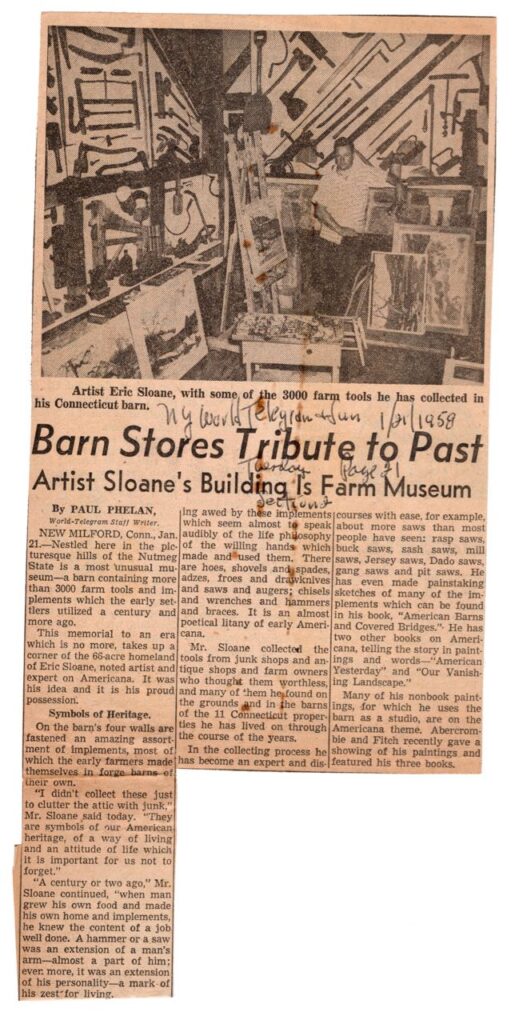
A 1958 article on Eric Sloane, highlighting his early American tool collection. Some of what is pictured became the nucleus for the Eric Sloane Museum in Kent, Connecticut. Exactly when the idea for a museum of early American tools was formed is lost to history, but it is telling that Eric titled his 1964 book on the subject A Museum of Early American Tools (Funk and Wagnalls).

Wil Mauch took this photograph, above, and the two that appear below, on a visit to the newly renovated and expanded Cradle of Aviation Museum in 2002. The museum was in possession of what was once a wall of the pilot’s lounge at Roosevelt Field. Upon this wall is a mural painted by Eric Sloane. Eric painted directly on the wall’s plaster surface. You can still see the studs attached to the lower section of the wall where the mural was cut in the image below, and the lath in the image just below this one:

Pictured above is Eric Sloane’s fifth wife Ruth Hinrichs, who was invited to the museum to see their latest acquisition. Photos are by Eric Sloane biographer Wil Mauch, whom Ruth invited to accompany her to view the mural.

Wall studs and lath still visible on this Eric Sloane mural. The date of the mural is unrecorded, but the most recent aircraft pictured would be what appears to be a Piper J-3 “Cub” in traditional “Lock Haven Yellow” paint. The J-3 would be a fitting aircraft to include, as it was – as designated a Piper L-4 – a training aircraft for WW II pilot-recruits. The Piper J-3 in the mural is wearing a decidedly civilian paint scheme, suggesting that in could be a model produced between 1938-1941. Most Piper J-3s destined for military use as a trainer (designated 0-59 in 1941, L-4 after 1942, and NE for U.S. Nacy service) ) would sport an olive drab paint job. At any rate, the mural probably dates to c.1938-1940.
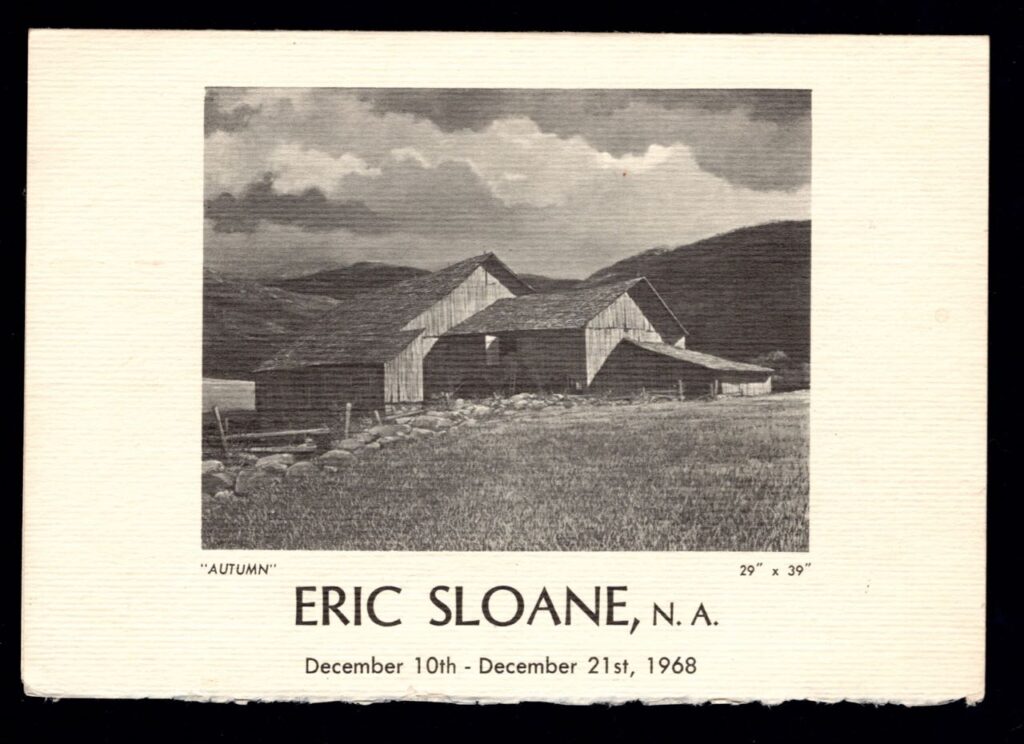
Grand Central Art Galleries invitation to a 1968 show of Eric Sloane paintings. Eric Sloane enjoyed multiple showings over the years at Grand Central.
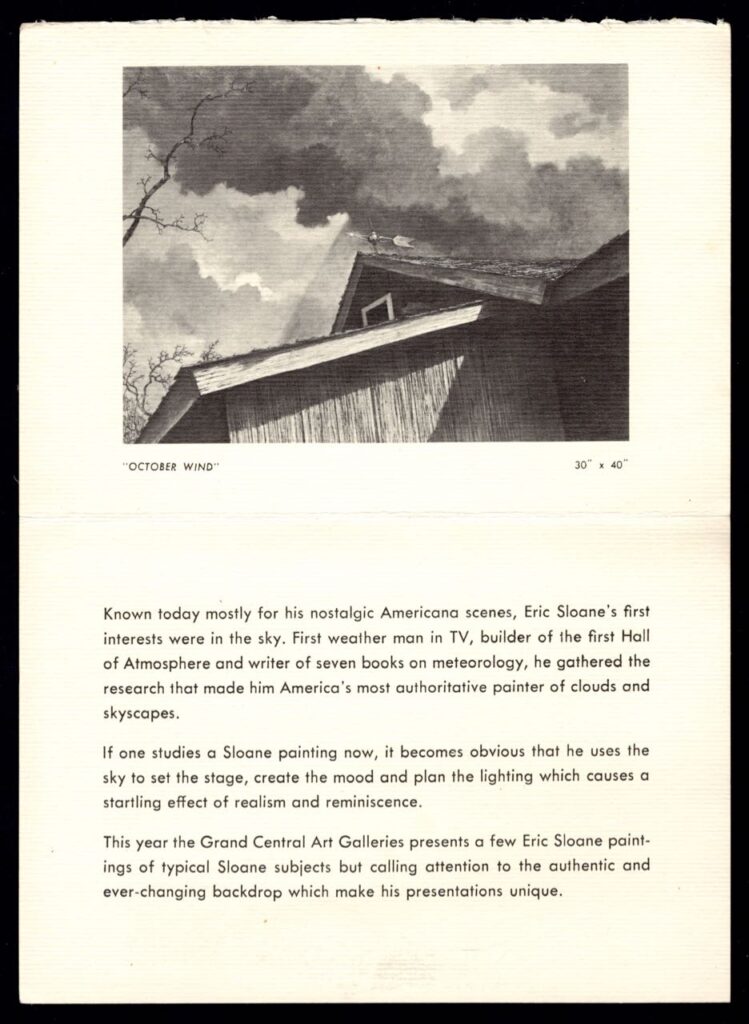
Grand Central Galleries was the creation of The Painters and Sculptures Galley Association, a non-profit artists’ cooperative in 192. Offices and exhibition space were leased on the 6th floor of Grand Central Terminal in 1923.
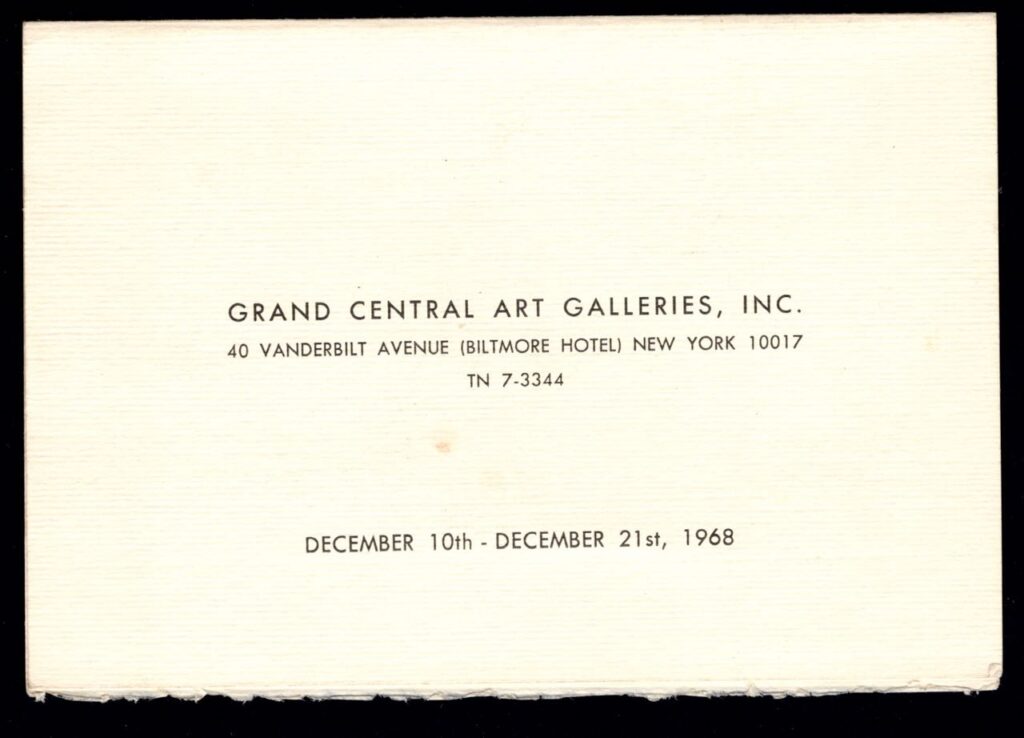
In 1958, Grand Central moved to the location listed on the verso of the gallery invitation, above. Their space include an office and six exhibition rooms, where the organization remained until the Biltmore Hotel was turned into an office building in 1981.
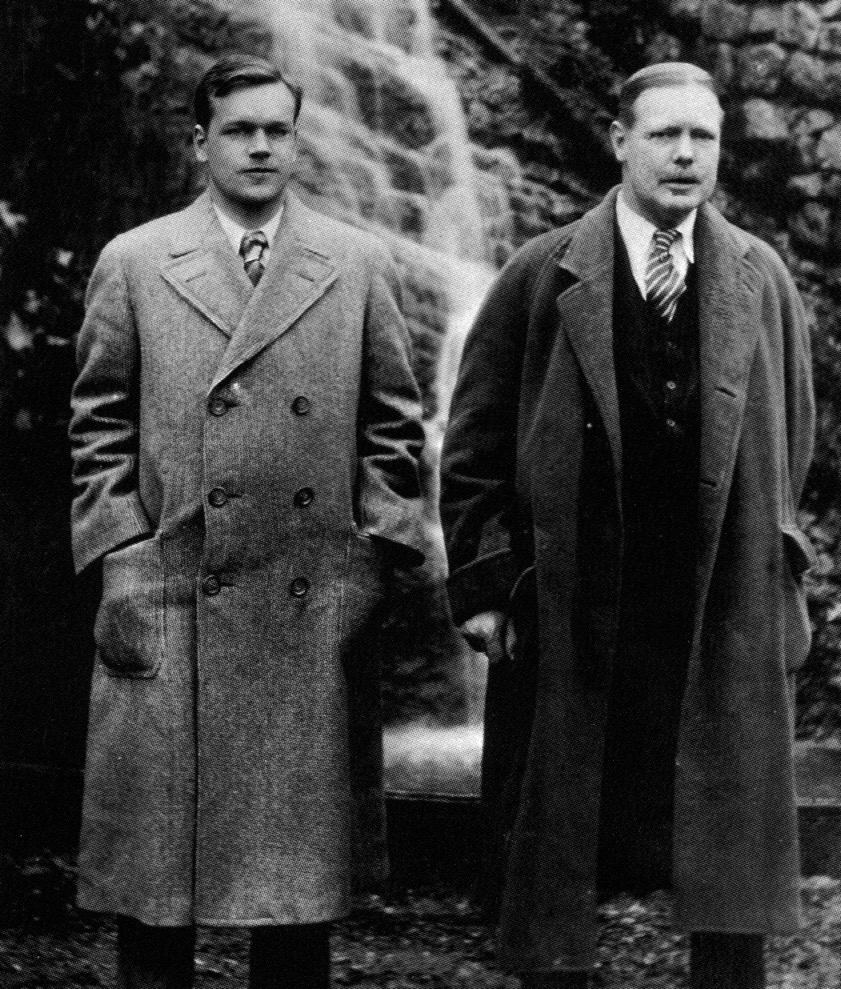
Pictured above: George Hinrichs, Sr., at right, with Everard Hinrichs (later Eric Sloane) at left. Eric bears a passing resemblance to actor Matt Damon in this photo. Taken in 1928 at Hot Springs, Arkansas. George was recuperating from pneumonia at the time. Eric’s father would die less than a year later on the porch of Cedarcrest. From Aware: A Retrospective of the Life and Work of Eric Sloane by Wil Mauch.
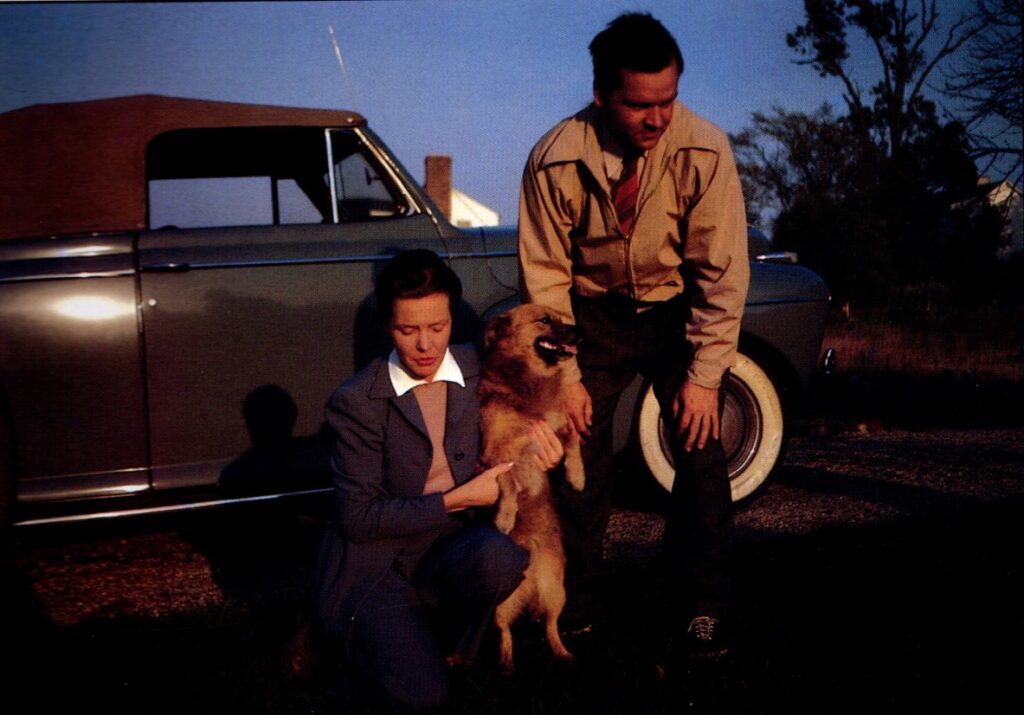
Eric Sloane with his sister Dorothy, c. 1941, at Eric’s residence in Brookfield, Long Island.
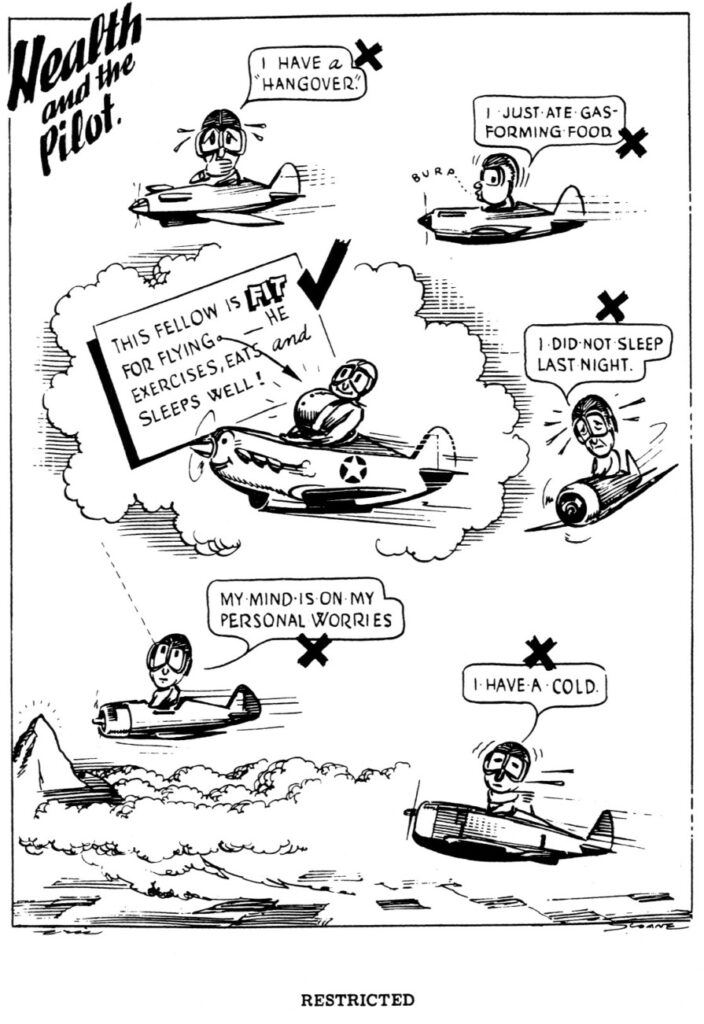
One of Eric Sloane’s illustrations for Your Body In Flight (T.O. # 00-25-13), prepared by the Aero Medical Laboratory of Wright Field, Dayton, Ohio), published by the Air Service Command, Patterson Field, Fairfield, Ohio for the United States Army Air Forces, July 20, 1943. Eric Sloane’s contribution to the training of pilots both informally just prior to the onset of WWII and formally as in this Army Air Forces manual, is often ignored. Eric Sloane contributed to two publications prior to the war that were used by civilian pilots as well as military recruits: Your Wings, by Assen Jordanoff (Funk and Wagnalls, May 1940) and Let’s Fly: An ABC of Flying by Earnest Vetter ( William Morrow and Company, 1940). Sloane also authored and illustrated his own Clouds, Air and Wind (The Devan-Adair Company, 1941). During the war, Eric Sloane wrote and illustrated Camouflage Simplified (The Devan-Adair Company, 1942), Gremlin Americanus, A Scrapbook Book Collection of Gremlins (B.F. Jay and Co., 1943). While the latter title was meant to be humorous, it was both quite an effective remainder of the dangers that faced pilots, as well as a probably much needed break from the military training manuals. During the war, Eric Sloane also contributed to Junior Aviation Science (by D.H. Grimm, Noble & Noble Publishers, 1942) and to at least one other publication for the Army Air Forces, Pilot’s Information File (1943, the Army Air Forces).
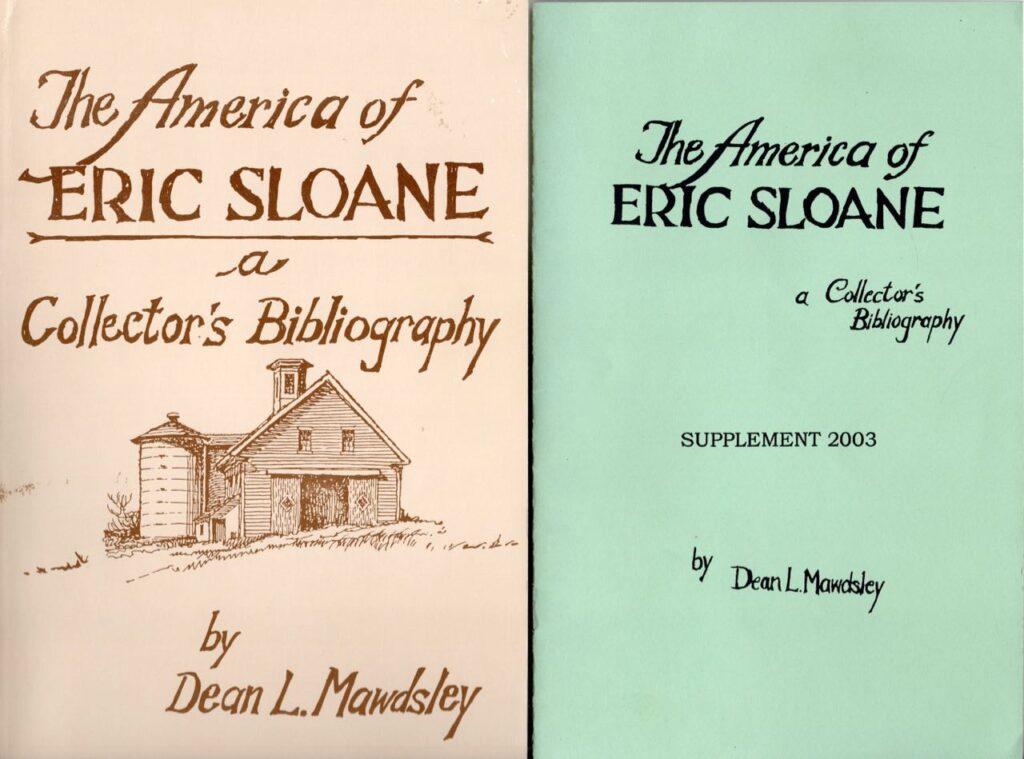
An excellent resource on the titles and articles penned by Eric Sloane over the course of his long career, The America of Eric Sloane A Collector’s Bibliography, written by Dr. Dean L. Mawdsley, is an indispensable source of information. Be sure to obtain The America of Eric Sloane A Collector’s Bibliography SUPPLEMENT 2003, as Dr. Mawdsley updated his original work to include newly discovered works by Eric Sloane. Both were printed by the Connecticut Historical Commission, in 1990 and 2003, respectively.
A few years ago we were able to pull sound from an old recording of Eric Sloane.
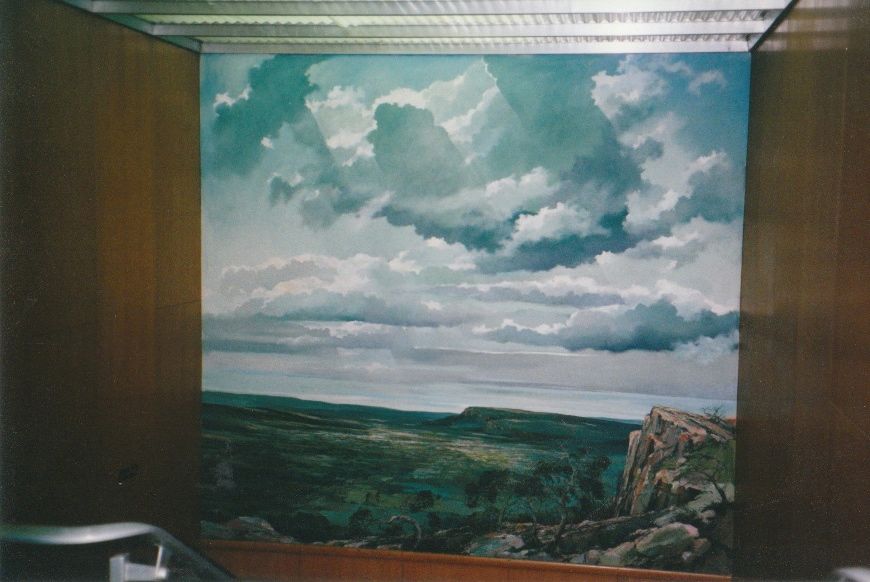
Over the course of his career, Eric Sloane painted many murals. Quite a few were in private homes, many others were in corporate settings (see An Artist Recalls America’s Heritage, above, for Eric’s work in the president’s office of Morton Salt). These photographs were taken by Wil Mauch in 1999/2000 of a Sloane mural in the headquarters of the now defunct International Silver Company, Meriden, Connecticut.
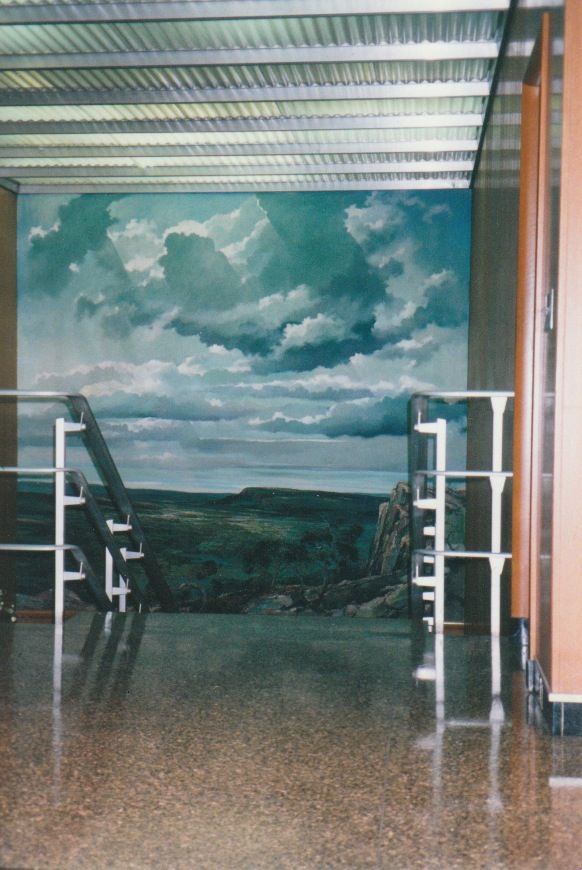
Imagine walking to and from your office every day and passing a large Eric Sloane mural.
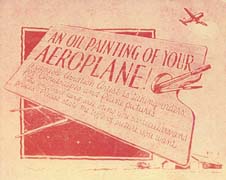
This is a rare business card enclosure created by Eric Sloane, who, as “…a capable aviation artist is taking orders for cloudscapes and plane pictures. The enclosed card will being you particulars and prices. Please state the type of picture you want.” We have yet to see what exactly was placed inside of this card holder, but this is the first of six we have had in the gallery, all affixed to Eric Sloane paintings of the late 1930s.
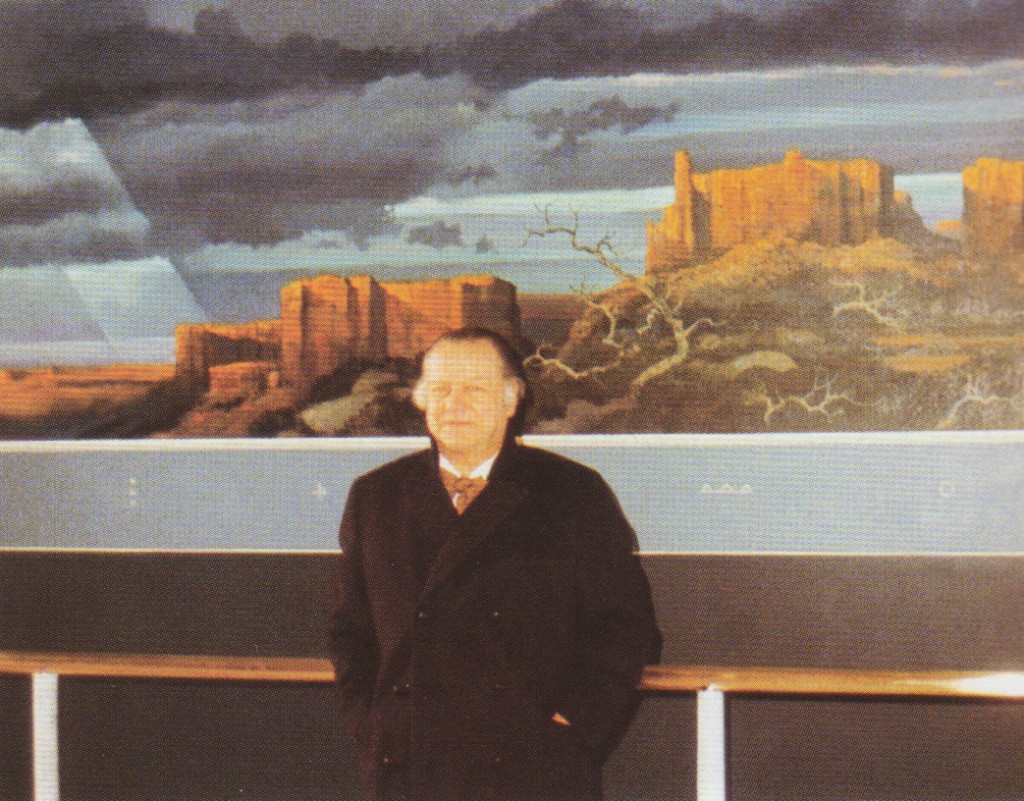
Eric Sloane in front of the mural he created for the Independence Avenue lobby entrance of The National Air and Space Museum.
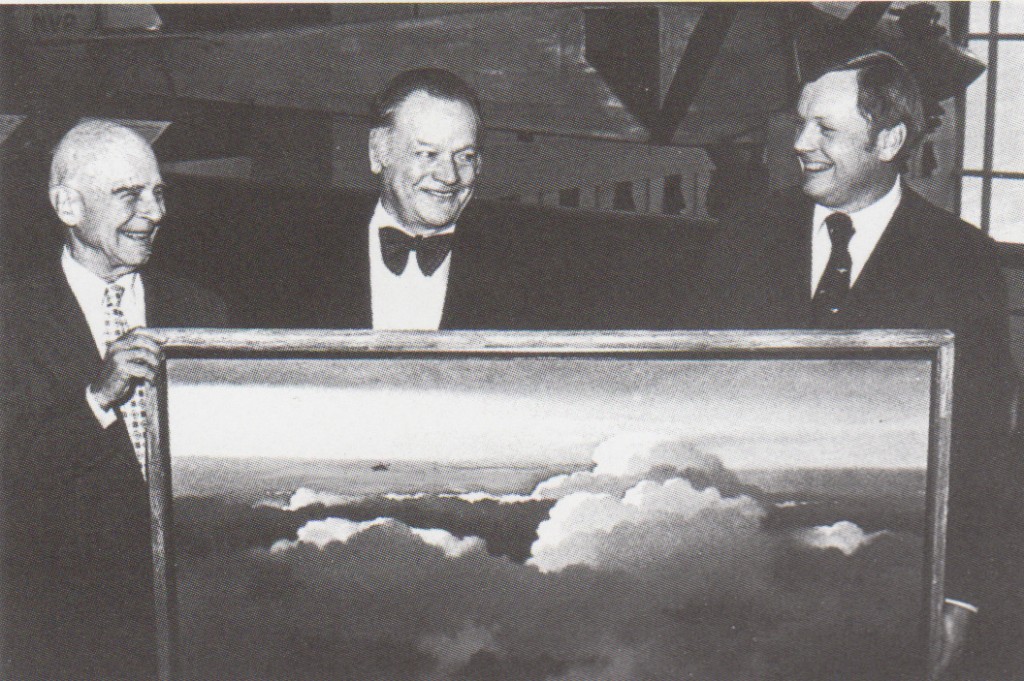
Jimmy Doolittle, left, Eric Sloane, center, and Neil Armstrong pose with the artist’s painting Alone. Alone was Sloane’s depiction of Charles Lindberg’s heavily modified Ryan M-2 aircraft “The Spirit of St. Louis” as it flew above the Atlantic on May 20/21, 1927. Alone was presented to the museum by Eric Sloane on the occasion of the 50th anniversary of the crossing. Notice “The Spirit of St. Louis” suspended from the ceiling in the background, installed in the Milestones of Flight Gallery of The National Air and Space Museum in Washington, D.C.
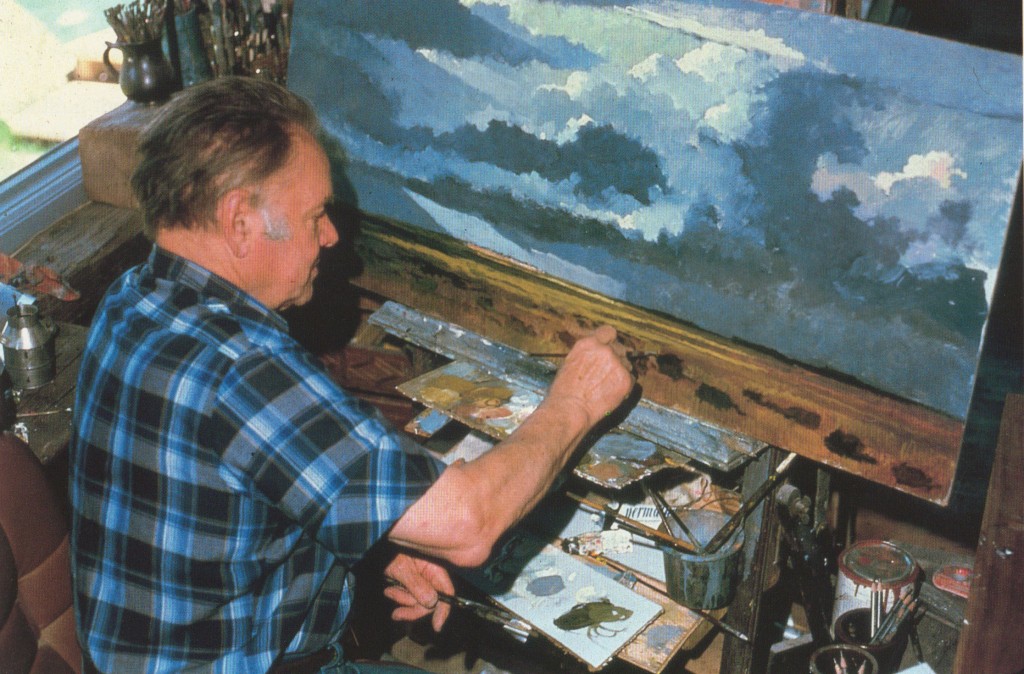
Eric Sloane at work at his Carter Road studio in Warren, Connecticut. You’ll see straight away that Sloane re-purposed ends of primed masonite for his multiple palettes. A quart can of oil or latex ‘barn red’ paint (not artist paint) is visible at bottom right. His composition is about 65% complete. Eric will work more on the sky to give it greater depth and atmosphere, as well as providing more detail to the land. You can readily see that it will be a stunner when completed.
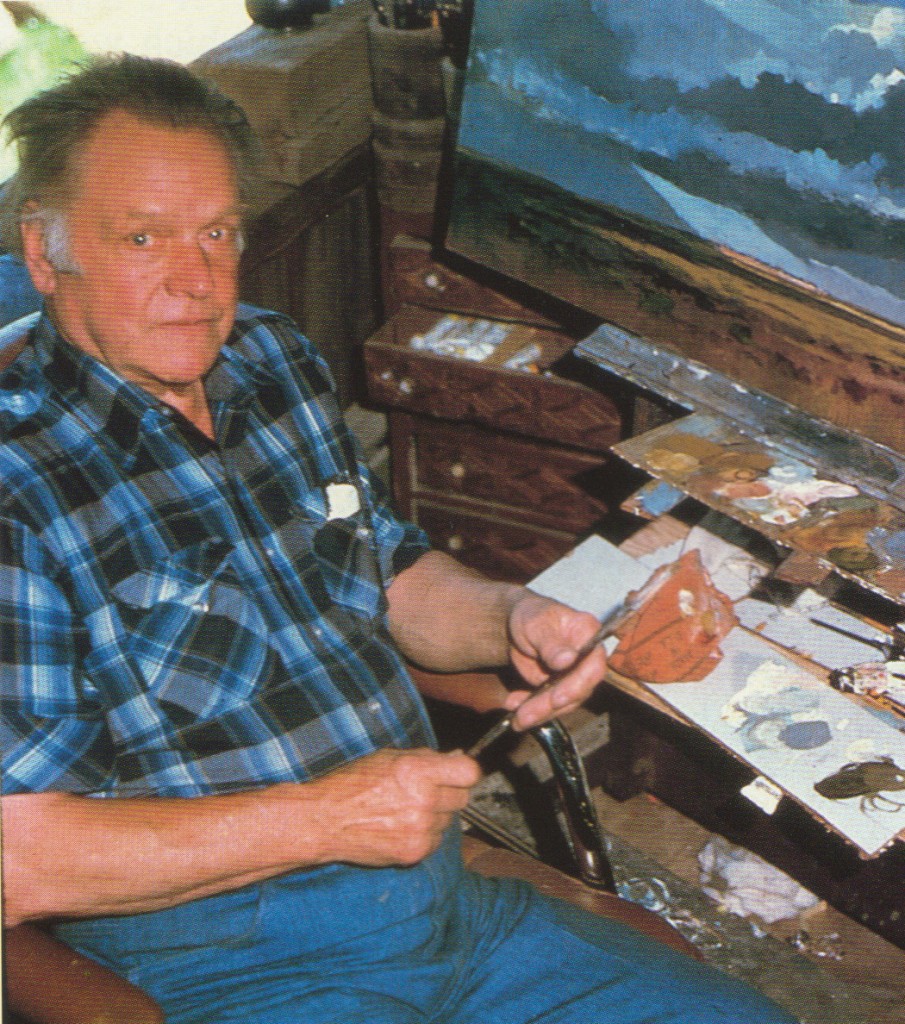
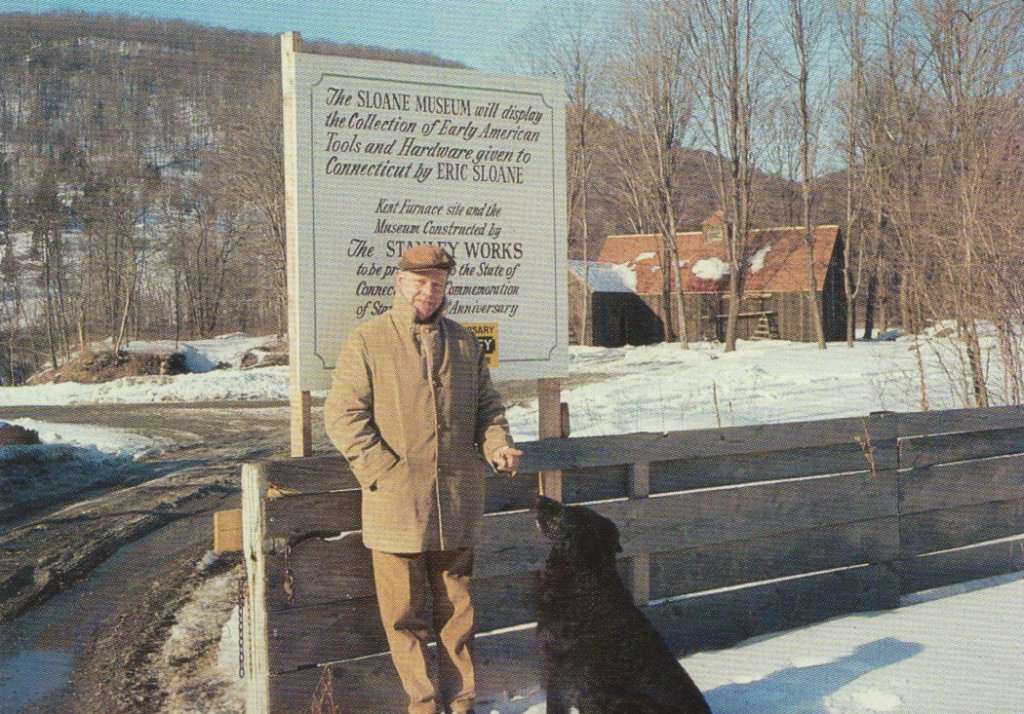
Eric Sloane and “Spooky” in front of the Eric Sloane Museum likely January of 1969. Note that the sign reads “The Sloane Museum”. By the time the invitation for the May 28, 1969 dedication of the museum, the name had changed to “The Sloane-Stanley Museum”. When and how that name was changed is unknown.
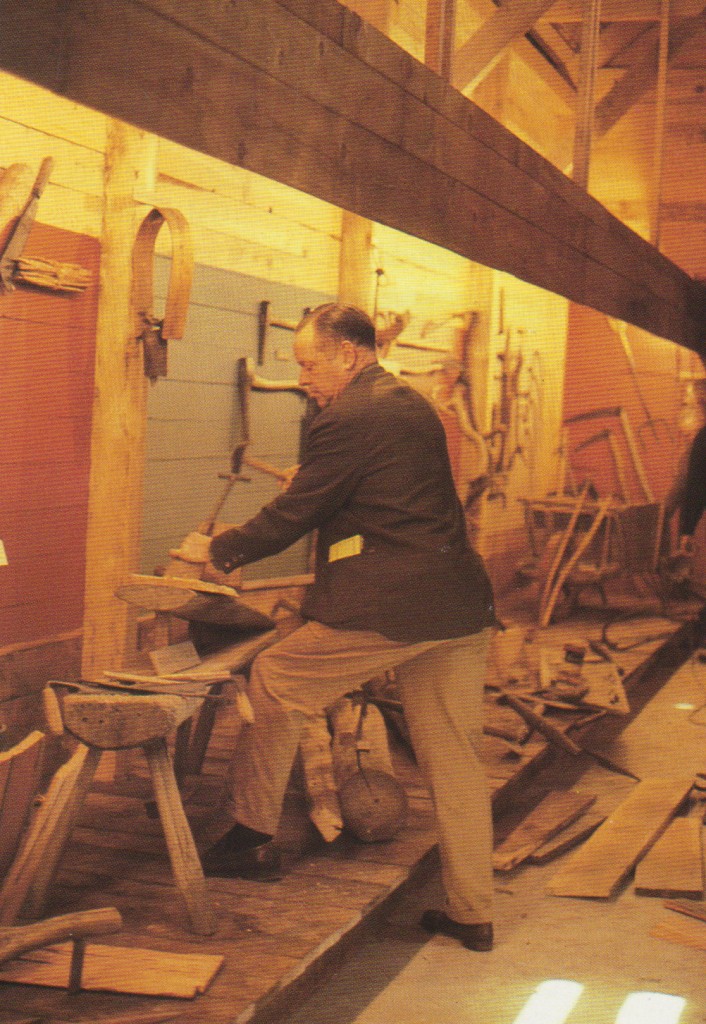
Press photo of Eric Sloane working on an installation in the museum, spring of 1969.
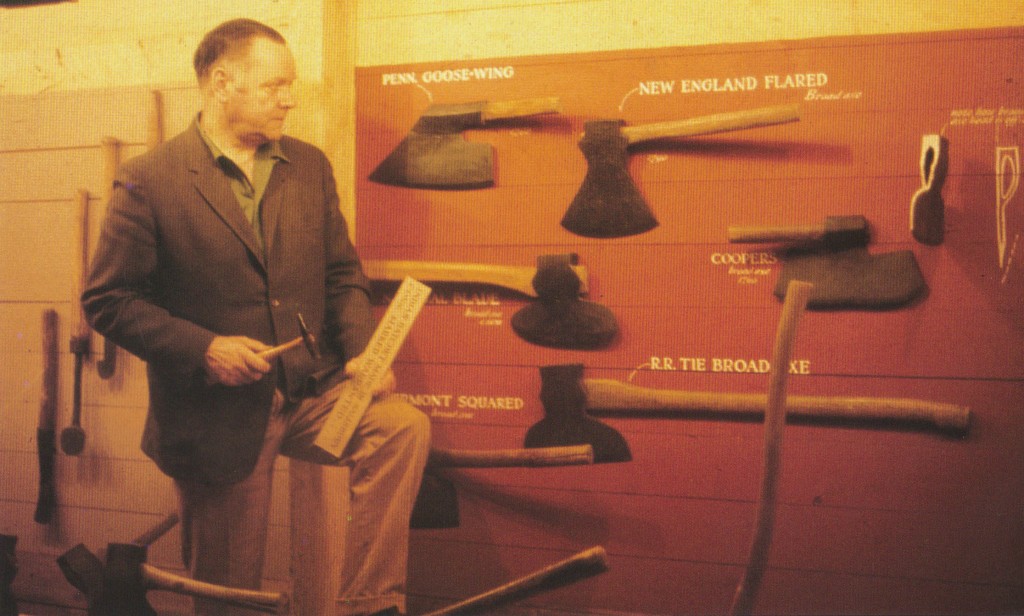
Press photo of Eric Sloane on the same day (notice he is wearing the same clothes as in the previous photograph). This installation of differences in broadaxe designs appear much more finished than the exhibit in the previous photograph.
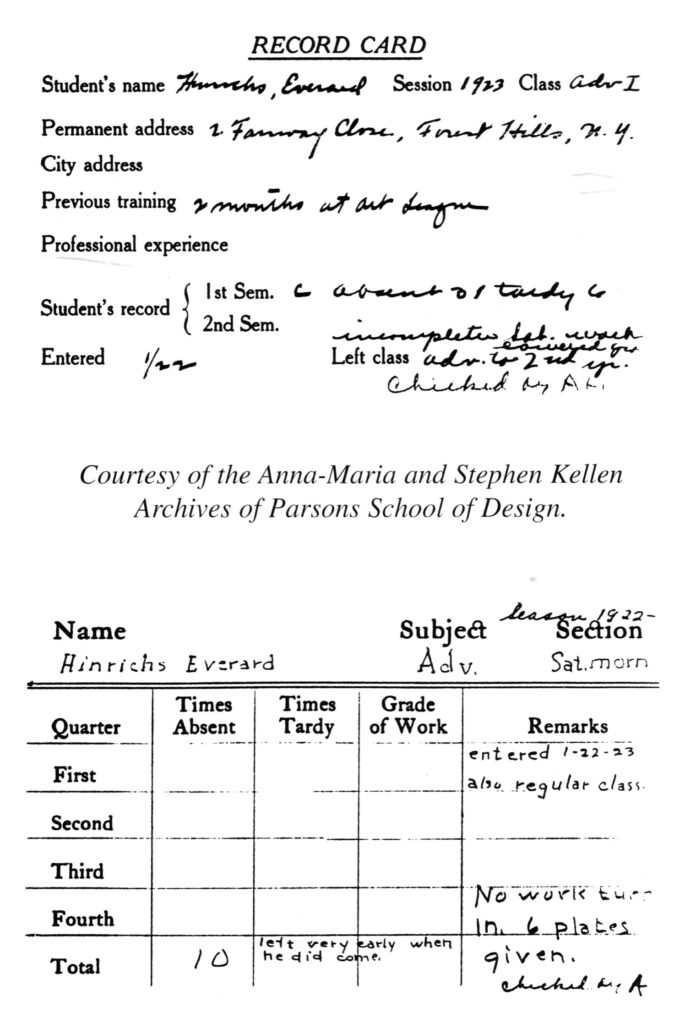
Eric Sloane’s (Everard Hinrichs) 1923 Record Card and grade report card for Advertising class from the New York School of Fine and Applied Art. One gets a sense that Eric wasn’t taking his studies very seriously…
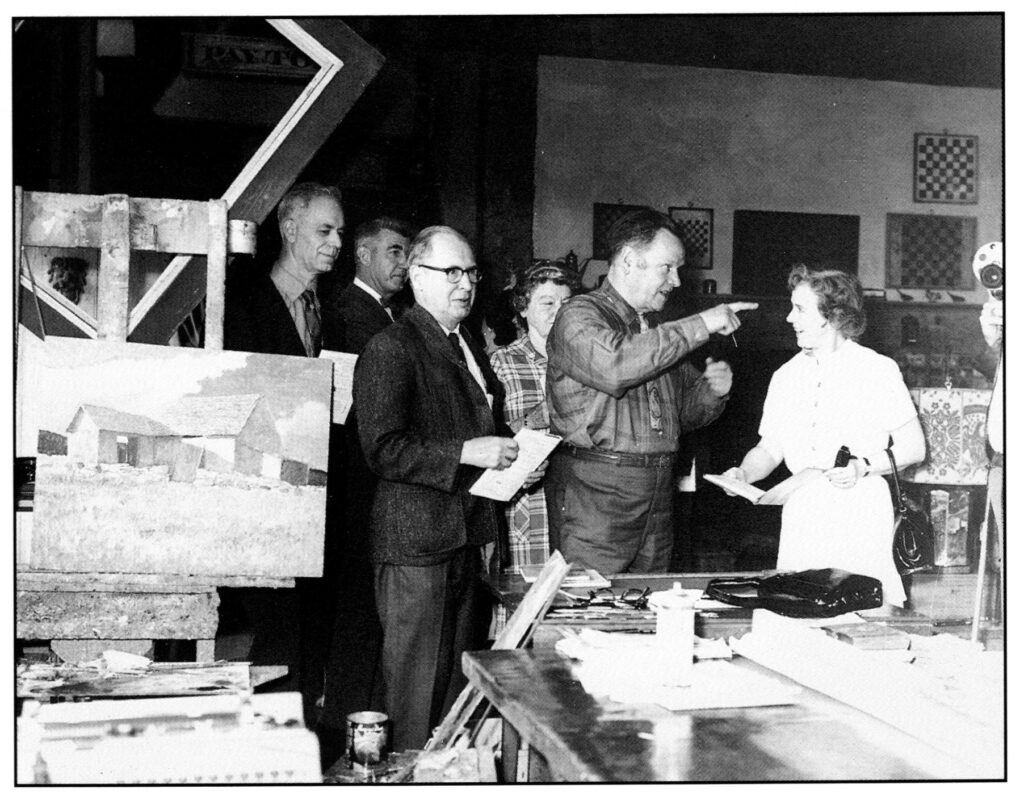
This photograph above appears to be an organized tour of Eric Sloane’s house and studio, a tour that was organized thorough the recently opened Eric Sloane Museum. You can see how Eric would decorate much of the space – including the walls – with early American tools and crafts.
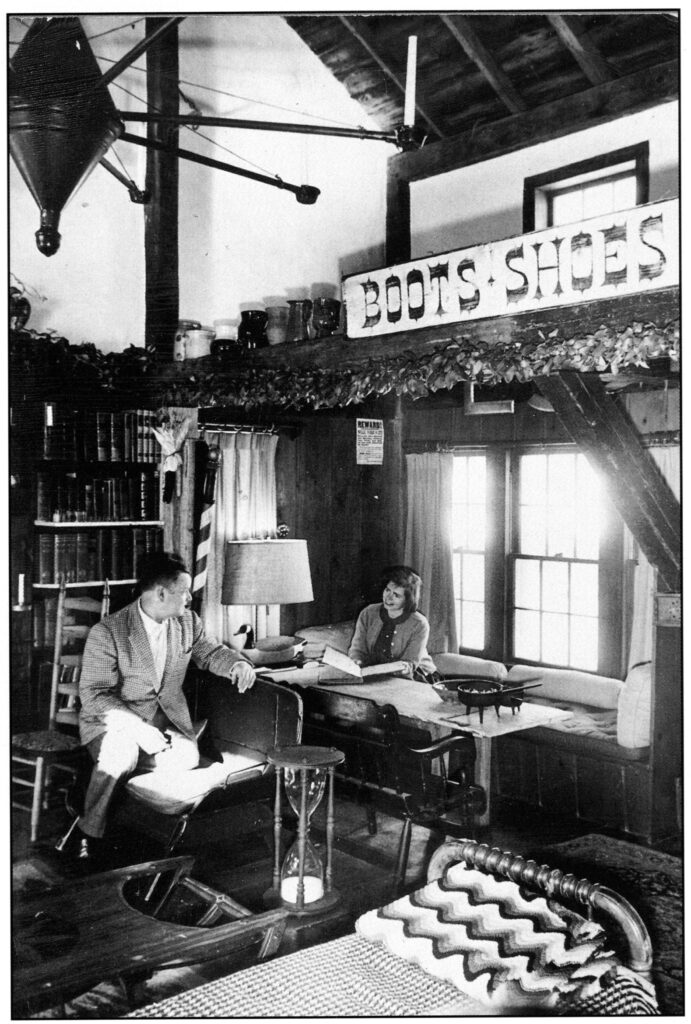
Another interior view of the Sloane home. Eric’s wife at the time, Ruth, is pictured at right. If you look closely, you’ll see that Eric is seated on a buggy or sleigh seat.
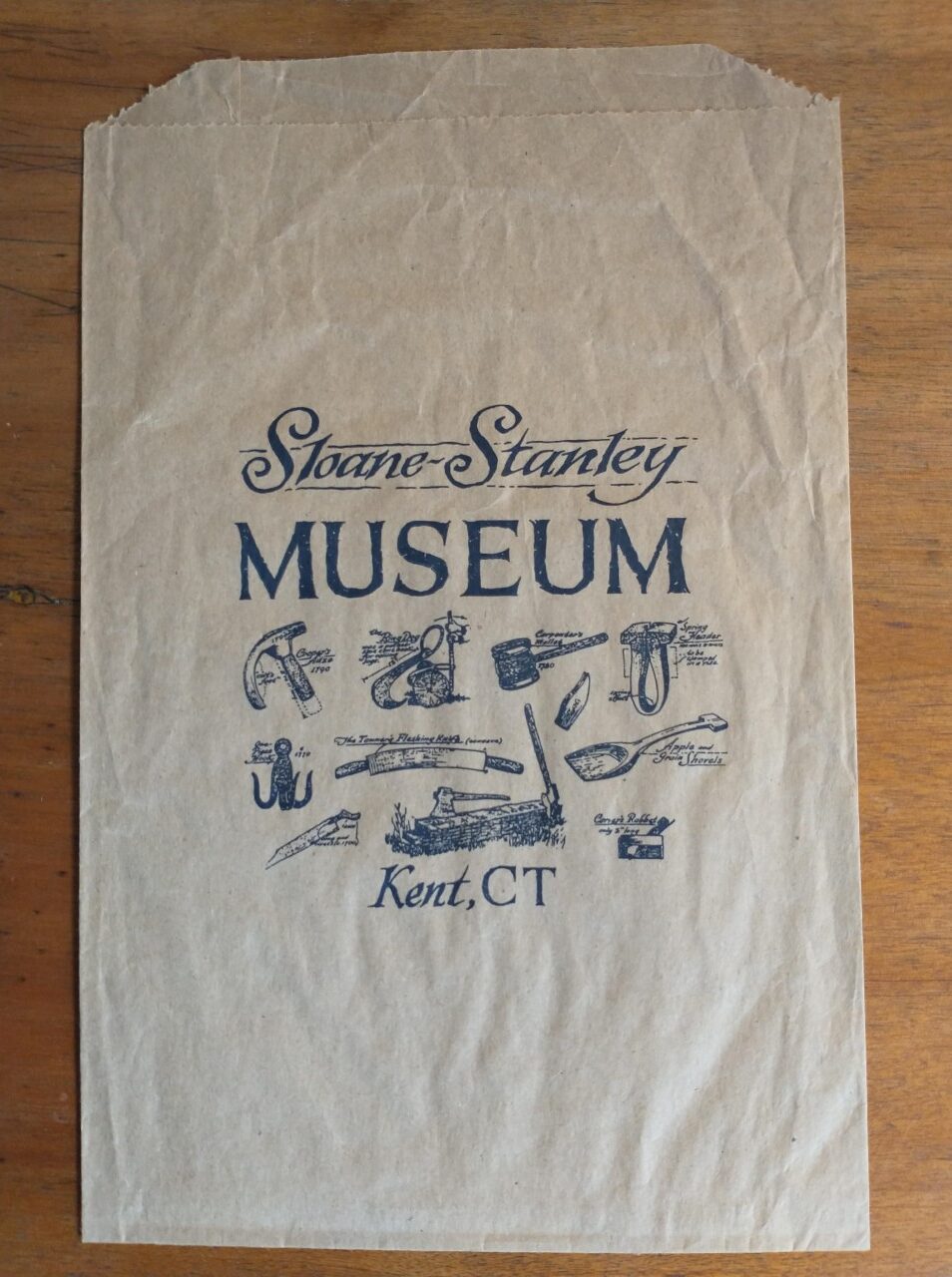
Charming bag used by the Sloane-Stanley Museum (as it was called at the time), c. 2000-2011.
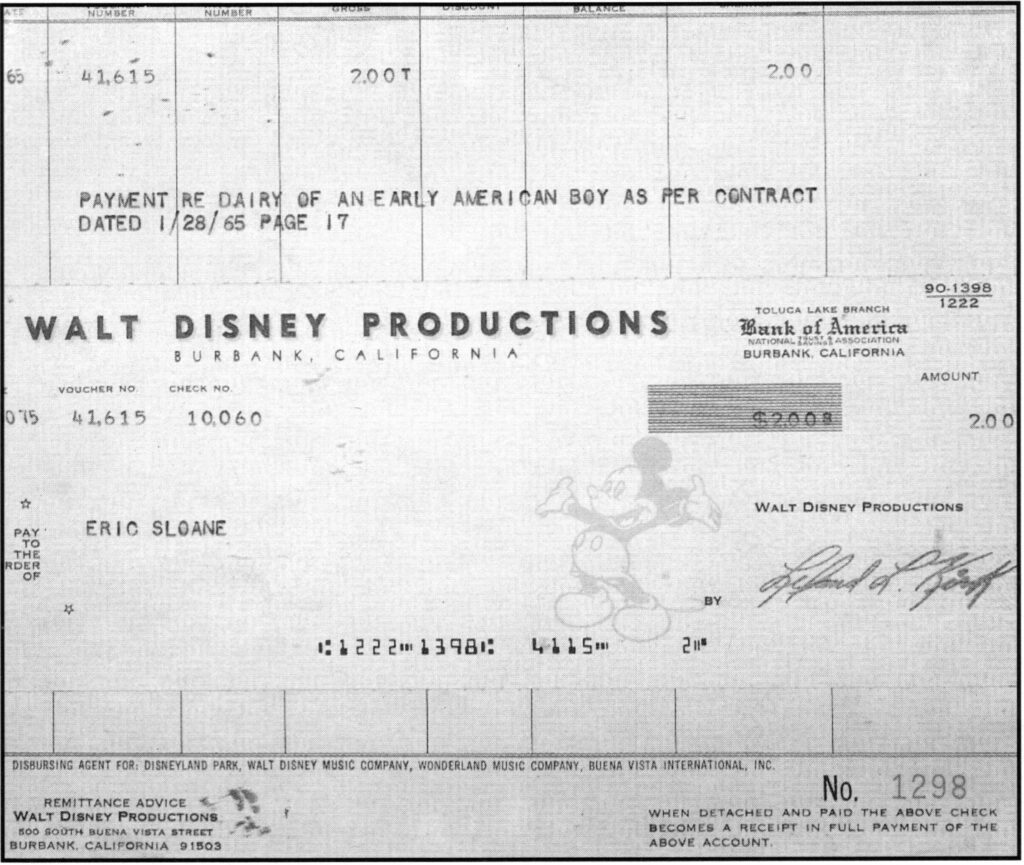
In 1965, Eric Sloane was approached by Walt Disney (or perhaps representatives for Walt Disney Productions) to see if the author/artist might sell the rights to Diary of an Early American Boy so that the studio could spin the story into a Disney movie. Sloane must have asked – or the production company disclosed – how much they were willing to spend to secure the rights. Sloane rejected that amount, stating that it was an “astonishingly paltry sum” (Eighty). Eric Sloane responded to Walt Disney via letter in a way he intended to be humorous: “I am well aware of your frugality and I feel embarrassed at your offer. I so admire your work. however, that I’d rather give you the script for nothing, but I’m sure my wife (and my psychiatrist) would object to that…I might settle for two bucks” (Eighty). A check for two dollars soon arrived from Walt Disney Productions, along with a seventeen page contract. Not to be outdone, Sloane promptly found an appropriate location to hang his now framed check: over the toilet in his studio bathroom. The framed check remains in the possession of the Eric Sloane Museum of Kent, Connecticut, hung in Eric Sloane’s (recreated) studio.
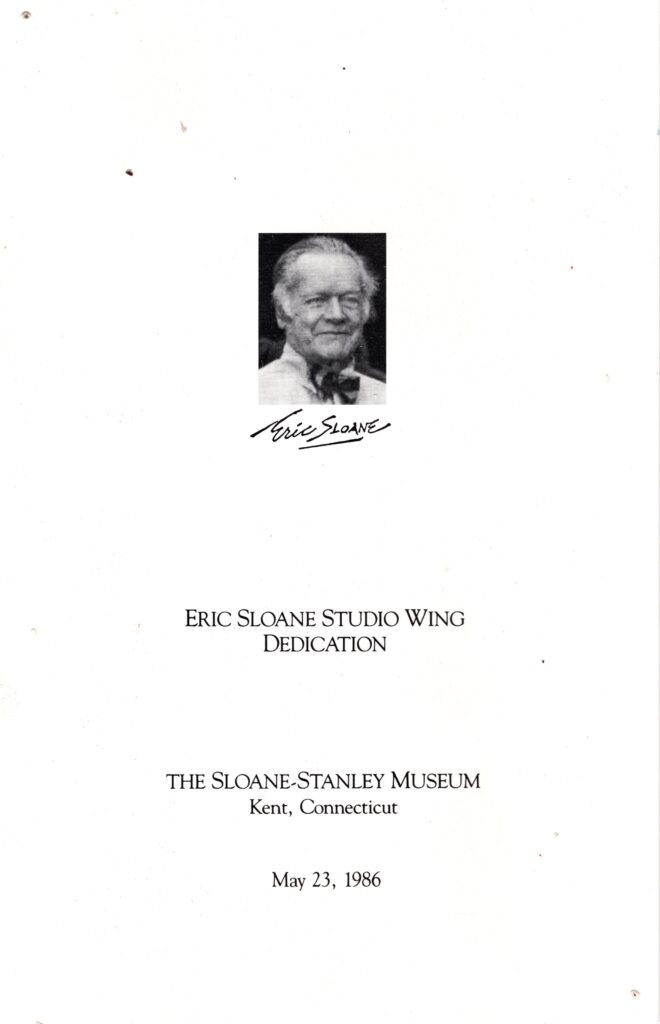
Invitation for the Dedication of the Eric Sloane Studio Wing, May 23, 1986.
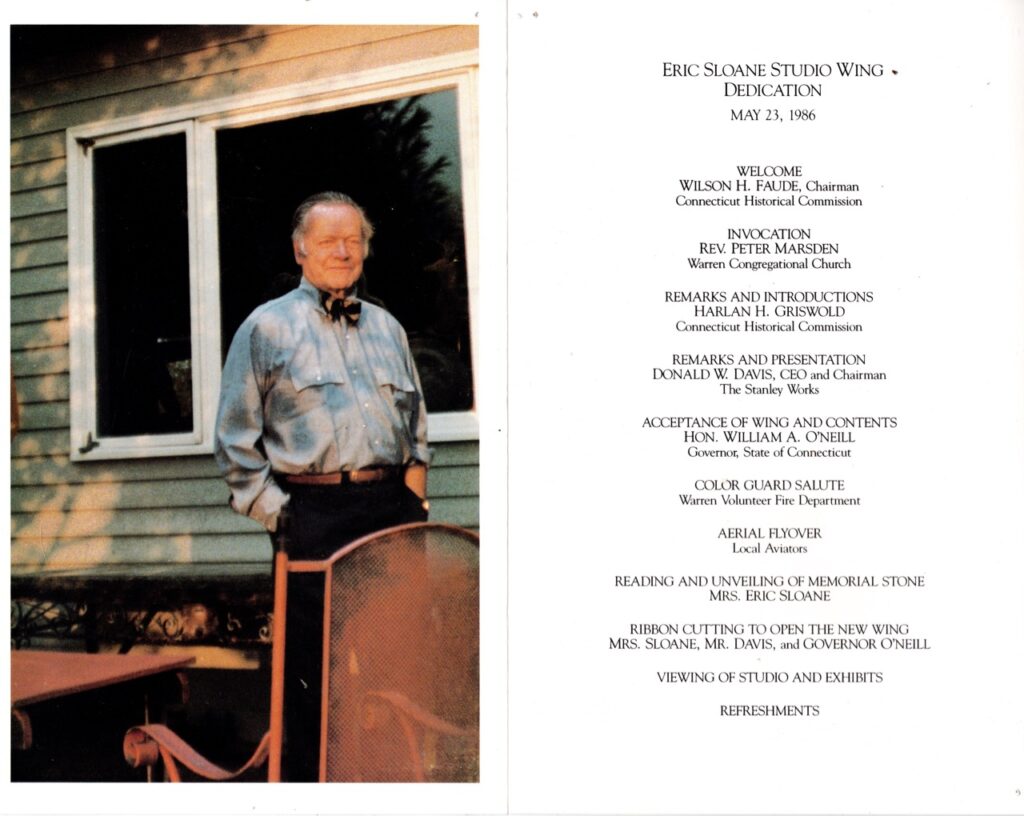
Interior of the Eric Sloane Studio Wing Dedication Invitation
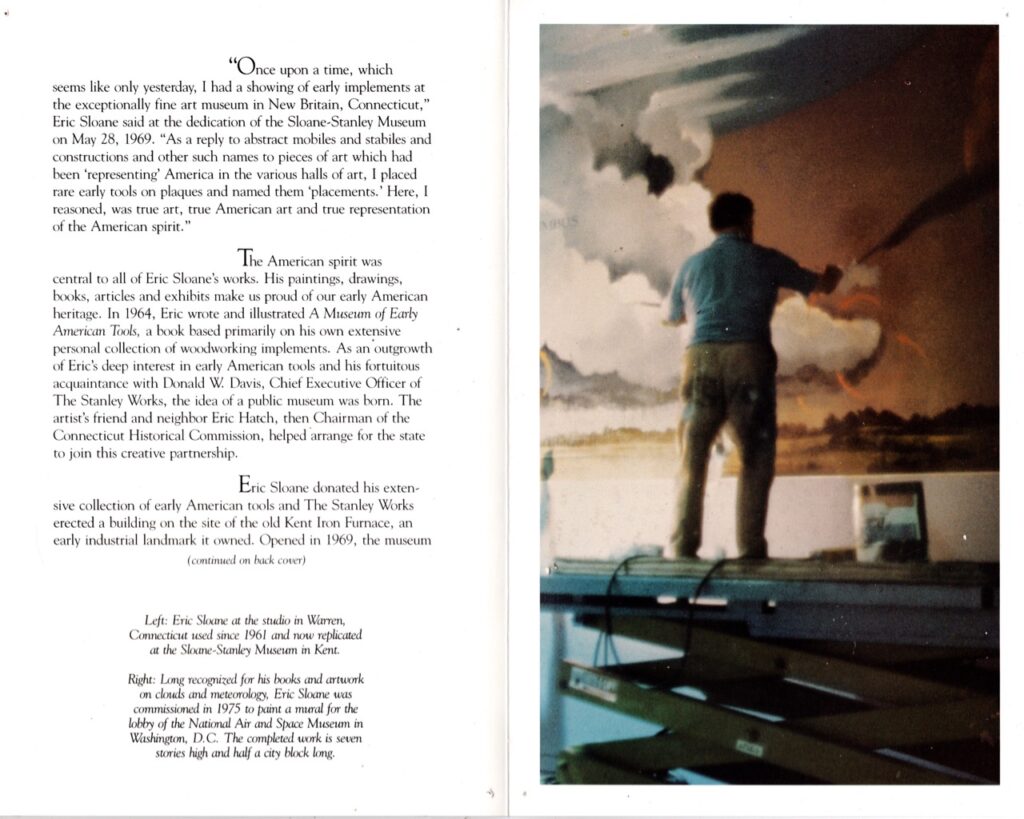
Interior of the Eric Sloane Studio Wing Dedication Invitation. The first paragraph of text is a quote pulled from Eric’s original dedication of the Sloane-Stanley Museum in 1969.
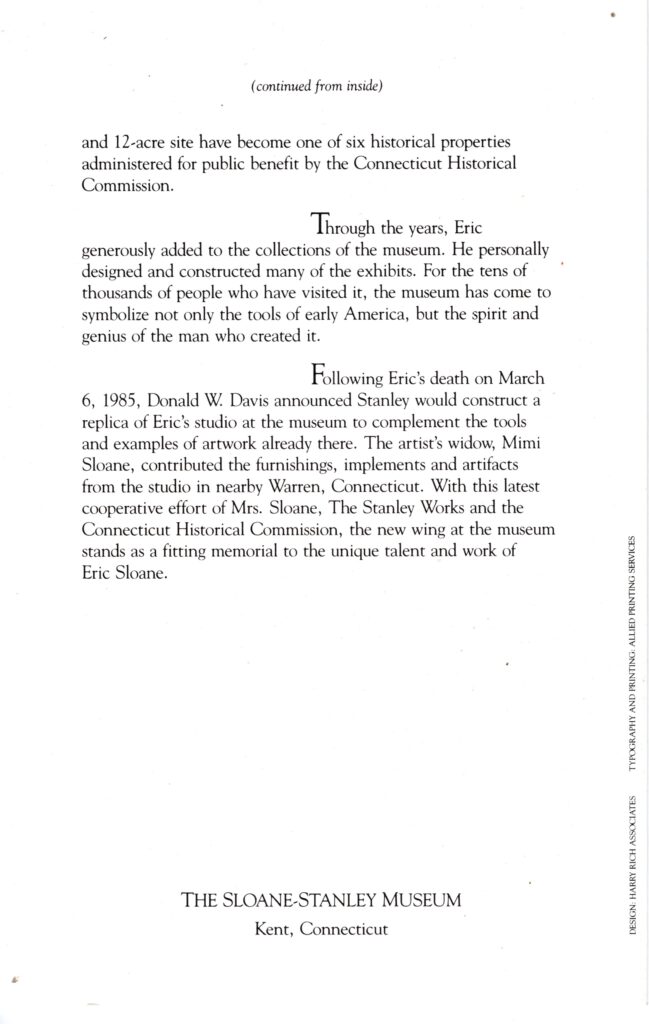
Eric Sloane Studio Wing Dedication Invitation, rear.
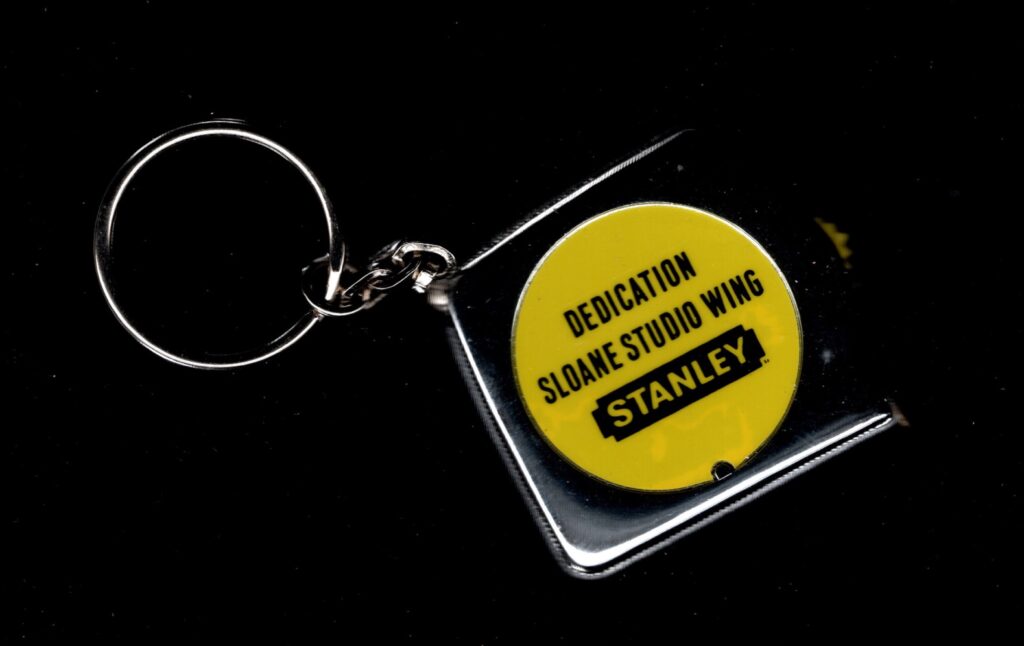
Attendees to the Eric Sloane Studio Wing Dedication were presented with this Stanley 36″ retractable tape measure/keychain combination.
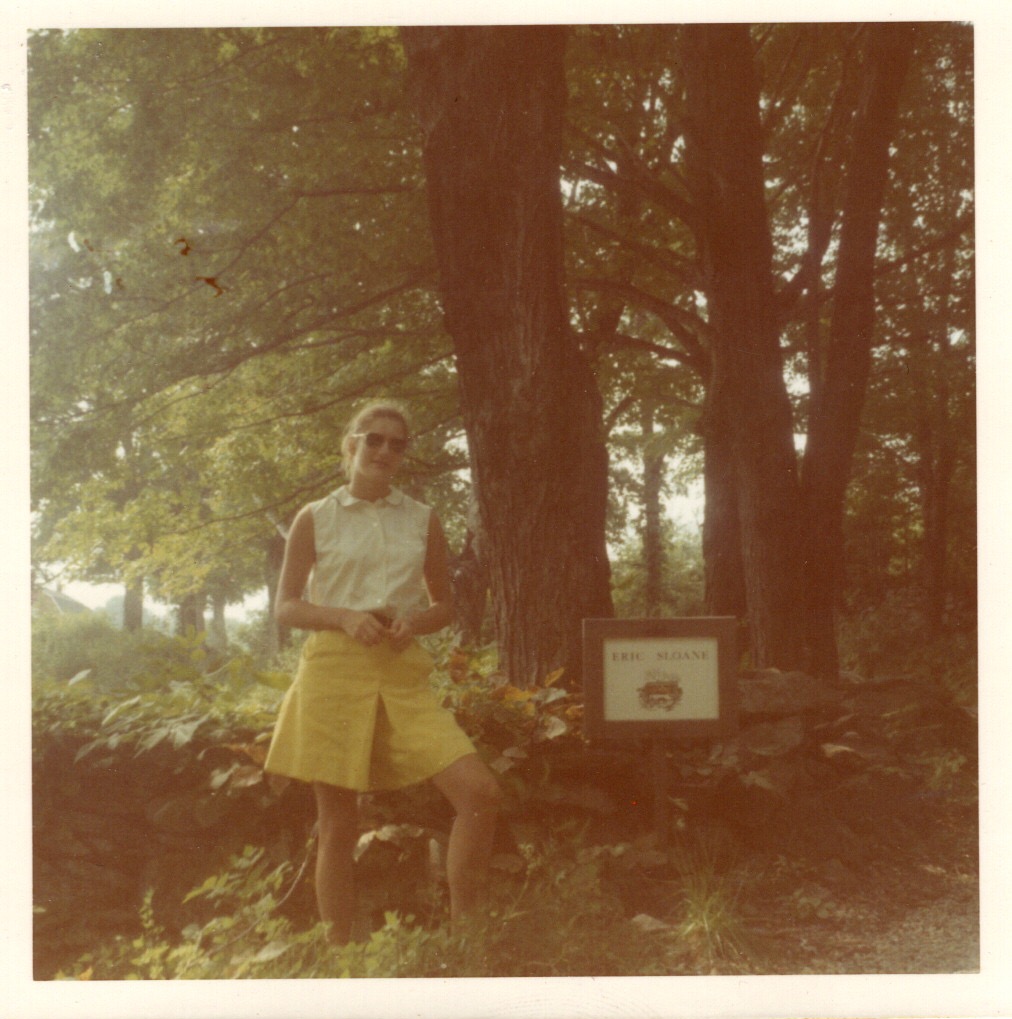
Luci W. Shaw, pictured at the edge of Eric Sloane’s driveway on Carter Road in Warren, in the summer of 1971. At the time, Ms. Shaw was a 2nd semester senior at Hollins College in Virginia, studying as an independent project the barn architecture of southeastern Virginia.
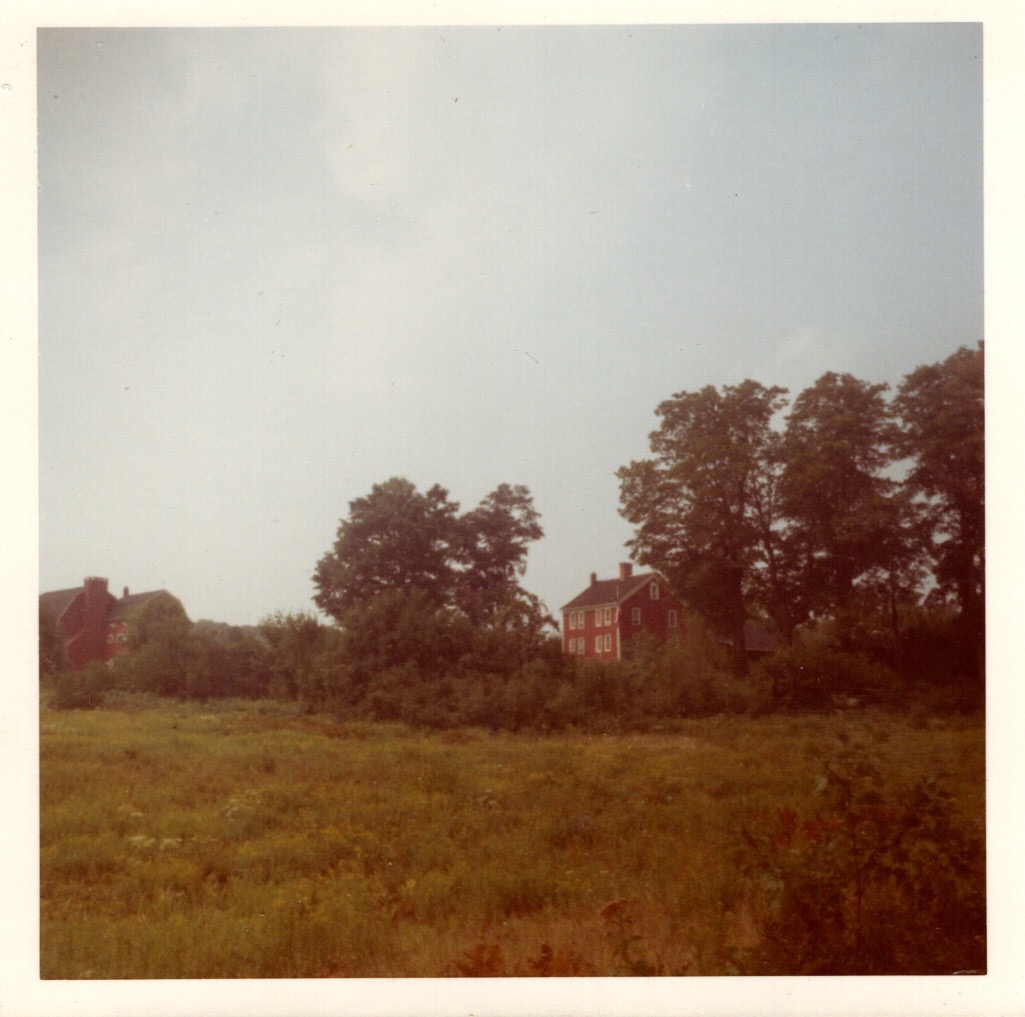
Ms. Shaw’s photograph of Weather Hill, the barn studio/guest house visible to the left.
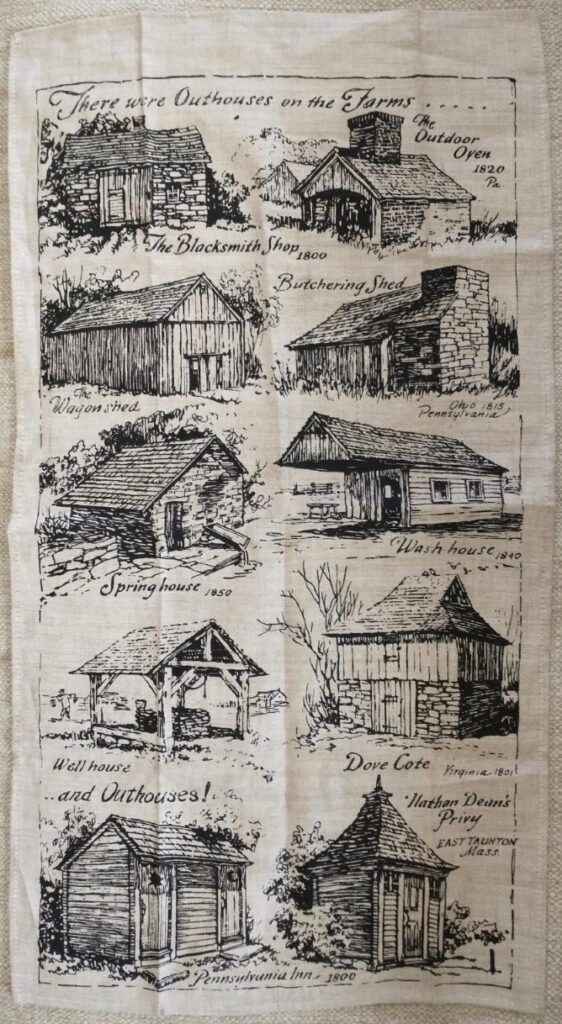
Charming tea towel utilizing illustrations of outhouses by Eric Sloane. The subject matter might seem strange to some to be included on an accessory generally relegated to the kitchen. I have seen two of these in almost twenty five years. This one was a rare find as it is new (old stock). 15.5″ w x 28″ long, no indications of what company made or sold it.
The following section displays the wide variety of tiles that were commissioned by Delano Studios of Setauket, Long Island, New York:
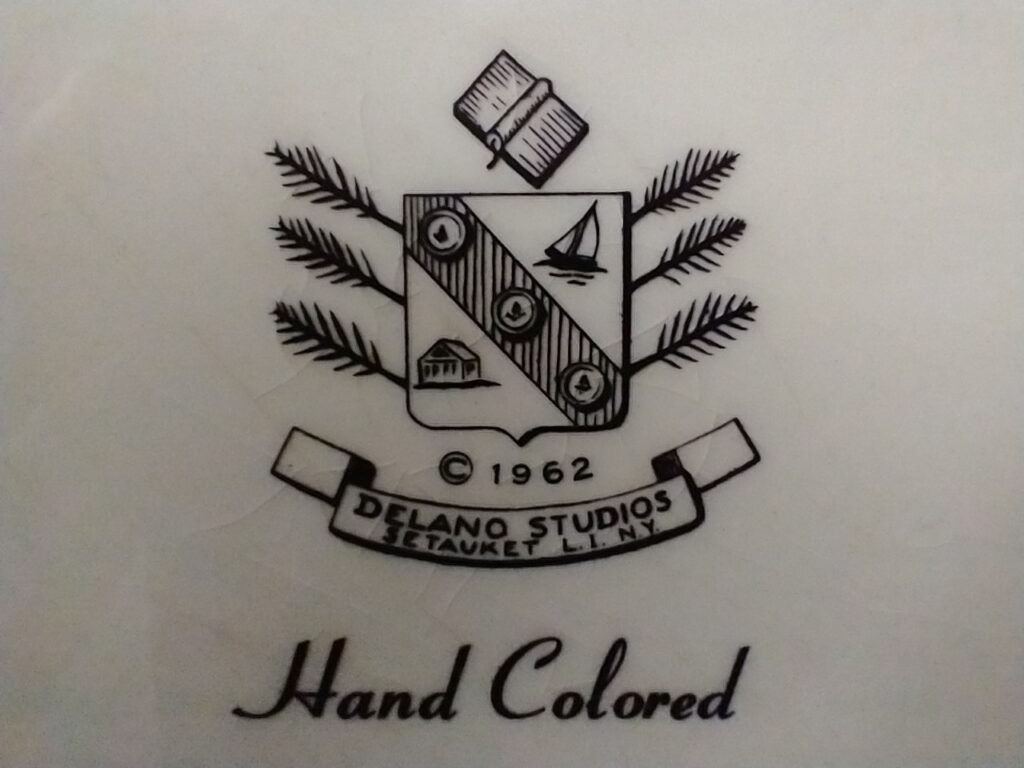
Note the denotation of “hand colored”, which appears at the bottom – hand coloring tiles, trinket trays, plates, and the like was a marketing tool that set Delano apart from competitors. While Delano products were well made and relatively inexpensive, the idea that they were “hand colored” added a bit of cache to the product. For an interesting story from the perspective of someone who worked in the hand coloring aspect of production at Delano, click here.
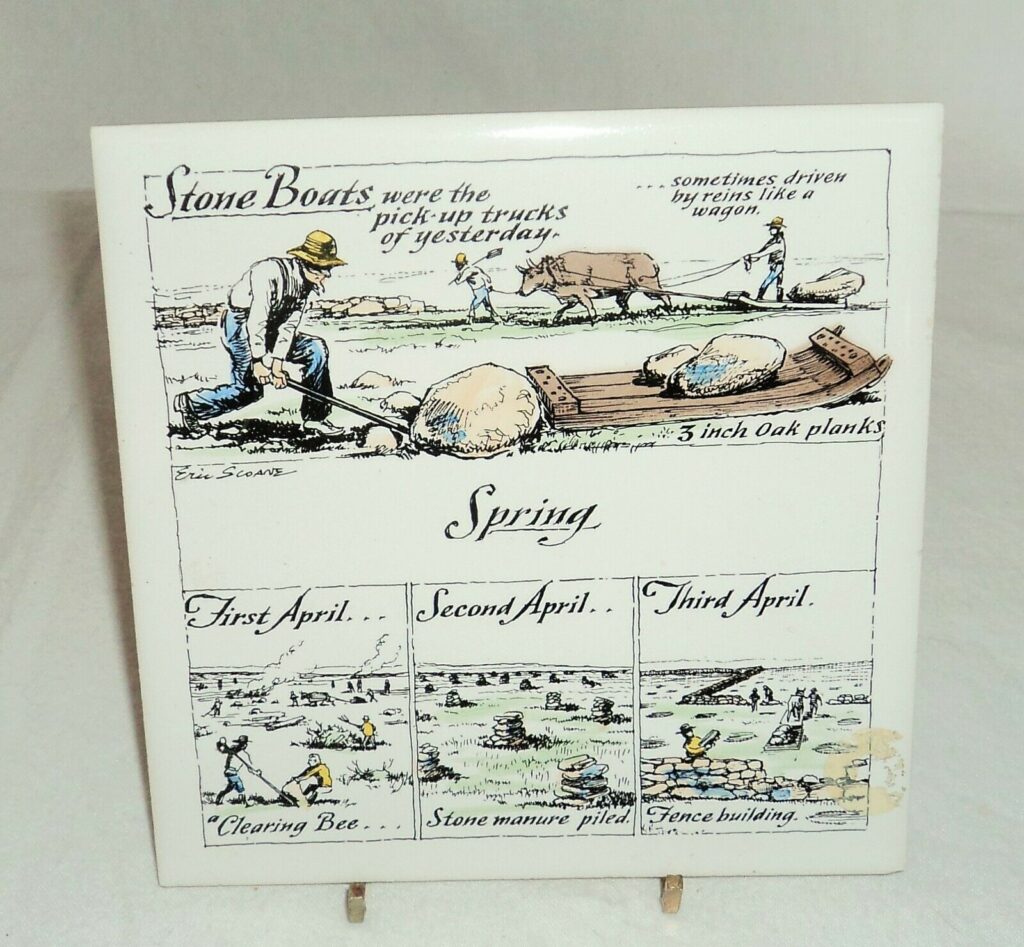
Spring, by Eric Sloane
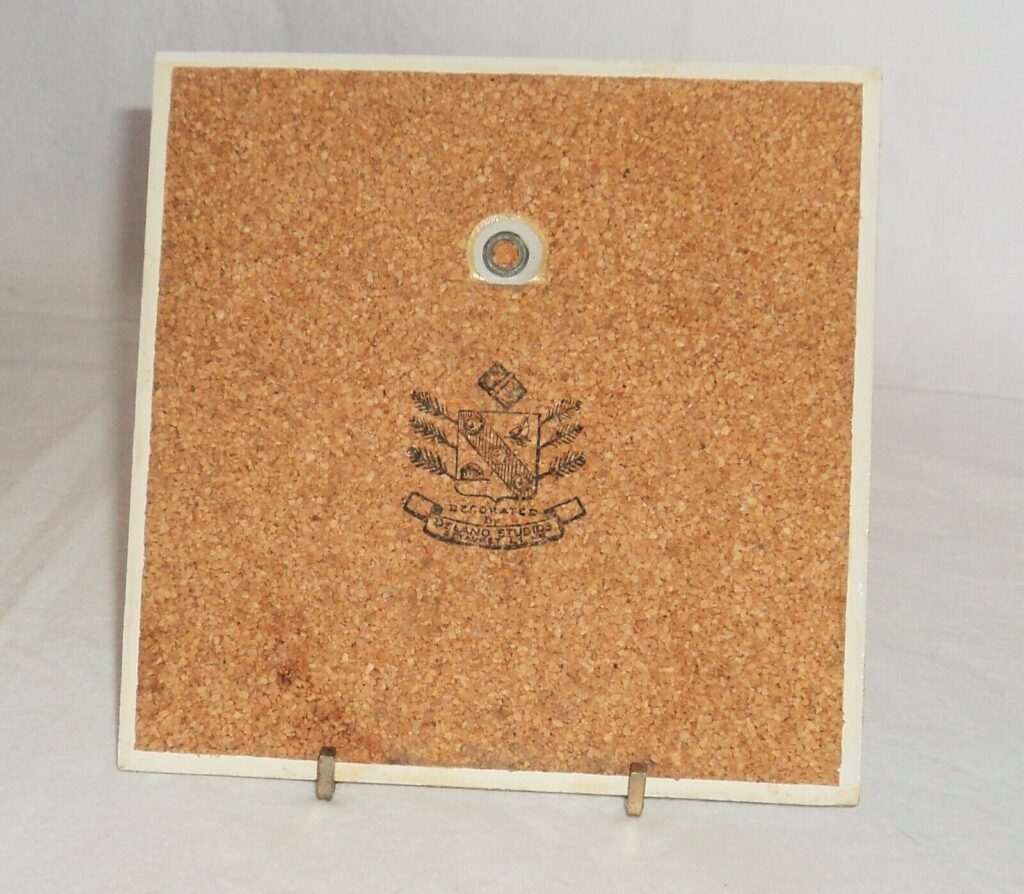
Spring, by Eric Sloane, verso. Notice that this time, as the back is cork, the Delano Studio corporate logo is stamped. The backs of tiles by Eric Sloane were usually either decorative (meaning for hanging), as indicated by the cork backing and loop for a nail, or functional, as indicated by a unglazed ceramic back for use in kitchen and bathroom backsplashes.
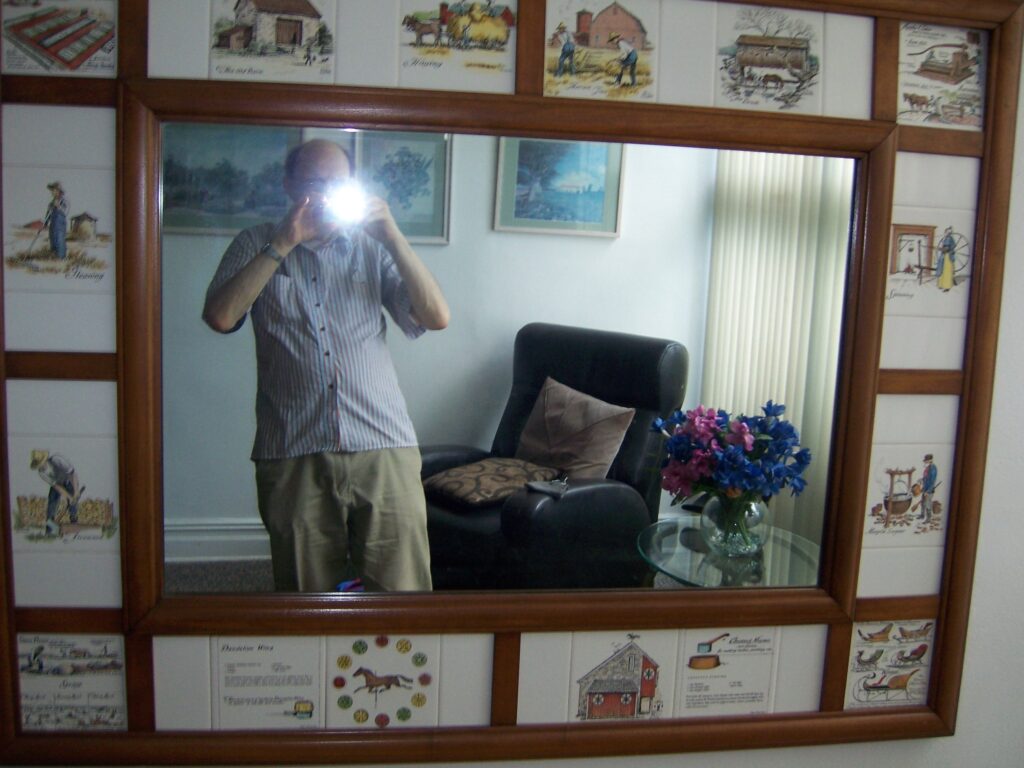
Eric Sloane illustrated tiles set into a mirror. Photo by a client. A few are quite rare. The tiles make for a busy, if not odd, frame. I don’t know if this was a “one off” or something produced by a company with a relationship to Delano.
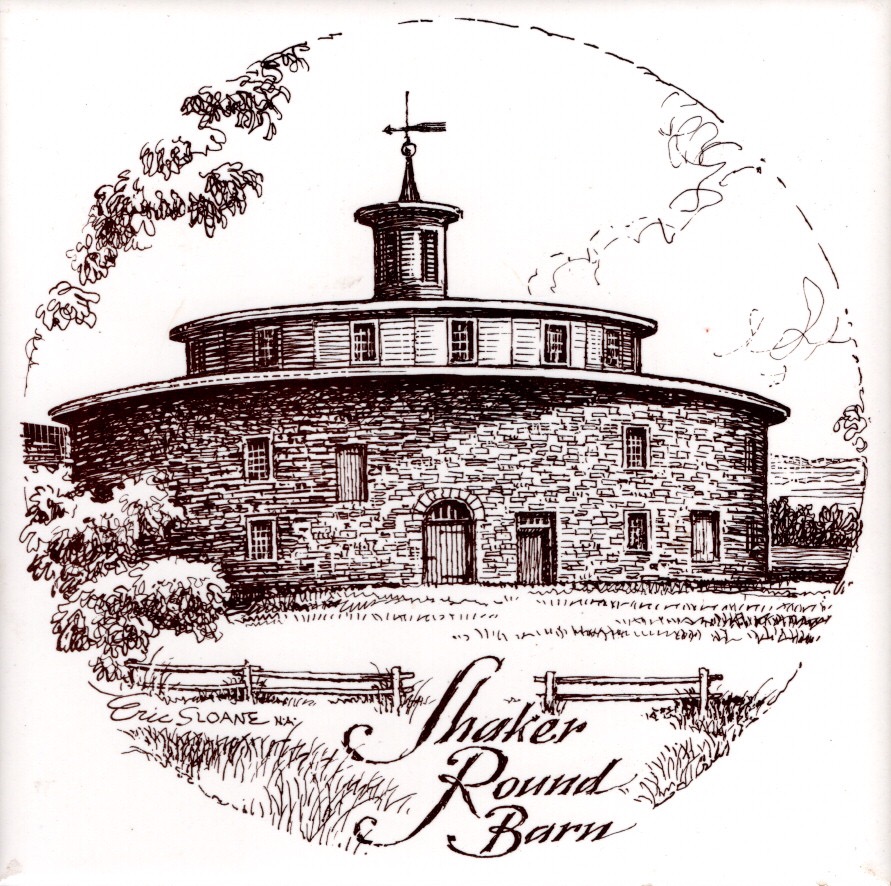
Eric Sloane’s Shaker Round Barn for Delano Studios
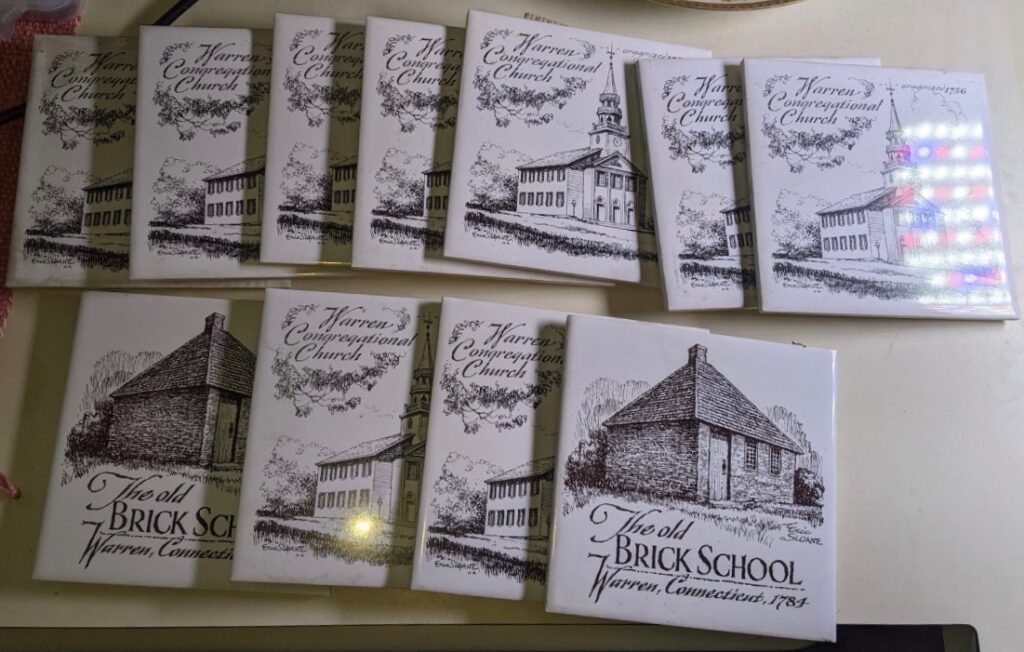
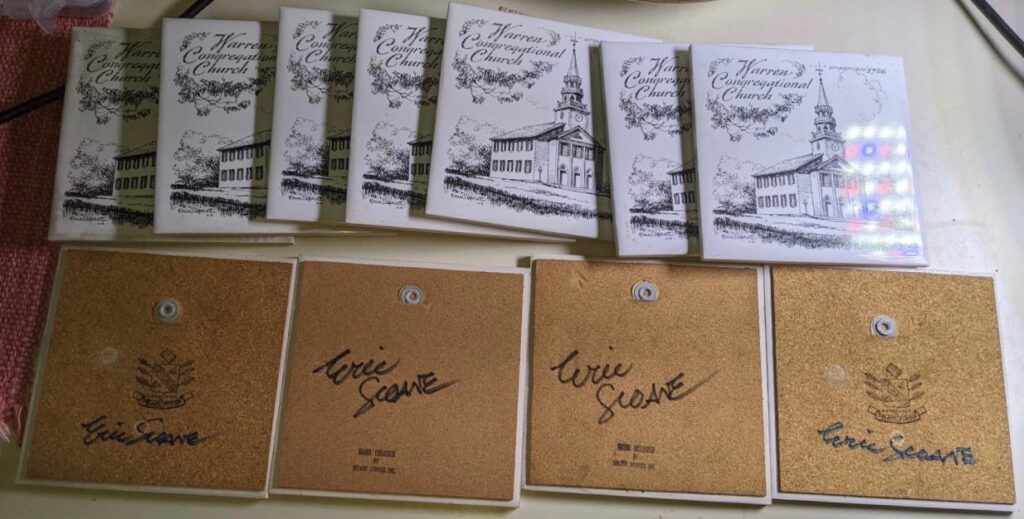
A set of as new tiles owned by my friend Sean Curtiss. Warren Congregational church (where Eric Sloane’s memorial service was held) and “The Old Brick School, Warren, Connecticut 1784”. Both Delano Studios tiles were created for fundraising purposes. An added bonus – Eric Sloane signed the verso of them all.
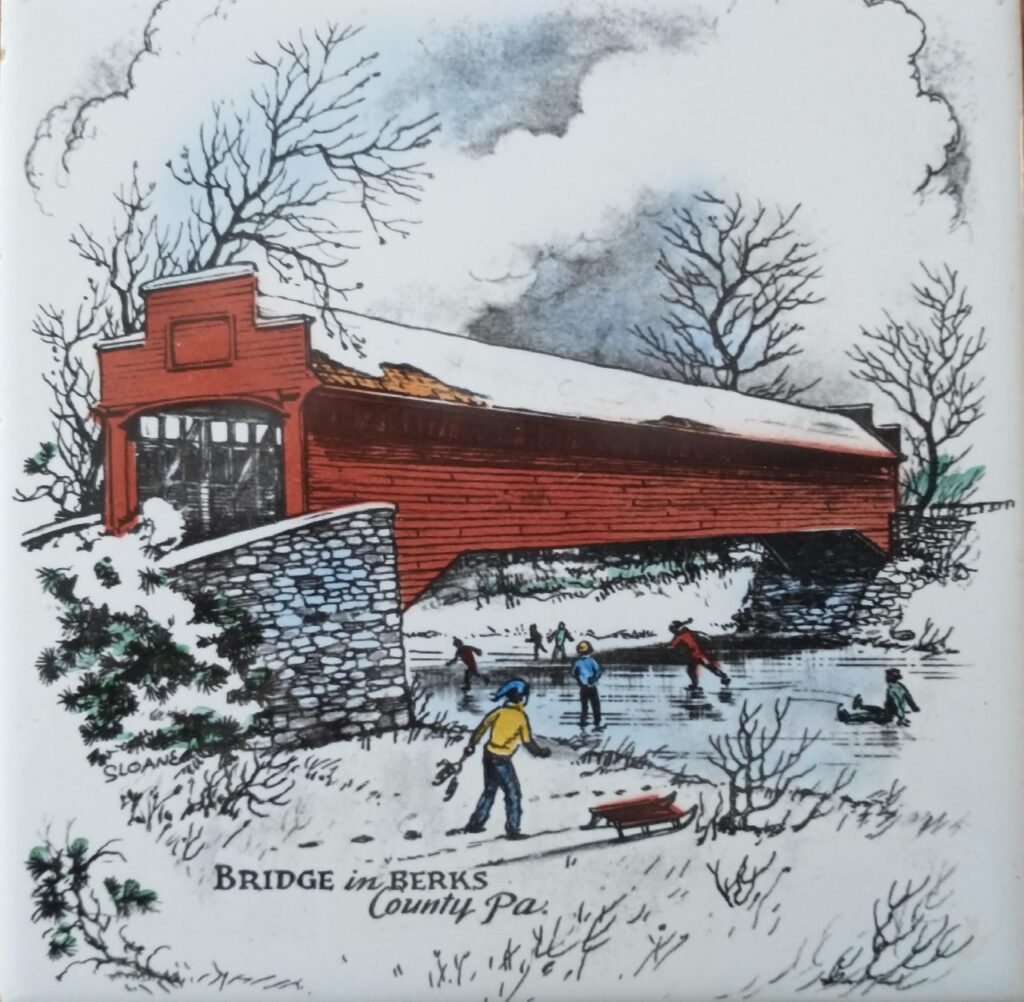
“Bridge in Berks County, PA” by Eric Sloane. I went through this bridge many, many times.
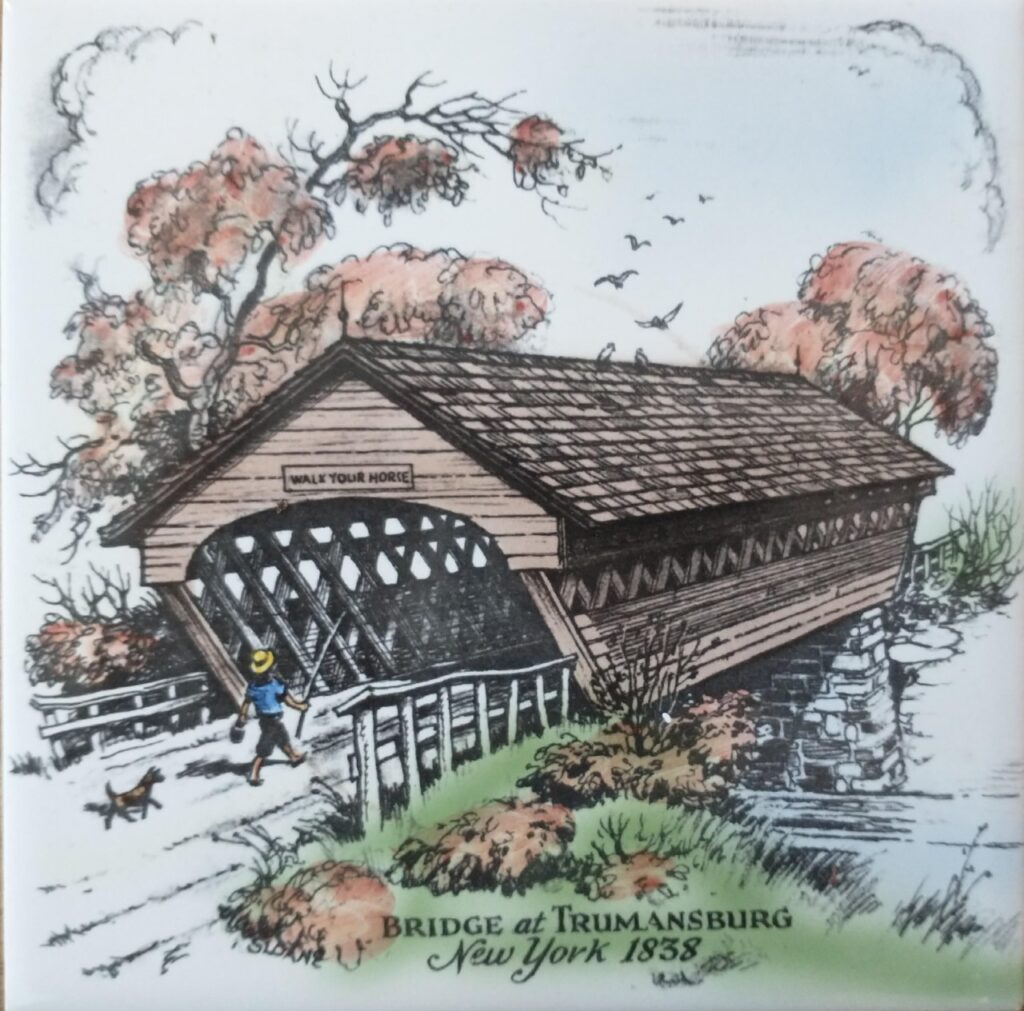
“Bridge at Trumansburg New York 1838”, by Eric Sloane
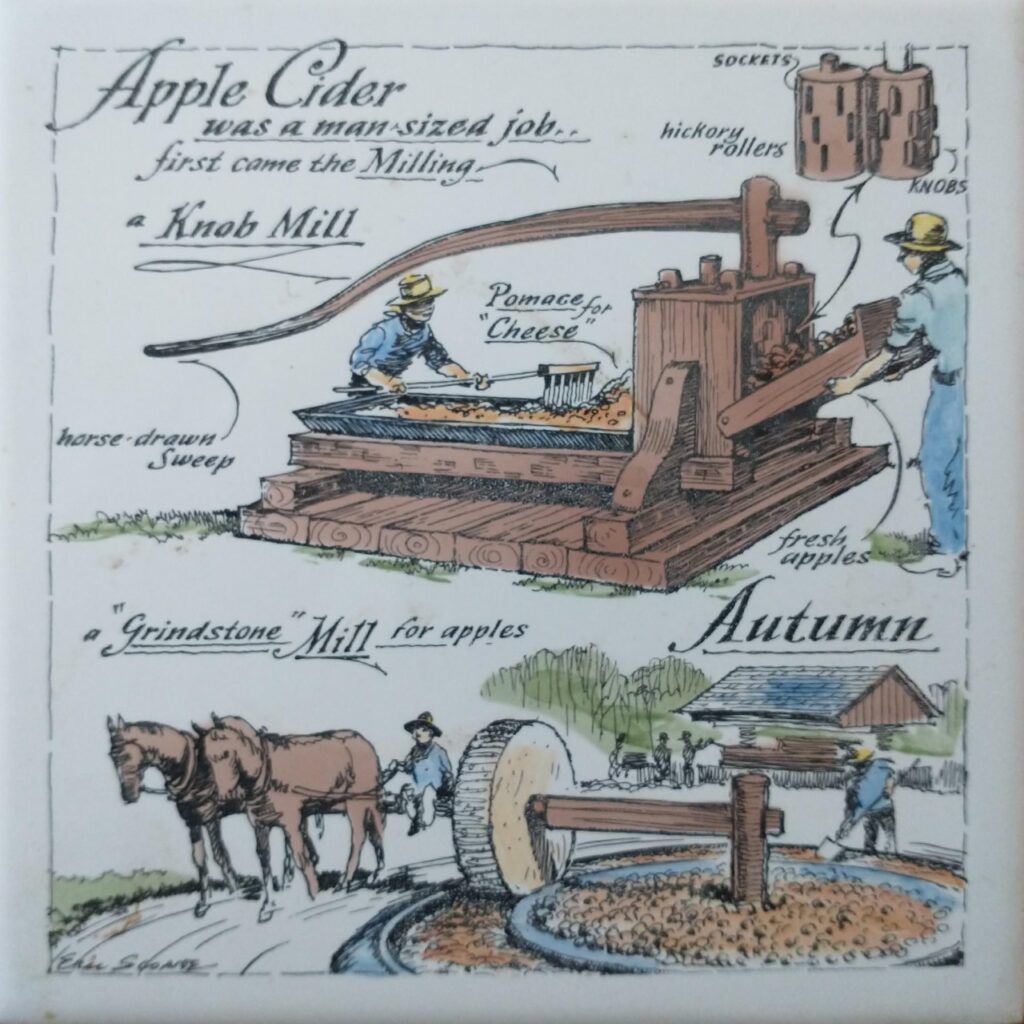
“Apple Cider was a man-sized job…” by Eric Sloane
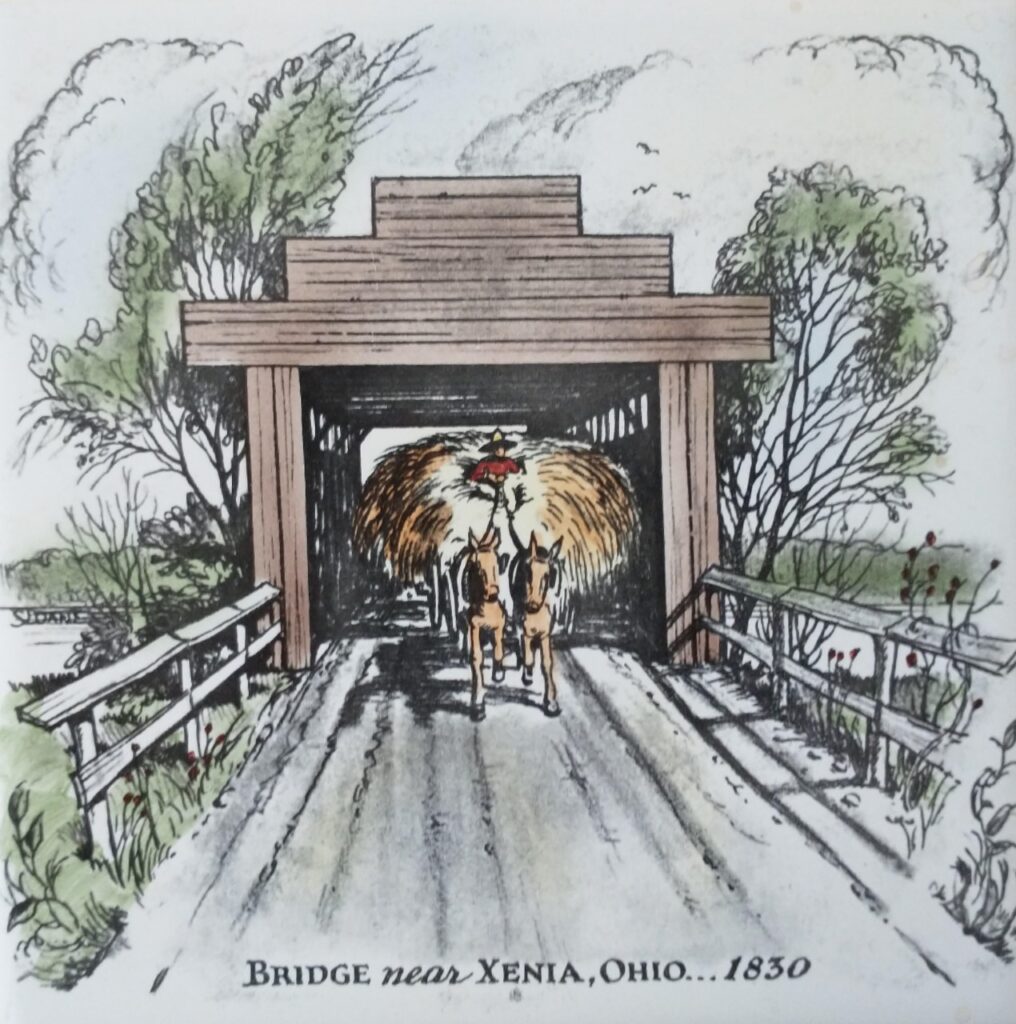
“Bridge near Xenia, Ohio…1830”, by Eric Sloane
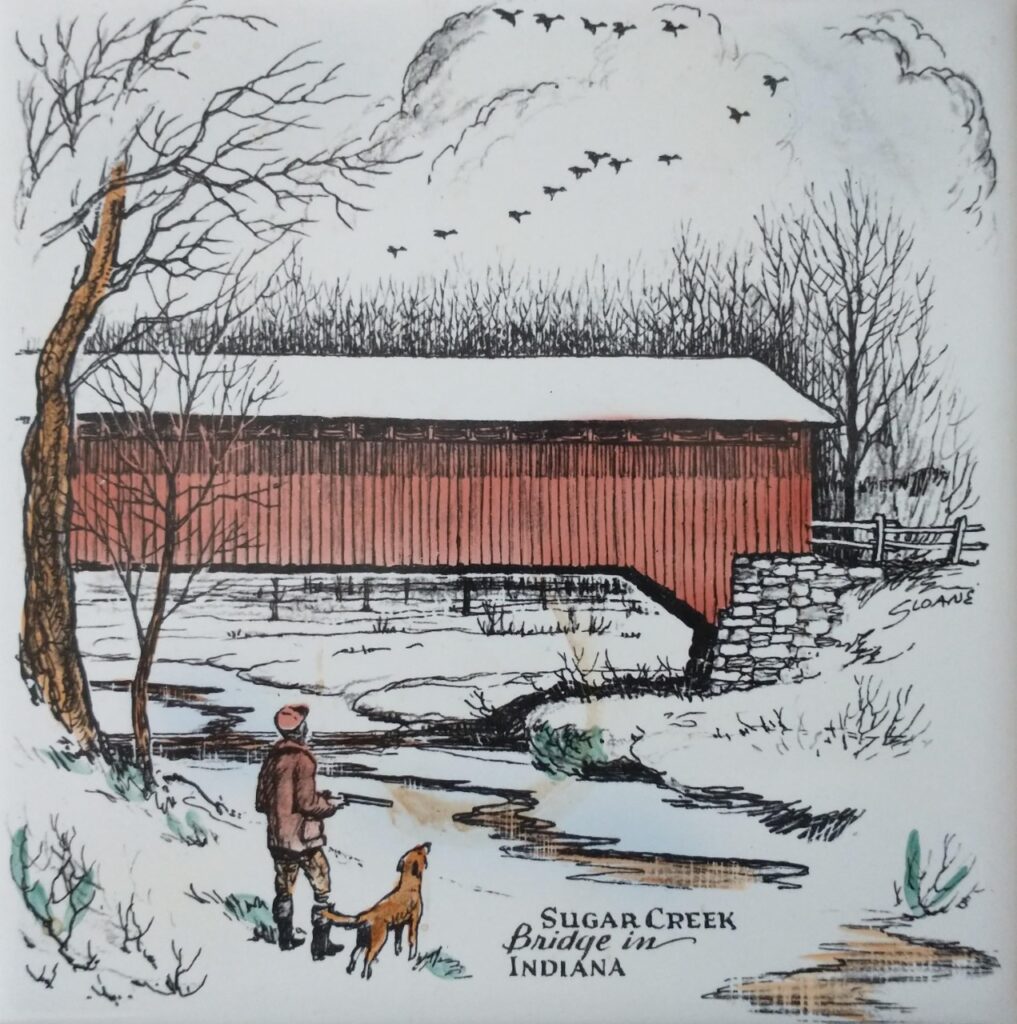
Sugar Creek Bridge in Indiana, by Eric Sloane
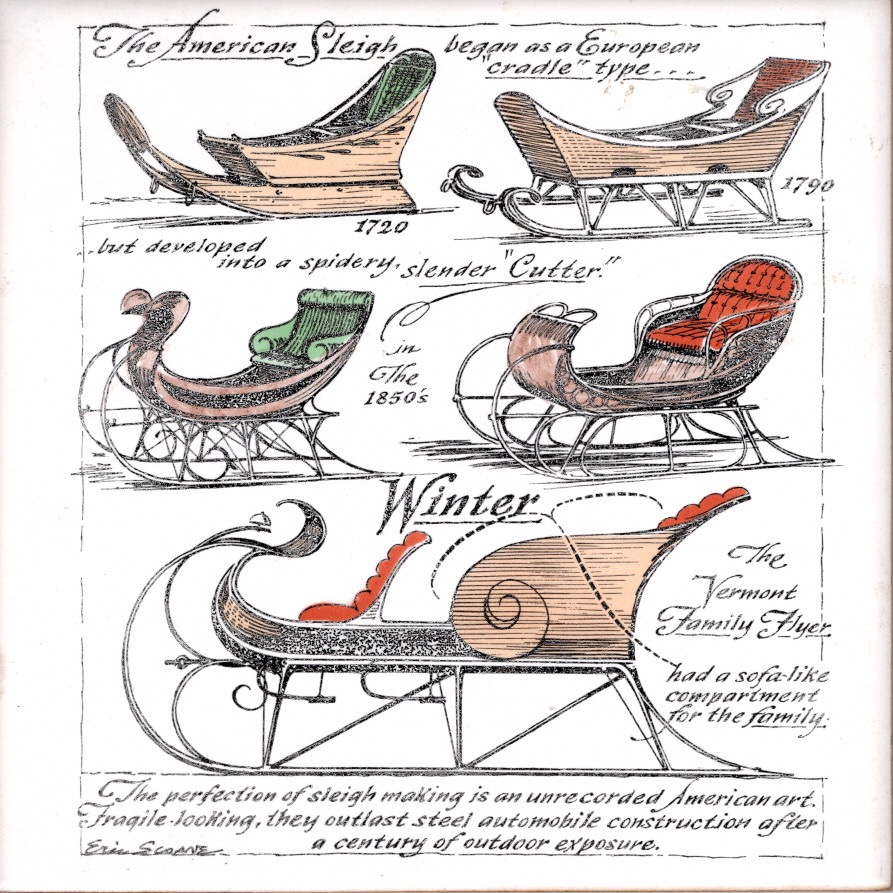
The American Sleigh by Eric Sloane
And here below is a unique item, an “Eric Sloane clock” that includes a Delano tile. The clock is a bit of a mystery. I’ve never seen another. It is possible it is a ‘one off’, or made in smaller quantities, or may even be a kind of kit, the builder deciding what kind of tile to put into the recessed wooden frame below the clock works. I can’t find a maker or any information anywhere on the piece. I’ve photographed the clock with a Delano Studios plate to the right that incorporates the same illustration, plus the framed original illustration to the left.
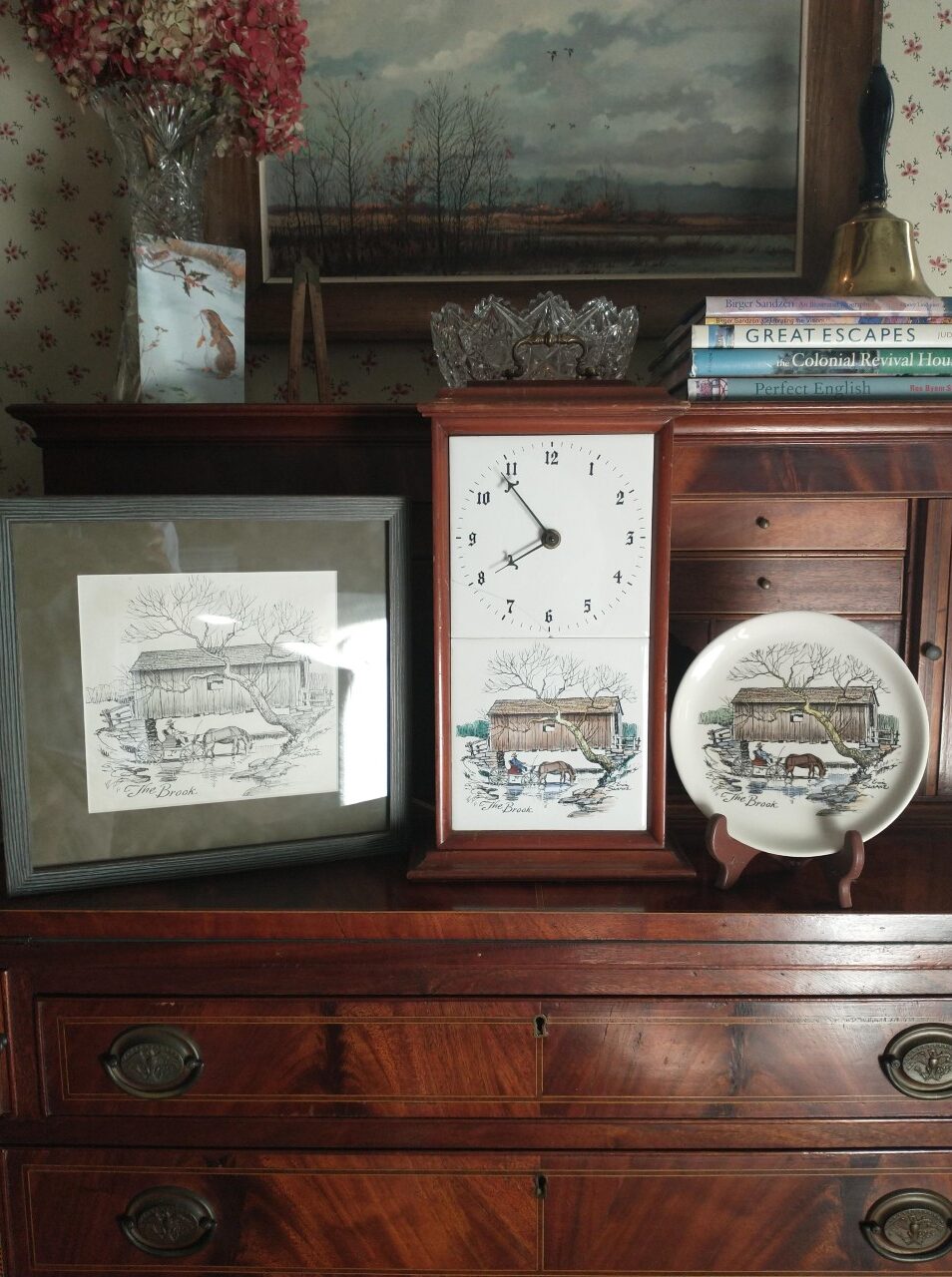
A note on the passing of Michael Collins (31 October 1930 – 28 April 2021), test pilot, major-general, and pilot of the Apollo 11 command module Columbia. Few outside the world of Eric Sloane will recognize this famous astronaut as the man who was instrumental in convincing Eric Sloane to paint the “Earth Flight Environment” mural in the Independence Avenue lobby of the Smithsonian Air and Space Museum. Collins served as director of the museum from 1971-1978. The following excerpt is from Aware, A Retrospective of the Life and Work of Eric Sloane:
The National Air and Space Museum of Washington, D.C. asked the artist if he would paint what the museum envisioned as a ‘very large mural’ for the entrance to the museum. The more the museum director diescribed the size of the mural, the more Sloane became intent on declining the offer. After he realized the director was not going to accept a rejection via telephone, Sloane reluctantly invited him to New York’s ‘Dutch Treat Club’, a famous haven for writers and painters of which Sloane was a member.
The museum sent a rather young representative (so thought Eric) who was introduced to Eric and the club members as Mr. Mike Collins. Collins and Sloane sat down for lunch, whereupon the artist began at once to attempt to convince Collins that he was simply too old to be fooling around on a large scaffold necessary to complete the mural. “Look here. I’m an old fellow not used to heights. Even at your age, would you enjoy working on so lofty a scaffold”? Collins, undaunted by the question, replied, “I really wouldn’t mind and I don’t mind heights. I guess you didn’t realize that I’ve been to the moon as an astronaut.” In his embarrassment at not recognizing a living legend, loan neglected to refuse the project.
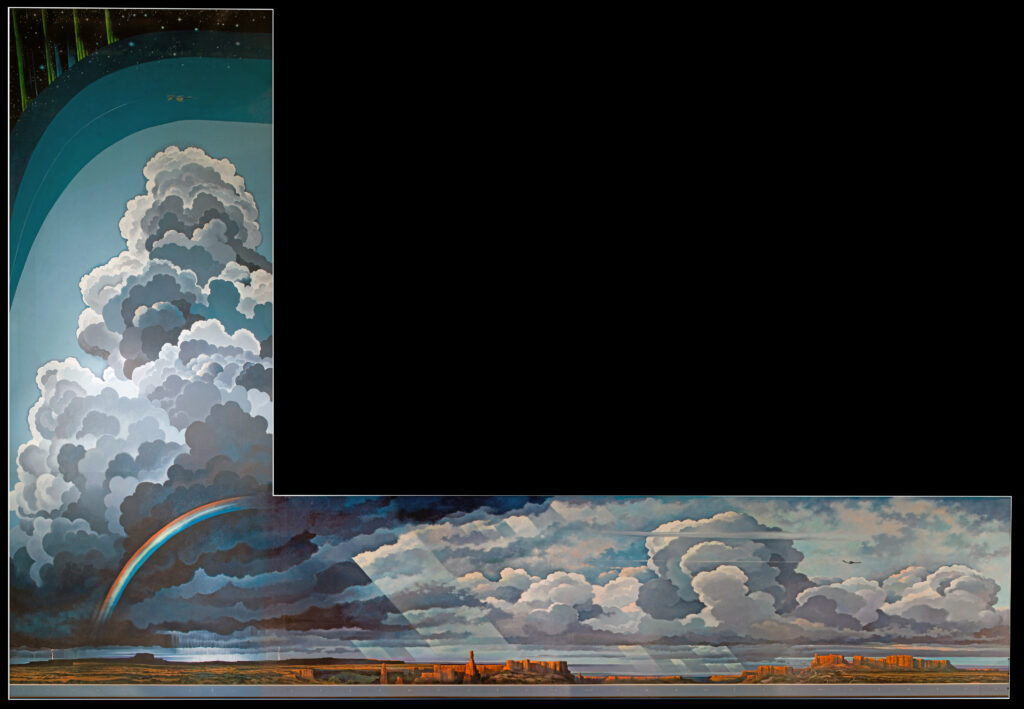
Full view of “Earth Flight Environment” (A19780167000) by Eric Sloane (1976), the L-shaped mural painting installed on the west wall of Gallery 108 (Independence Avenue Lobby) of the Smithsonian National Air and Space Museum (NASM), Washington, D.C. From Symbols of American Spirit: 50 Years of the Eric Sloane Museum by Wil Mauch. Photo courtesy of the Smithsonian Air and Space Museum.
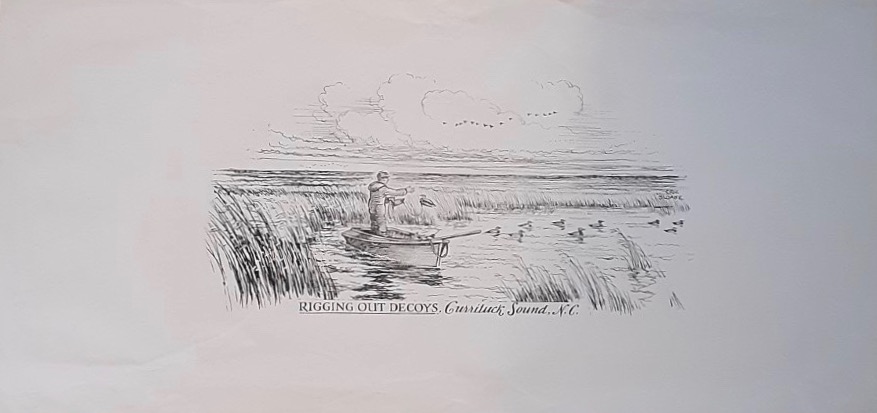
Eric Sloane created a series of pen and ink illustrations for use as lamp shades in a small project begun by his sister, Dorothy Hinrichs. These shades and the lamps to which they were attached were made some time in the 1950s. They probably were carried at Abercrombie & Fitch’s Madison Avenue, New York, store. The sixth floor of the establishment housed a bookstore an art gallery and a gift shop, Sloane’s sporting themed-work being offered in all three venues. They were definitely carried by “The Crossroad of Sport”, 15 East 54th Street, New York. Their 50 page catalog for 1954-1955 included two paintings by Eric Sloane – “”Lingaur Slopes, Austria – Skiing” for $425.00 and “Trout Fishing – The Smith Bridge Hole, Brandywine, Delaware” for $400.00 – and an entry concerning these lamps on page 47:
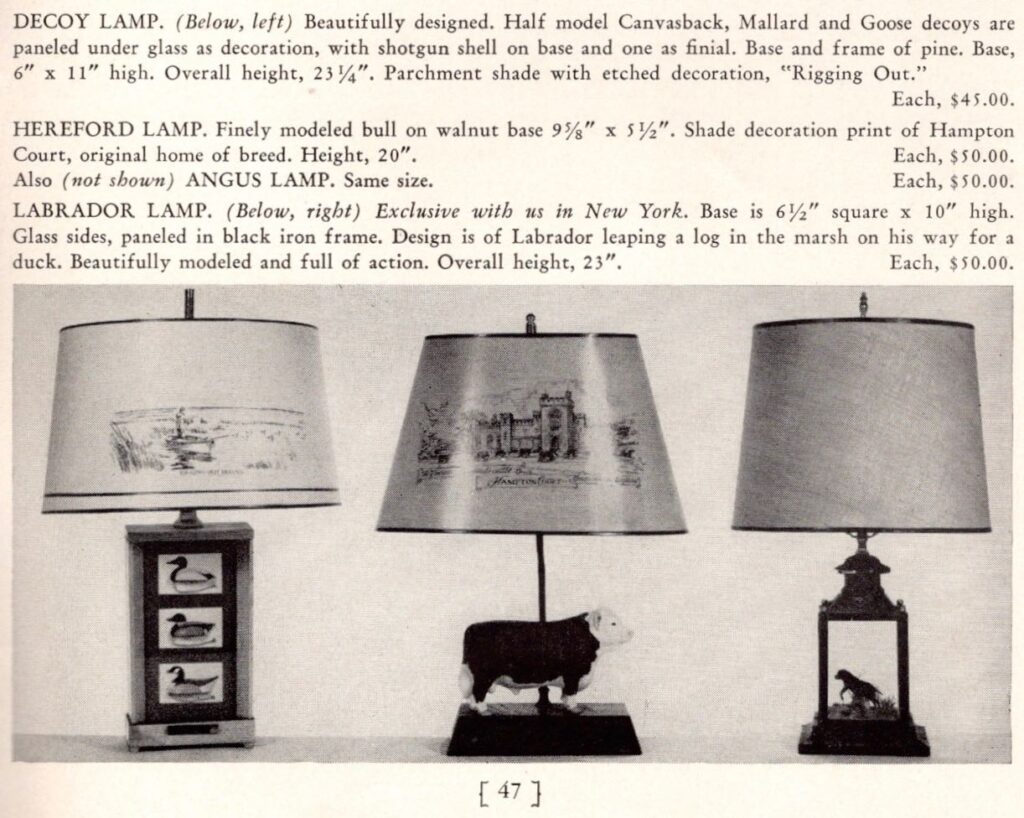
We have several of these illustrations obtained before they were formed into lamp shades. Rigging Out Decoys, Currituck Sound, N.C. by Eric Sloane (shown prior to being affixed and trimmed to a steel lampshade frame, photo prior to the one above and pictured at left as a fully formed lamp, above) is one. It measures 8.5″ tall x 15″ wide, 10.25″ tall x 16.75″ wide framed. Very uncommon print, but not a standard print. These were made to be attached to a round metal lampshade frame to become a functioning lampshade for a lamp that included a series of color illustrations of ducks (I believe they were drawn by Dorothy) as part of the lamp base. I’ve only seen one of these lamps in person, and that is in Eric’s recreated studio at The Eric Sloane Museum in Kent, Connecticut. The lampshade in the middle in the photograph above is Hampton Court in Herefordshire, England, birthplace of the Herefordshire cattle breed. The illustration below is of the shade paper prior to being affixed and trimmed on the steel lampshade form:
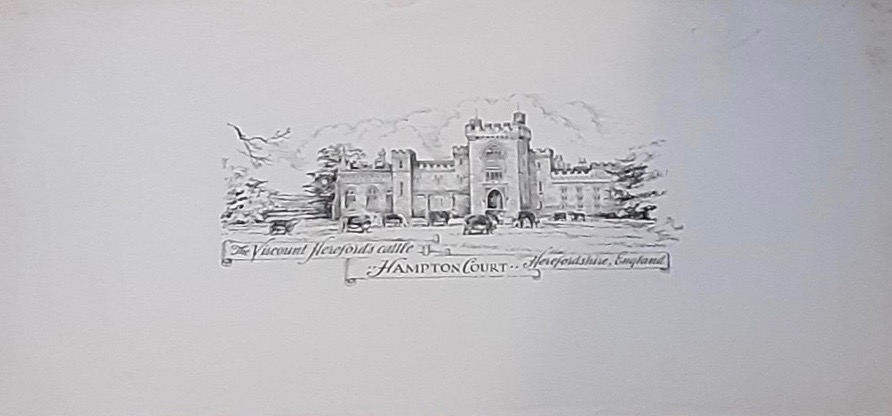
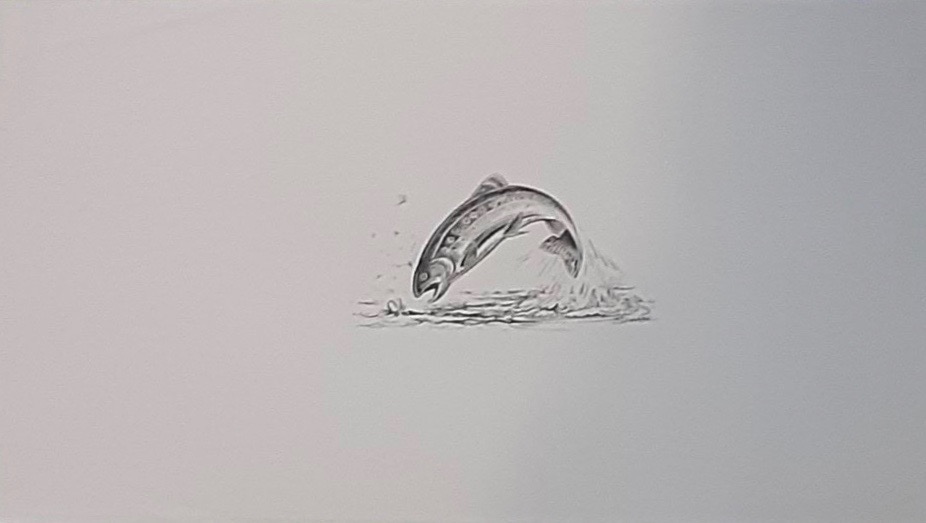
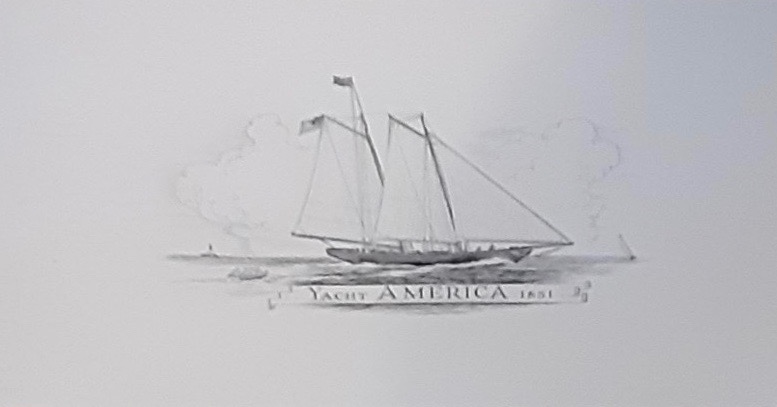
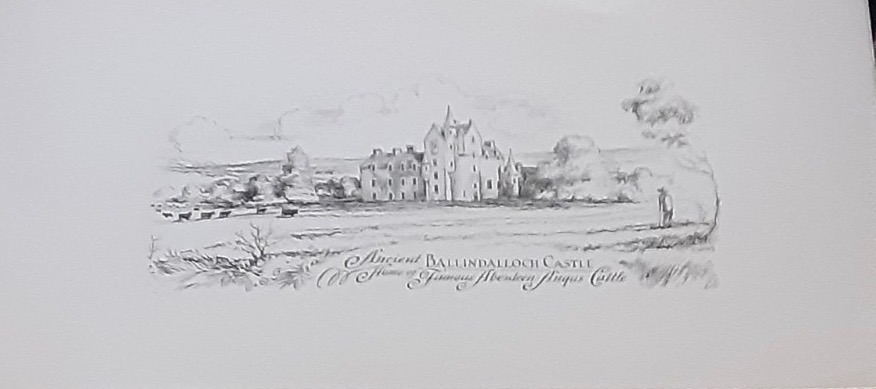
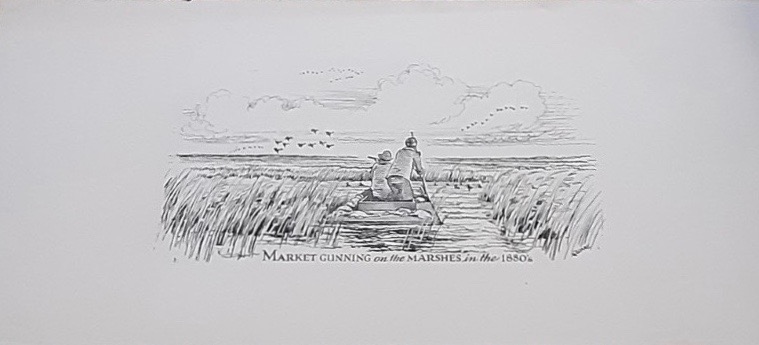
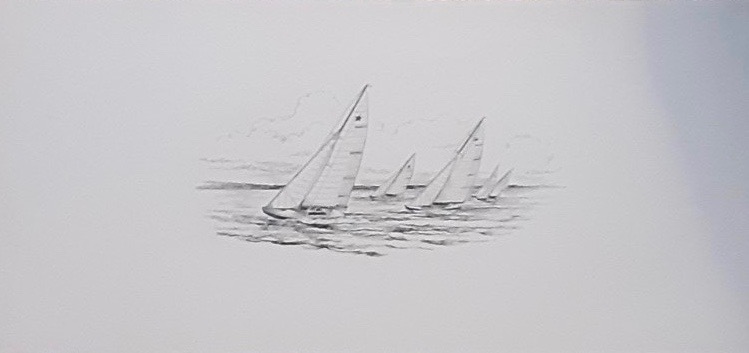
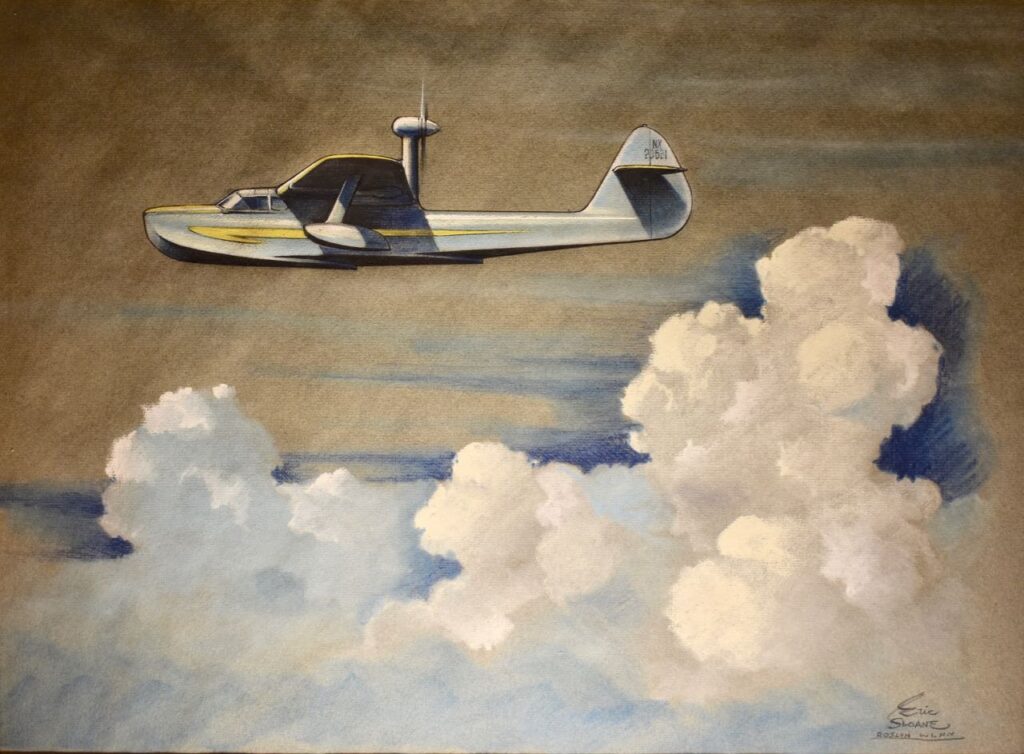
Eric Sloane, Untitled aircraft illustration. After some research, I discovered that this is a rendering of a Spencer-Larsen SL-12C, an aircraft that was completed in 1938 at the company’s Farmingdale, New York factory. It was test flown on and over Long Island Sound, departing and arriving in Port Washington, New York. Port Washington was the largest seaplane base in the United States, harboring most of the country’s “clipper” transatlantic amphibious aircraft. This Spencer-Larsen was built as an amphibious craft and the registration of NX20621 reveals that this is the one – and only – Spencer-Larsen SL-12C ever built. It was a design that was way ahead of it’s time, with many modern features including retractable landing gear. It did, however, prove to be a complicated machine, the test pilots reporting that it was not easy to control in certain situations. The Spencer-Larsen SL-12C also had some inherent engineering problems, which also relegated it to a curiosity which never saw active service.
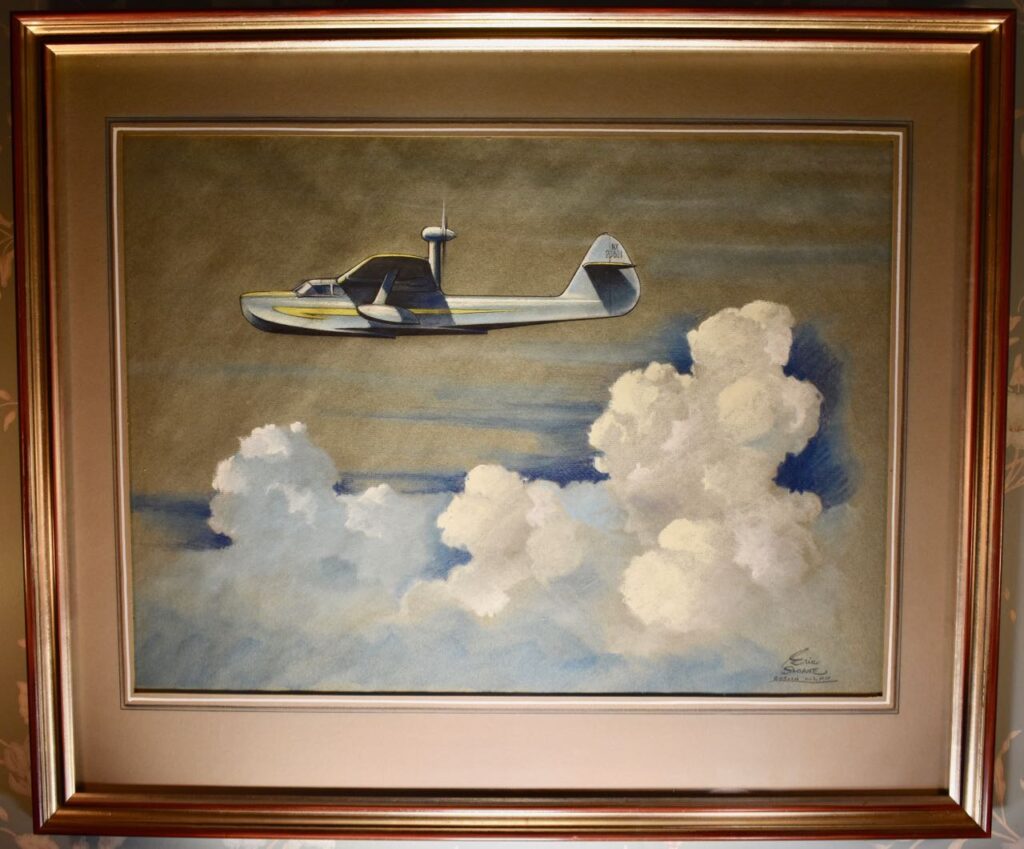
Why and how Eric Sloane came to illustrate this particular plane is a matter of speculation. Port Washington was less than 4 miles from Eric’s studio at the time, and less than 20 miles from the company’s headquarters. It is likely that Eric knew one or more of the original board members for the corporation and that the illustration was drawn for the company’s promotional purposes. The illustration is very well executed – the aircraft is very well rendered and there is some very nice colored pencil and pastel work in the clouds and the sky.
